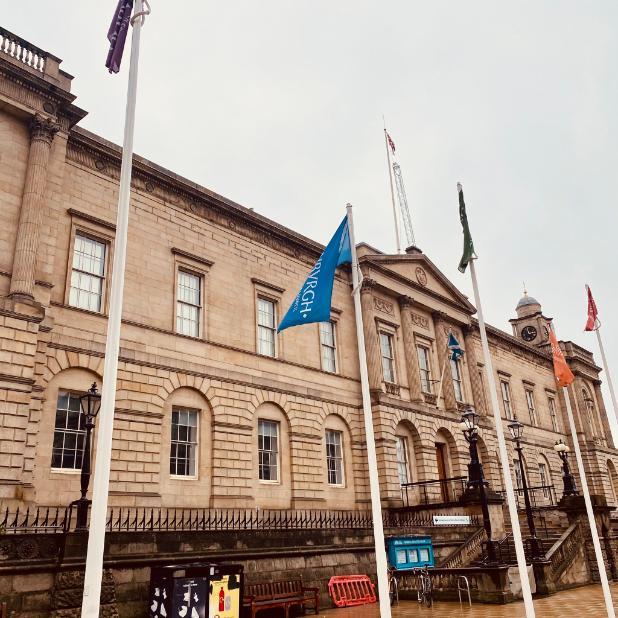Blog
We began our project blog in February 2018, one month after the research work commenced. You can find all the blog entries to date below.
Blog 53: 30 June 2023
Dear Ramsay Readers,
Alas, this will be the final project blog. We thought it would be fitting for Craig and me to co-write this blog, in the same manner as we have for previous entries. In this post, we will reflect on what The Collected Works of Allan Ramsay project has managed to achieve since work began with the Royal Society of Edinburgh project (2015), and then later by the Arts and Humanities Research Council (2018). Believe it or not, I was not involved in the RSE Ramsay project, so I will pass it to Craig to recap on the outcomes of that initial period.
Allan Ramsay and Edinburgh in the First Age of Enlightenment, Royal Society of Edinburgh
Thanks Brianna. Yes, this was such a crucial time for scoping out the possibilities of a Ramsay edition, and to get a sense of the research environment. Funding from the Royal Society of Edinburgh was granted in 2015 to Murray Pittock as PI, and I was appointed as a web developer to co-produce one of the proposed outputs: the interactive map of Edinburgh in Ramsay’s time. You can find the map, and more information about the project here. Ramsay was the ‘star player’ in this contextual research work, and over time the groundwork for the editing project was cemented. But the other important output here was Murray’s monograph Enlightenment in a Smart City: Edinburgh’s Civic Development, 1660-1750. I had only recently submitted my PhD thesis, so it was fascinating to see research being undertaken on Edinburgh’s social and cultural history, and how this could be fed into a monograph and a free interactive web resource. It was a good sign of things to come!
The Collected Works of Allan Ramsay, AHRC
Editions
The award from the AHRC (PI: Murray Pittock), allowed us to start work on the new edition of Ramsay from January 2018. If you go to the bottom of this page, you’ll see our first ever blog on 28 February 2018. The last – and only – modern effort to compile an edition of Ramsay was the Scottish Text Society work, which spanned thirty years. Important as it was, there was no unifying textual policy, and many gaps or errors in the textual record. We were therefore motivated to produce a readable and full edition with a clear policy. And we did! There will be six volumes in total.
The first four are available now:
- The Gentle Shepherd edited by Steve Newman and David McGuinness
- Poems: 1721 and 1728 edited by Rhona Brown
- Poems: Uncollected and Dubia edited by Rhona Brown
- The Tea-Table Miscellany edited by Murray Pittock and Brianna E. Robertson-Kirkland
Volumes 5 and 6 will be available next March:
- Prose edited by Rhona Brown and Craig Lamont
- The Ever Green edited by Murray Pittock and James J. Caudle
We have even received positive reviews for The Gentle Shepherd, one by Jane Pettegree and another by Paul Malgrati. We hope to see more reviews of all the editions in due course.
Music and Performance
A big part of the project involved realising the music both in the editions and in performance. While we worked to trace the tunes that Ramsay indicated for his songs, we also planned to perform these tunes by staging scenes from The Gentle Shepherd and performing a dance night at the Ramsay Festival in 2018. As we have discussed in the blog before, these tunes were used to accompany a variety of performances: fiddle tunes, dances, songs, and it was wonderful to be able to realise these differing performance modes. If you want to read back and find out more about the 20198 festival, please click here.
From there, we continued to hunt down the tunes for The Gentle Shepherd and later The Tea-Table Miscellany (with a bit of investigation into some of the tunes mentioned in Poems along the way). We also tested out difference voices performing the songs, thinking about the various singers who would have encountered this music. More live performances took place at the Allan Ramsay night at Sloans Ballroom. The concert is available to view in 3 separate YouTube videos:
Iona Fyfe, Alasdair Roberts & Concerto Caledonia - My Jo Janet
Iona Fyfe & Concerto Caledonia - Slighted Nansy
Iona Fyfe & Concerto Caledonia - Bonny Christy/A South Sea Sang
All this activity culminated in Shepherds and Tea-Tables, a historically led album that showcased a wealth of Ramsay material. The album is freely available to stream on all streaming platforms and on YouTube.
Special editions of journals
There have been two special editions dedicated to Ramsay, in the two leading Scottish journals.
The first is Scottish Literary Review vol. 10, no. 1, for Spring/Summer 2018. Edited by Murray Pittock, this issue contains essays by the editorial team and beyond. A link to the journal can be found here.
The second is Studies in Scottish Literature vol. 46, issue 2, published in 2020. Regularly edited by Patrick Scott and Tony Jarrells, this special issue was edited by Murray Pittock and Craig Lamont, and once again contained original scholarship by members of the project and our collaborating partners. A link to this journal is here.
Exhibition
We also put on a fabulous exhibition at the National Library of Scotland, which was due to run from 16 February until 16 May 2020. Unfortunately, due to the 2020 lockdowns, the exhibition was cut short, but when a door shuts a window opens. We had the opportunity to record the exhibition, and put it online, thus preserving it for future enthusiastic observers.
The exhibition included Ramsay's publications, including some of his broadsides, and letters to and about his son, also Allan Ramsay. It was exciting to be able to tell Ramsay's story in the exhibition and feature items important to his life, legacy, and cultural memory.
Teaching
Since starting on the Ramsay project, we have incorporated discussions on his songs into teaching. At the RCS, Brianna has included lectures and seminars on Ramsay in the BEd programme, where students are training to teaching music in Scottish high schools. Since introducing these lectures and seminars in 2019, the students have provided positive feedback stating that they have a more in-depth knowledge of music in 18th-century Scotland, and they feel their teaching is much more informed as a result.
We also had the opportunity to teach textual and musical editing at the SGSAH doctoral summer school programme this year. Craig, Brianna, and Rhona all used their work on Ramsay as a case study for how to appropriately edit 18th-century print and manuscript material. The doctoral students in attendance, likewise, provided positive feedback following the session. Indeed, there is the potential for expanding this session into a series in future.
What is coming in the future?
While this is the official end of the Ramsay project, we are still waiting for the final two volumes, Prose and The Ever Green to emerge in their final printed form. Those volumes should appear next year, and we will be sure to share that happy news on social media. We are also planning a book launch to celebrate the release of Poems and The Tea-Table Miscellany a little later this year. A Ramsay Scot Note is due to be published in the Autumn, as well as a few articles showcasing other aspects of Ramsay and his cultural legacy.
2025 marks the 300th anniversary of the publication of The Gentle Shepherd and there may be plans to mark this occasion. While such an event falls outside the timeline of The Collected Works of Allan Ramsay it is fitting that there is a new edition of both The Gentle Shepherd and The Tea-Table Miscellany is now available and can be used to support theatrical and musical performances.
Thank you, Ramsay readers, for supporting this work. It has been a pleasure sharing our work with you all for the last five years.
-BRK and CL
Blog 52: 23 June 2023
The celebrations just keep coming this month! At the very start of June, we announced the release of Poems, and now, just a few weeks later, we celebrate the release of The Tea-Table Miscellany edited by Murray Pittock, and me! Brianna Robertson-Kirkland. It is so wonderful to see this volume in print, especially since no other editor(s) had taken on the challenge.
Much like The Gentle Shepherd edited by Steve Newman and David McGuinness, The Tea-Table Miscellany includes a detailed examination of the musical archaeology for each of the songs, providing notation for the songs known to have been authored by Ramsay. I have spoken about the process for hunting down the songs in previous blogs. Needless to say, it was a complex task that yielded hundreds of results. Had I included all the musical material identified, the edition would have been multiple-volumes long and one does need to draw the line somewhere. After all, the volume, as it is, is already over 800-pages long, with the notes taking up almost half of the edition.
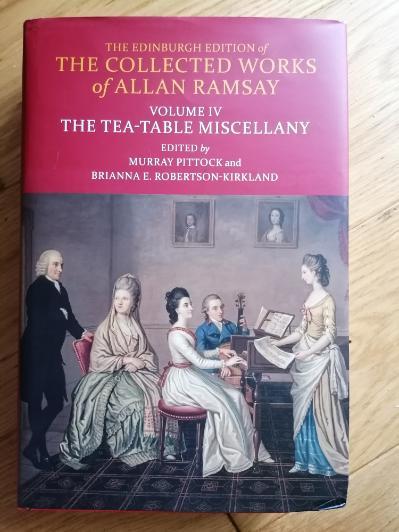
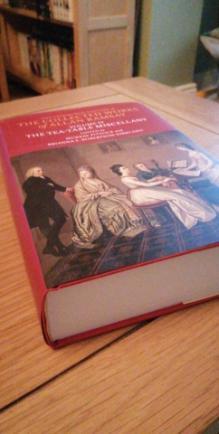
What this edition provides is a clear indication of where the musical material is and notation to be able to perform Ramsay-authored songs. And that is exactly what I am going to be encouraging my future students to do, particularly those who are in teacher training. I see the songs in The Tea-Table Miscellany as providing a creative way to engage with Scottish cultural, literary, and musical heritage allowing students, performers, scholars, and intrigued audiences, to see how these songs have emerged, and been preserved, popularised, and transformed over a period of 300 years. So far, I have discussed some of these songs in my teaching, but I have not been able to point students to a comprehensive volume that includes discussions on the origins of these songs. Often there is little to no recorded audio or accessible, printed visual evidence to reveal how these songs sound. Together, the new edition of The Tea-Table Miscellany and the new recording Shepherds and Tea-Tables fills this gap and provides a rich assortment of materials to allow interested audiences to see and hear Ramsay's songs, and indeed, give an idea as to the music that was in circulation in early 18th-century Scotland.
The Tea-Table Miscellany is now available to buy via the Edinburgh University Press website. If you belong to an institution, please encourage your libraries to purchase a physical and/or e-book copy! And remember that Shepherds and Tea-Tables is freely available to stream on multiple streaming platforms, including YouTube.
Our next blog will be the final one of the project, and we will be highlighting some of the many memories we have had working on this wonderful project.
Until next time…
-BRK
Blog 51: 9 June 2023
Dear Ramsay readers,
Can you believe that it was just last week when I posted the happy news that the new critical edition of Allan Ramsay's Poems, edited by our very own Rhona Brown, had finally been published? Well, now I write with even more good news: the sixth and final volume, The Ever Green, edited by Murray Pittock and James J. Caudle is now fully typeset and has been sent to Edinburgh University Press. As such, it marks the conclusion of The Collected Works of Allan Ramsay project, with all the editorial work complete one month ahead of schedule.
“But when will The Ever Green be published?” I hear you ask. The Ever Green alongside a new edition of Allan Ramsay’s Prose edited by Rhona Brown and Craig Lamont, will be published and available to sit next to the other four volumes in The Collected Works series at some point in 2024. Don’t worry. We will keep readers informed via social media when these final two editions are available for purchase.
It was my pleasure to be able to typeset this final volume. Unlike previous volumes that I have co-set with fellow RA Craig Lamont, who regular readers will know left the project late last year and is now a Lecturer in Scottish Studies, this time I was on my own. Previously, I was largely responsible for setting the music, but this time I was only setting text, and a few images (not as simple as one would think, especially when dealing with a complex text such as The Ever Green). However, I hope that when readers obtain a copy of this final volume they will be satisfied with its design and production overall.
The volume includes a beautiful new setting of both volumes of The Ever Green (1724), in a readable format that will be of interest to scholars and students investigating Scottish history, and literature. There are a few songs in there as well, though there is not an in-depth discussion of the music, since The Ever Green is not, strictly speaking, a song collection. For those of you unfamiliar with the complex history of The Ever Green, it is a collection of older textual material, authored by others and not by Ramsay. Indeed, Ramsay states explicitly in his preface that the material is mostly taken from the Bannatyne MS, a large folio manuscript from the 16th century. Ramsay has selected various poems to showcase Scottish verse, editing them together into two volumes to sell to an early eighteenth-century Edinburgh market. We are fortunate enough that the Bannatyne MS has survived history, and, as such, the volume editors have a unique insight into Ramsay’s editorial practices. Accompanying the new textual settings are detailed notes on each of the Poems found in The Ever Green. Of course, like the other volumes, a glossary of Scots terms, appendices, and an index will provide readers with all the tools they need to navigate and consume this wonderful volume.
While the whole team are sad to see the project come to a close, it is wonderful to see each volume published, and The Collected Works of Allan Ramsay series grow. At the end of this month, I will be posting our final blog, where we will be reflecting on the project as a whole and celebrating the release of The Tea-Table Miscellany, which is available for pre-order.
-BRK
Blog 50: 1 June 2023
It is our 50th blog post, and it is wonderful to be able to dedicate it to celebrating the release of Poems edited by our very own Rhona Brown. Released by Edinburgh University Press later this month, this new, 2-volume edition ‘Provides a definitive text of Ramsay’s poems in which uncollected works are presented chronologically for the first time’ (I quote here from the EUP website). Readers will be treated to detailed annotations that provide useful and insightful context on Ramsay’s poems, including those that have only recently been rediscovered.
I witnessed first-hand the immense amount of research that went into this new edition by both Rhona, and fellow research associate, Craig Lamont. Indeed, Craig has written several blogs documenting some of the research work on Poems including Blog 13, Blog 15, and Blog 21 (I include the links, in case readers are keen to look back and gain a little more insight into the research process).
So, what should readers expect from this 2-volume edition? Well, the detailed introduction outlines the production history of Poems 1721, including a thorough discussion on the ‘gather up’ edition of Poems printed c.1720. I am sure readers will be keen to read Rhona’s persuasive arguments as to why Poems (1721) was chosen as the copytext for this new 2023 edition. I’ll refrain from giving away too many spoilers here, but needless to say, the issue is rather complex, and the introduction does well to outline all of the various argumentative strands. Indeed, the new edition does not shy away from the bibliographic complexities of Ramsay’s work, and instead takes the opportunity to untangle its densely knotted publishing history.
The edition consists of Poems (1721), and Ramsay’s second collection, Poems (1728), all carefully typeset for modern readers. The 2 volumes also include several uncollected and unpublished poems, thus providing a more complete picture of Ramsay’s output. The notes, which provide a discussion on Ramsay’s marginalia and doodles, reveal his editorial process. There is also a glossary, and an index so it is easy to find any Poem a reader desires.
The new edition is available to order right now from Edinburgh University Press’s website if you want to get your hands on it, and here is what the two volumes look like:
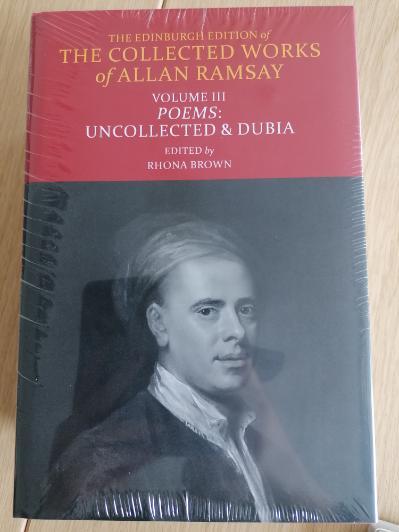
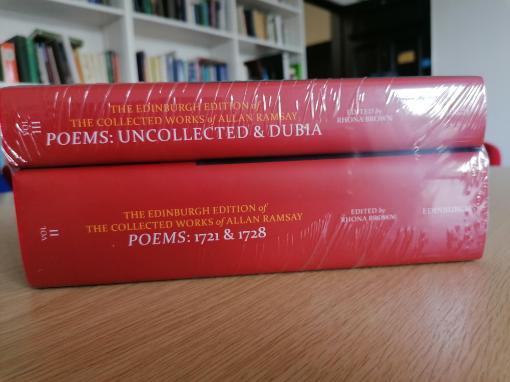
I am so pleased to see these 2 volumes joining Steve Newman and David McGuinness’s edition of The Gentle Shepherd, which was released last April. The volumes are sizeable, but they will not just adorn the bookshelves of enthusiastic Ramsay scholars. Rather, I imagine they will become a stable of undergraduate and graduate studies.
And it won’t be long until another volume joins The Collected Works of Allan Ramsay output. The new edition of Ramsay’s The Tea-Table Miscellany is set to be released in June this year and is also already available for pre-order. We are in the midst of planning a joint launch of both Poems and The Tea-Table Miscellany in the coming months.
That just leaves Prose, also edited by Rhona Brown and Craig Lamont, and The Ever Green edited by Murray Pittock and James Caudle. Both are currently in the typesetting phase and will be submitted to Edinburgh University Press in the next few months ahead of the project ending at the end of June. In next month’s blog, I will be discussing some of the work that has been done on The Ever Green and the typesetting process.
In the meantime, I wish you all a joyful Spring!
-BRK
Blog 49: 10 March 2023
Hello again Ramsay Readers,
It is my delight and pleasure to announce the release of Shepherds & Tea Tables: Songs of Allan Ramsay produced by our very own David McGuinness and his fabulous early music ensemble Concerto Caledonia. The recordings feature a variety of singers, namely, Seonaid Aitkin, Iona Fyfe, Mhairi Lawson, Alasdair Roberts, and Thomas Walker, who all have very different voices and styles of singing. Mhairi and Thomas perform repertoire from The Gentle Shepherd, and skilfully capture a sound suited to a professional theatre setting. Indeed, The Gentle Shepherd was performed in theatres all over Britain throughout the eighteenth and nineteenth centuries, including Tailor’s Hall, Haymarket, Drury Lane, and Lincoln’s Inn Fields.
I particularly recommend listening to ‘By thy delicious warmness of thy mouth’, a beautiful duet that also treats listeners to a segment of dialogue from Ramsay’s popular pastoral comedy. When David and I were digging through the sources, ‘By thy delicious warmness of thy mouth’ was one of the biggest head scratchers. There is no evidence that the tune or text (for the first half) existed before its appearance in The Gentle Shepherd. However, it concludes with ‘Sun, gallop down the westlin skies’, a tune that was in circulation. Stylistically and structurally, the song doesn’t look like it fits together, and yet, in performance, the song comes to life and perfectly captures Patie and Peggy’s relationship. Mhairi and Thomas have certainly done well to make the seemingly non-sensical come together with an elegant clarity. If you listen very carefully, you might even hear yours truly shouting ‘Peg-gee’ from the side lines!
Iona and Seonaid capture the spirit of ‘Auld Rob Morris’, performing it with appropriate sweetness edged with a little grit. I can just imagine the song performed at an evening’s gathering perhaps in one of the many early eighteenth-century Edinburgh coffee houses. Indeed, some of this repertoire was performed last year at Sloans Bar and Restaurant in Glasgow, which started as a coffee house in 1797. I wrote a blog about those performances in September 2022, where I also inserted video footage taken at the event. I include the links again below for anyone who missed them:
The first video is Iona Fyfe & Concerto Caledonia performing ‘Slighted Nansy’ from The Tea-Table Miscellany (1723):
https://www.youtube.com/watch?v=mFSZv6RN9Hk
Iona Fyfe, Alasdair Roberts, and Concerto Caledonia also performed ‘My Jo Janet’ also from The Tea-Table Miscellany (1723):
https://www.youtube.com/watch?v=XcR_SdBWvFs
Finally, Aaron McGregor (violin), Eric Thomas, (theorbo) and David McGuinness (harpsichord) performed ‘Bonny Christy’ before they were joined by Iona Fyfe, who sang ‘The South Sea Sang’:
https://www.youtube.com/watch?v=GrNihk-WkuM
Alasdair singing ‘Up in the Air’ is just wonderful. He seamlessly moves between the sober and jovial sections of the song.
There are also some beautiful instrumental only numbers including ‘Catharin Logie’ and John Clerk of Penicuik’s ‘Variations’ featuring Aaron McGregor on violin; ‘The Lass of Petties Mill’ featuring Alex McCartney on archlute; and ‘The Peer of Leith’, a solo harpsichord piece played by David McGuinness himself.
This is a fabulous recording from beginning to end (if I do say so myself), and it is now available to freely stream on all popular streaming platforms. I include the Smart Link below, which will allow keen listeners to find the album on Spotify, Apple Music (iTunes) and Deezer:
The album is also available to freely listen to on YouTube.
And, of course, you will be able to find the album links on this website under Ramsay’s Songs and Music, along with a lot of other fabulous resources.
If you would like to read the album booklet, which includes a lot of detailed notes and images, please visit the Concerto Caledonia website.
-BRK
Blog 48: 6 March 2023
Hello Ramsay readers,
It is lovely to return to write a blog for this wonderful project, after having commenced my new role as Lecturer in Scottish Studies here at Glasgow in September last year. I have been very busy writing new lectures, convening courses on Scottish culture for international students, and getting to know new colleagues and networks. In October 2022 I gave a talk on editing Scottish texts, showcasing some tricks of the trade from the Ramsay work to the 20th century, in the form of my new project on Dorothy K. Haynes. All this to say, my work on Ramsay – and Burns – has been crucial to my training as an editor, giving me the confidence to branch out to other textual hinterlands!
But, back to Ramsay. At BSECS in January 2023 I presented on behalf of my co-editor for Prose, Rhona Brown, on a Ramsay panel with Brianna and Murray. It was great to touch base again in that familiar setting with colleagues who I am very grateful to work with even in my new role. I am happy to report that Rhona and I are very nearly finished our editing of the Prose, and we will be toasting another volume being finished in a matter of weeks!
In previous blogs I have alluded to some of the standout letters, such as those from Ramsay to Andrew Millar, giving him permission to publish a London edition of The Tea-Table Miscellany. Well, there will be plenty more to enjoy. In total, there will be 78 letters, all by Ramsay, and the majority of those sent to Sir John Clerk of Penicuik (1676–1755). These can be found in the treasure trove of manuscript material in the National Records of Scotland (ref. MS GD18) by Ramsay, which we had already used as the source for many of the uncollected Poems, soon to be published in the coming weeks! Without giving too much away, it might be useful to offer a sense of what the letters contain.
There are a mixture of accounts, bills, gossip, formal petitions, joviality, and even reportage (Ramsay’s account of the Porteous Riot of 1736 being of particular interest). We can also use the letters to delve deeper into Ramsay’s growing pride for his son, whose movements and achievements in the art world are often commented on. So too does Ramsay’s sense of impending retiral become apparent, as we read about the development of Ramsay Lodge, the ‘Goose Pie’, during various stages of its construction. In the Introduction we also offer a sense of what is missing in the letters, i.e. those periods of time during which Ramsay either wrote nothing or, as is more likely the case, letters are lost or destroyed. It is telling that one of these periods of absence is during the ’45 and the fallout after Culloden. During this time, Ramsay stayed quiet, or perhaps even destroyed his letters? We can only speculate.
After the letters, our volume of Prose will consider two texts: the anonymous Some Few Hints, in Defence of Dramatical Entertainments (1728), and the ever-popular Collection of Scots Proverbs (1737). For the latter, we strongly encourage you to read the excellent essay by our friend and colleague Dr Ronnie Young, which can be found here. Then follows a series of miscellaneous prose by Ramsay, some print and some manuscript, including prefaces, dedications, reviews and notes on other works of literature. In an appendix we will include Ramsay’s rebus – or puzzle-letter – which he produced with Richard Cooper (1701–1764) and the text of the charter for St. Luke’s Academy of Art (1729), signed by Cooper, both Ramsay Snr. and Jnr., and many other early Enlightenment figures.
In all, this will be the fullest, and most reliable scholarly edition of Ramsay’s prose to date; collecting and collating his disparate prose, and using new scholarship to redate and better annotate the letters, most of which were published in the STS edition of Ramsay.
Looking back on this (often intense) period of research now, I take particular pride in tracing all (I think!) of the books Ramsay lists in his many bills sent to Clerk, some of which had proved illegible or too cryptic until now. My previous work on a Bibliography of Robert Burns, and indeed the ongoing descriptive bibliographical work on Ramsay, gave me the skills to use a range of digital and print sources to track down books in the eighteenth century. Many of these, of course, were not available to the STS editors, or indeed anyone before the internet became so widely accessible. Still, it is satisfying to annotate these lists and get a fuller picture of the print culture Ramsay was plugged into. I owe thanks to my colleague James Caudle for his suggestion that, for those book descriptions that proved too evasive, I might find answers in the Penicuik Library Catalogue. Indeed, this manuscript catalogue at the NLS did in fact yield the information we wanted: a good example of good communication paying dividends in a team project like this.
I think that about covers where we are – and what you can expect – with Prose. We will be sure to keep you up to date with the expected publication date. .
Thank you for reading!
-CL
Blog 47: 16 December 2022
Hello Ramsay Readers,
It is December and that means it is time for our annual Ramsay Round-Up. This year has been especially busy, so busy in fact, most of the team had their heads down working on the editions. With that in mind, I thought I would focus on key project highlights rather than giving a monthly recap on what the team have been working on.
Way back in January 2022, just as project PI, Professor Murray Pittock and I were working on the new Edinburgh edition of Ramsay’s Tea-Table Miscellany, my article ‘“Damage to Trees”: Performing Allan Ramsay’s The Gentle Shepherd at Haddington Grammar School’ was published in Theatre Notebook. I had been thinking about the early performances of Ramsay’s Gentle Shepherd since I started on the project in 2018, and I was delighted to see that work finally in print. The article is now available to read online, so if you are keen to know more about how a production of The Gentle Shepherd led to damaged trees and a fine, please check it out: https://www.muse.jhu.edu/article/850992. For the remainder of the winter, the Ramsay team were hard at work on researching the remaining editions and planning launch events celebrating the release of Drs Steve Newman and David McGuinness’s edition of The Gentle Shepherd.
One of the big outputs we had planned that was severely delayed as a result of the pandemic was recording a music album featuring songs from The Gentle Shepherd, The Tea-Table Miscellany, and tunes from Ramsay’s circle. Finally, after a two-year delay, and just as the long winter gave way to spring, a two-day recording session was organised in May. The musicians managed one day of that recording and then needed to delay again, this time due to a bout of sickness! Delay = Anticipation!
In June, we celebrated not one but two launches. The release of the new Edinburgh edition of The Gentle Shepherd and The Gentle Shepherd performance database, that provides detailed information on performances of Ramsay’s pastoral comedy from 1729 to the present. I had the pleasure of working on both the edition and the database and it was exhilarating to see them out in the public. If you have not purchased your copy of The Gentle Shepherd, it is available here. Likewise, the database is available here.
Of course, we had to celebrate The Gentle Shepherd with a launch, which took place at the National Portrait Gallery on 1 July. After two years of working mostly in isolation, it was wonderful to see friends and colleagues come together at the launch in support of the project. We captured some lovely photos of the launch, available to see here.
In August, we sent the final, completed manuscript for the new edition of The Tea-Table Miscellany to Edinburgh University Press. This is the first-ever scholarly edition of The Tea-Table Miscellany, and it provides a detailed examination of all 399 songs, including the origins of the tunes. Preparing this edition was a huge piece of work, and I cannot wait for it to be released. Indeed, it is already available for pre-order on the EUP website and is due to be released in June 2023.
In September, our team of musicians were finally able to come together for the final recording session. I attended that final session and was able to hear beautiful performances from Mhairi Lawson, Thomas Walker, Aaron McGregor, Alex McCartney, Lucia Capellaro, Hamish Napier and, of course, David McGuinness. The new album is called Shepherds & Tea-Tables and will be available next year. If you would like to see the cover art for it, please click here.
September also marked Craig Lamont’s departure as Research Associate on the project, though he remains as co-editor of Prose alongside Rhona Brown. In October and just in time for Ramsay’s birthday, we welcomed a new team member to the project: Dr Carol Baraniuk, who is currently working on the glossary for the new edition of The Ever Green edited by Professor Murray Pittock and Dr James Caudle.
In these final months of the year, the team have pushed ahead with their research work, and are getting ready to submit the final two editions to press in the New Year. 2022 has been an especially productive year, and it has been wonderful to see the first major project outputs released to the public. There is much more to come in the first half of 2023, and I will keep you updated every step of the way.
Thank you to all our readers and everyone who supports the project. Let me take this opportunity to wish you a very Happy Holidays and a Joyous New Year when it comes.
-BRK
Blog 46: 18 November 2022
In August this year, Dr John D. Halliday reached out to the Ramsay project team with some wonderful information on performances of The Gentle Shepherd that took place at Palnackie Schoolhouse in 1898 and 1899. These performances were produced by the ‘Palnackie Players’ or ‘Palnackie Comedians’, a group of local amateurs who regularly staged theatricals in their small port village, located in Kirkcudbrightshire, Dumfries and Galloway. Halliday mentioned that most of the cast were his relatives, including James Brydson Jr, Halliday’s Great Grandfather, who played none other than the Gentle Shepherd himself!
He was kind enough to send us both the original cast photo and a review of a performance published in the Galloway News and Kircudbrightshire Advertise on 6 January 1899. The performance took place on 28 December 1898. The review commented, ‘Pattie and Rodger, being already on the boards when the curtain rose, were greeted with a storm of applause, as their tall handsome figures in their smart rig out were revealed to the present in the room’. Indeed, we can see from the cast photo how splendid everyone looks in their costumes, particularly Patie (far left) and Roger (far right) standing proudly with their crooks.
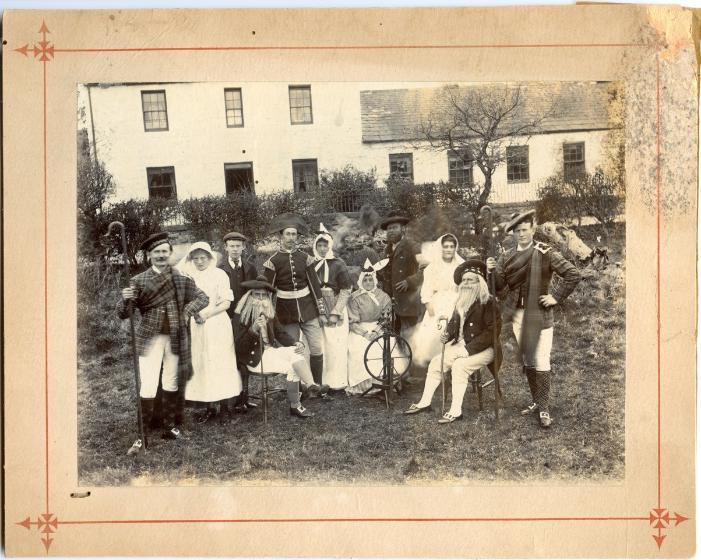
Caption: Original cast photo of the ‘Palnackie Players’ or ‘Palnackie Comedians’. Cast members are Mr James Brydson Jr, Miss Stitt, Mr W. Wilson, Mr J. Setvenson, Miss J. Johnstone, Mr R. Wright, Miss Halliday. Mr James Cannon, Mr James Thomson.
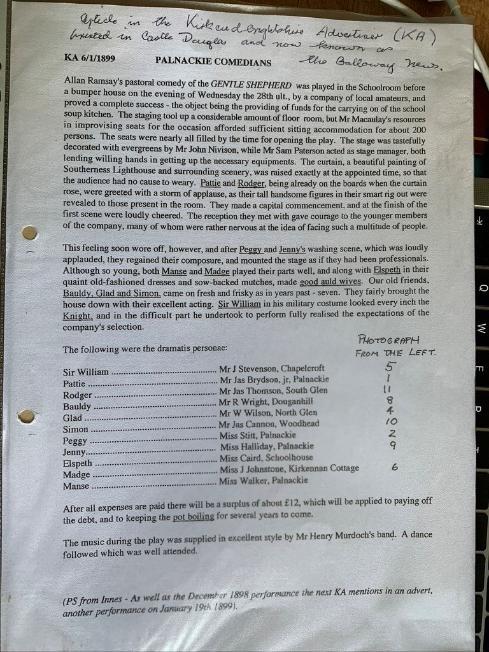
Caption: Review from Galloway News and Kircudbrightshire Advertise published 6 January 1899. Transcription by John D. Halliday’s father.
This performance was the ballad opera version of The Gentle Shepherd, as the review reveals that Henry Murdoch’s band supplied the music, which was ‘excellent[ly] style[d]’ and there was even a dance after the comedy concluded. Avid blog readers will remember that at the Ramsay Festival in 2018, we also staged scenes from The Gentle Shepherd, followed by a dance at the end. A dedicated dance event, where attendees were taught eighteenth-century dances also took place the evening before.
This was not the first time that The Gentle Shepherd was performed at Palnackie Schoolhouse. On 29 December 1891, a charity performance of The Gentle Shepherd took place with the proceeds noted to be ‘in aid of Soup Kitchen Fund’. It is unclear if the ‘Palnackie Players’ or ‘Palnackie Comedians’ were the troupe who performed it, however, an advertisement printed in the Galloway News and Kircudbrightshire Advertise on 25 December 1891 stated it was ‘Under the Patronage of the School Board of Buittle’. Clearly, The Gentle Shepherd was so popular with those living in the Palnackie area, it drew support from patrons and an audience.
There were also other performances that took place in the other villages located in the Dumfries and Galloway area in the 1890s. In 1889, another performance of The Gentle Shepherd was staged by an amateur theatre group called the ‘Carsphairn’ amateurs at the Schoolroom, Dallmellington. The review, also published in the Galloway News and Kircudbrightshire Advertise on 8 February 1889 noted:
‘The large room was densely packed, every inch of available standing room being occupied. Out national pastoral seems always able to draw an audience, and though old is ever fresh’.
162 years after its first known production, The Gentle Shepherd’s popularity remained popular with Scottish theatre troupes and audiences.
Many thanks to John D. Halliday for sending the wonderful image of his Great Grandfather and other relatives who performed the 1898 production of The Gentle Shepherd. Such an image is a treasured item that gives a unique insight into the fascinating history of Ramsay’s beloved pastoral comedy. The Ramsay Team have also produced a database of Gentle Shepherd performances, demonstrating the comedy’s popularity throughout the eighteenth and nineteenth centuries. Over the next few months, we will continue to update the database, so do check back, as there may be more performances added and plotted on the map.
-BRK
Blog 45: 29 October 2022
Auld Allan celebrated his 338th birthday on 15 October and while the team could not get together on the day to raise a glass in his memory, he has very much been at the forefront of our collective minds. Rhona Brown and Craig Lamont are working hard on Prose where they are transcribing and examining numerous Ramsay correspondence. General editor, Murray Pittock is co-editing the Evergreen with James Caudle and together they are pulling together a detailed examination of a rather complicated text. Indeed, I have the wonderful opportunity of setting the Evergreen ahead of its publication with Edinburgh University Press and I am so pleased to be one of the first to see this edition take its final form. David McGuinness has been working on the audio records and it is really starting to take shape. Indeed, we have a very exciting announcement!
The title for the new album of songs by Allan Ramsay is *drum roll* Shepherds & Tea-Tables due for release in early 2023. We even have an album cover that I am so pleased to share with you.
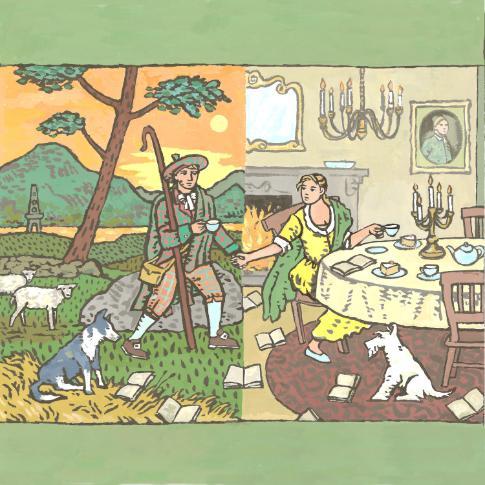
Figure 1: Shepherds & Tea-Tables. Music performed by Concerto Caledonia. Cover artwork by Joseph Davie.
The artwork is by Joseph Davie and features several Ramsay-related Easter eggs. Can you spot them all? Have a look at the background of the image. Of course, the Concerto Caledonia West Highland terrier is featured in the bottom right corner. Further details on the album are available on the Concerto Caledonia website, so do have a look.
We are also receiving a few enquiries from those who wish to perform The Gentle Shepherd in the next few years – a direct result of Steve Newman and David McGuinness’s edition. In 2025, The Gentle Shepherd will celebrate its 300th anniversary and, though the project will have concluded by then, seeing the play or ballad opera version of Ramsay’s pastoral comedy performed live would be an excellent post-project treat. We will be sure to update you on any performances we hear taking place before the end of the project in June 2023.
Finally, I am pleased to announce that we have a new Research Associate joining the project: Dr Carol Baraniuk. Carol is already very familiar with the Ramsay project, as she is currently Research Associate on the Editing Robert Burns for the 21st Century project. She has much experience in Scottish literature, Ulster-Scots literature, and British Romanticism, which will be so valuable as we prepare the final two editions for publication. Speaking for myself, though I have never had the opportunity to work directly with Carol, I have heard colleagues fondly speak of her. I am so pleased we finally get the chance to work together.
The team have plenty going on in the next few months, so do check back here for all the updates.
-BRK
Blog 44: 28 September 2022
Once again, campus is alive with the sound of students. The Ramsay team have also been involved in several activities throughout the month. I had the pleasure of attending the final Ramsay recording session, which took place at Crichton Church at the end of last month. David McGuinness, his ensemble, Concerto Caledonia and singers, Iona Fyfe, Mhairi Lawson, and Tom Walker are bringing songs from Ramsay’s The Gentle Shepherd and The Tea-Table Miscellany to life in a series of brand-new recordings.
On the final day of recordings, I was in aw hearing Mhairi and Tom singing ‘By thy delicious warmness of thy mouth’, a duet from The Gentle Shepherd that is quite unique. The duet was not styled in the same manner as most Ramsay’s other songs and duets but appeared to be a unique composition. I had studied the notes and structure of this duet many times before, but I couldn’t imagine how it musically fit in with the other songs in the ballad opera. To me, it always seemed to stand out as stylistically odd. Once I heard it performed, however, I know longer questioned its stylistic fit. It is the classic “lover’s duet” number that is still very common in musical theatre to this day. The pair sing their praises at each other for a few verses, before joining together in harmony to sing a catchier (an in the case of The Gentle Shepherd, recognisable) chorus.
There are also plenty of auld favourites as well. ‘The Yellow Hair’d Laddie’, which a particular favourite of mine to research, will feature on the record as well as instrumental numbers, ‘Katharine Oggie’ and ‘Bonny Christy’. Also joining the recording session was Luca Guariento and together we made sure to record some of the action for posterity.
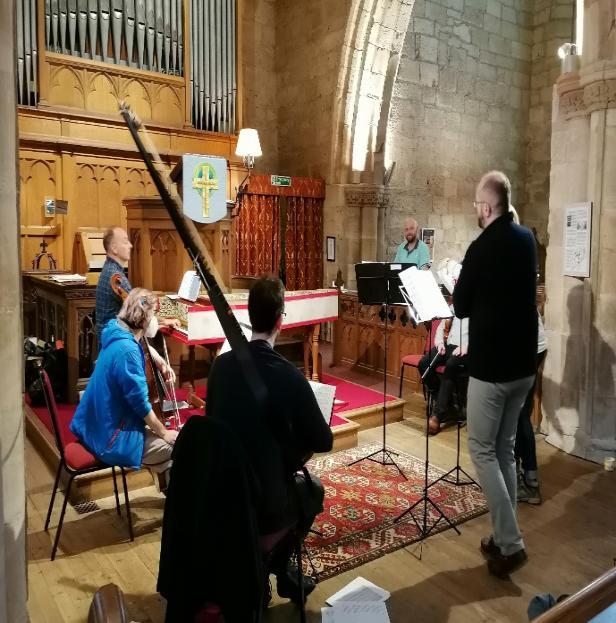
Figure 1: David McGuinness (Harpsichord), Lucia Capellaro, (cello), Alex McCartney (theorbo), Tom Walker (tenor), Mhairi Lawson (soprano), Hamish Napier (flute).
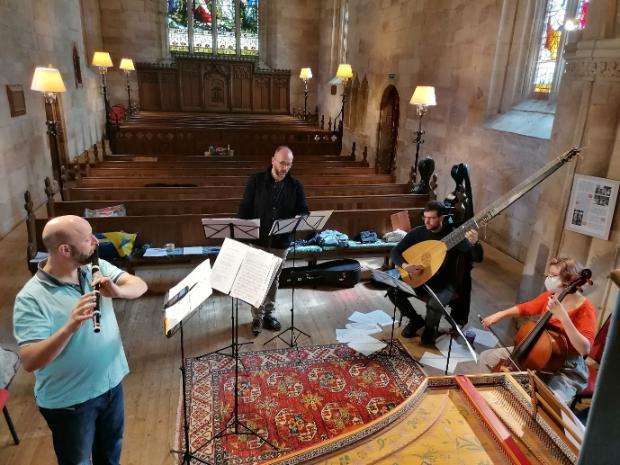
Figure 2: Figure 1: Hamish Napier (flute), Tom Walker (tenor), Alex McCartney (theorbo), Lucia Capellaro, (cello).
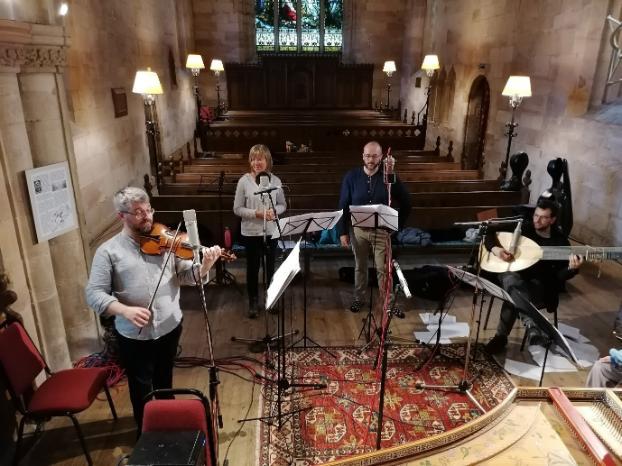
Figure 3: Aaron McGregor (violin), Mhairi Lawson (soprano), Tom Walker (tenor), Alex McCartney (theorbo).
Of course, the group are all very familiar with this repertoire, with Mhairi, Iona, Aaron and David having performed scenes from The Gentle Shepherd at the 2018 Ramsay Festival in Carlops. More recently, Concerto Caledonia along with Iona Fyfe performed some of Ramsay’s songs at Sloans Ballroom in Glasgow. Indeed, we have a treat for you as some of the songs performed at this event were filmed and released on the University of Glasgow Music YouTube channel.
The first video is Iona Fyfe & Concerto Caledonia performing ‘Slighted Nansy’ from The Tea-Table Miscellany (1723):
https://www.youtube.com/watch?v=mFSZv6RN9Hk
Iona Fyfe, Alasdair Roberts, and Concerto Caledonia also performed ‘My Jo Janet’ also from The Tea-Table Miscellany (1723):
https://www.youtube.com/watch?v=XcR_SdBWvFs
Finally, Aaron McGregor (violin), Eric Thomas, (theorbo) and David McGuinness (harpsichord) performed ‘Bonny Christy’ before they were joined by Iona Fyfe, who sang ‘The South Sea Sang’:
https://www.youtube.com/watch?v=GrNihk-WkuM
These videos provide a taste for the exciting Ramsay recordings that will be released toward the end of the project.
Alas, I finish the blog with some bittersweet news. The illustrious Craig Lamont, who has been my partner in crime composing these monthly blogs in addition to his many duties on the Ramsay project is leaving his role as Research Associate. But he remains at the University of Glasgow in his new role as Lecturer in Scottish Studies. He is also remaining on the Ramsay project as the co-editor of Prose along with Rhona Brown. Craig wants to record a final message to you all, so I say goodbye to you all and look out for next month’s blog where we celebrate Ramsay’s 337 birthday!
-BRK
I am feeling very buoyant, not only for being called ‘illustrious’ for the first time ever, but because the Ramsay project has been such an important part of my career and I am pleased to see it going so well. Thank you Brianna! I won’t take up too many seconds-worth of scrolling but I really do want to say a bunch of thank yous.
I started work on this project in January 2018, in conjunction with the similar work I was already doing on Burns since the summer of 2017. But the story runs deeper than this. I worked on a smaller contract from 2015 onwards, on the RSE-funded ‘Edinburgh’s Enlightenment 1680-1750’. Led, as the current project is, by Murray Pittock, this was my induction into Ramsay studies proper, and digital and spatial humanities too. For these opportunities, and for his role as my primary PhD supervisor, I owe a huge thanks to Murray – thank you! You have helped me with so many facets of my career and advised me on so many decisions in a world full of choice and consequence. It is a very fitting that I sign off from this project 10 years after beginning my PhD with you in September 2012…
Working with the editors, I already knew Rhona Brown very well and so working with her again on Poems was a naturally enjoyable exchange of ideas. Rhona line-managed me when I was temporary Lecturer in Robert Burns Studies in 2016-17, and has been a great friend for many years. Rhona, you have made me feel very at ease in the formidable world of Scottish Literature, and you have always been available during good times and bad. Thank you!
I also want to thank Steve Newman, we cracked lots of textual cases together and working with someone of his passion has been a great joy: it never feels like ‘work’ when we care so much about the end result. He is a serious scholar and a great friend: thank you Steve, for your leadership on Ramsay and your support throughout my career so far.
Although I had known of David McGuinness’s work for some time, I didn’t really get to know how talented and collegiate he was until the Ramsay project got going. His ear and skill in music from Ramsay’s period, and beyond, helped me understand this world of enlightenment and art so much better: thank you David.
James Caudle and I worked on Burns – as of course did Rhona – so this ‘bi-bardic’ exploration became more of a feature when James joined the team. During our time exchanging ideas about Ramsay’s Scots, his handwriting style, his quirks, and the necessity of Ruddiman as his printer, I gained lots of knowledge and intrigue about research methods and thinking generally outside the frame. Thank you Jim!
I’m deliberately leaving my serious thanks to Brianna until the end. I genuinely enjoy working with people: everyone on Burns, on Ramsay, in Scottish Literature and – before that – in Creative Writing have given me something that no-one else could have. But one of the best working relationships I have had has been with Brianna. We first met on the Hunterian Associates Programme in 2013. She would come in and out of view since then, on various song projects and recordings for Burns and other funded projects. Her CV and work ethic are simply incredible, and my time on Ramsay has been so enriched by working directly with her. Thank you Brianna: we have learned a lot about editing and publishing together, and so much more!
Thank you, reader, for indulging these personal remarks. I am now embedded in my role as Lecturer in Scottish Studies. I’ve swapper the Centre for Robert Burns Studies for the Centre for Scottish and Celtic Studies (though not really, as I’m still involved in Burns as an editor, and by inclination!). I will still be involved with Ramsay as an editor, as Brianna has said, on Prose, and I may make a reappearance for a blog or two at a later date. But this is a significant change in my career, and one that I could not have managed if not for this project and these people.
Signing off for now – CL
Blog 43: 23 August 2022
Hello avid readers. Once again, the Ramsay Team have had another extremely busy month. I am very happy to announce that the Edinburgh edition of the Tea-Table Miscellany is now with Edinburgh University Press. It is now being prepared for print and will be available to purchase next year. We will keep you all updated with its progress in due course. For now, I thought I would take the opportunity to discuss how fellow RA, Craig Lamont and I set this rather large volume.
In the Spring, the final text and notes were ready to be transformed from humble Word documents into a beautiful book. Just as was the case with The Gentle Shepherd, there were a lot of musical examples that needed to be exported from one computer programme and input into another. Essentially, the music is turned into an image file, and that means that as we are setting, we need to make sure the files are sitting in the right folder and are “linked” appropriately. The process doesn’t cause too much of a headache, but it does require some advanced planning to decide who sets each section and who produces the final output file. Fortunately, Craig and I already had a tried and tested method: he set the song texts and I set the notes with music. Easy!
Setting the notes and music, however, is quite a complex process. As I was working on it, I often thought about the reader’s experience and asked questions such as: will the reader be put off if they read the note and then must turn the page to look at the corresponding music? Am I causing too much or too little a gap if place notes and music side by side? What if someone wants to play the music? Is the font (music and text) big enough? Are the return spaces consistent? Is this consistent? Is that consistent? And so on… It takes quite a bit of time to ensure each individual page looks just right and that is before we even come to proofing!
Once the whole text is prepared, the whole document is exported as a PDF so that the editors (in this case, me, and our PI Murray Pittock) can proofread it and annotate any changes. Craig also carried out some really detailed proofing, just to make sure that everything was checked thoroughly. Even though Craig and I worked hard to neatly present the text and music, minor changes can throw everything out of balance. As such, after the necessary changes were made following proofing, both of us needed to take time to look back at the overall presentation and make more adjustments. It is really detailed and time-consuming work and on more than one occasion I found my eyes becoming agitated and itchy from staring at the computer screen too long. But it is also really satisfying to see the volume take its final form.
Finally, we were at the point of exporting the final document, but this was a little trickier than we envisaged. The final text file needs to be exported at the highest quality possible so that it prints nicely, but there are so many musical examples that the final file is rather large. 17 GB to be exact! Not only does this take up a lot of space on a computer, but it also makes it difficult to send to other computers. Craig and I experimented with a few different export options to create a smaller file, of similar quality. Working together, we managed to solve the issue a produce a high-quality file that could be more easily transferred and not take up so much space. It wasn’t exactly a smooth sail to the finish line, but we got there in the end. I cannot wait to see it in print in 2023.
Never fear! Though the Tea-Table Miscellany is off to press, the Ramsay Team still have plenty to do. Just yesterday, brand new material has appeared in our inbox on more Gentle Shepherd performances. We will be updating the database in the next couple of months, so watch this space for more details! David McGuinness is also working on recordings of songs from The Gentle Shepherd and the Tea-Table Miscellany, and I am so excited to be able to listen in on one of the recording days this coming Monday (29th).
And we still have two editorial teams: Craig and Rhona Brown, and Murray and James Caudle, working on the final two volumes of The Collected Works of Allan Ramsay, which will be ready for setting in the coming months. As always, we will continue to keep you up to date with all our activities.
-BRK
Blog 42: 12 July 2022
July has been a month of celebration so far, as we have taken every opportunity to mark the launch of our first volume, The Gentle Shepherd.
We started with an evening event at the Scottish National Gallery on 1 July. Scottish National Galleries are one of our Knowledge Exchange partners, and you can read more about our work with there here.
The space for the launch could not have been more fitting: we were in direct sight of one of Ramsay junior’s famous portraits, and Sir George Chalmers’s A Shepherdess Spied upon in a Landscape (1760), on which we will discuss more later this year.
With speeches from the General Editor and project leader, Prof Murray Pittock, co-editor Prof Steve Newman, and Dr Brianna E Robertson-Kirkland (standing in for co-editor Dr David McGuinness), our guests were offered an overview of the importance of his new volume, and what to expect next with our forthcoming books.
Our friend Alistair Heather, who was invited as a guest, took some great photos of the evening, which we are happy to share with you below:
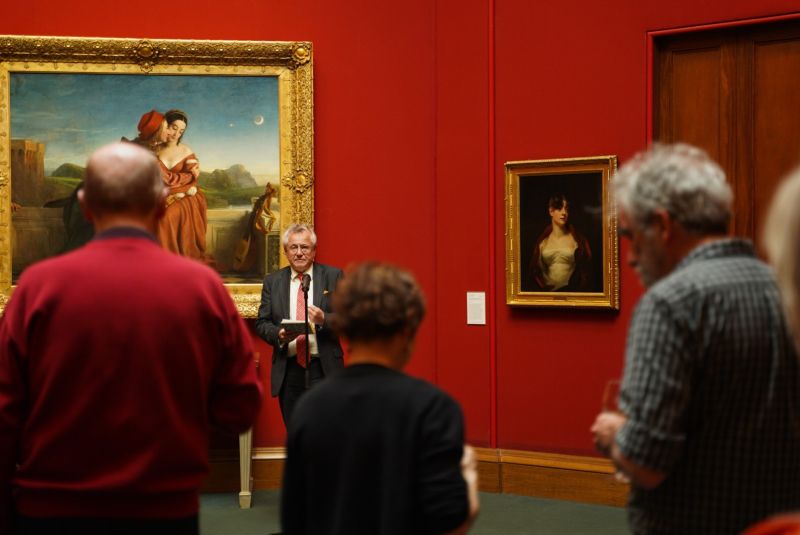
Prof Murray Pittock introducing the new volume
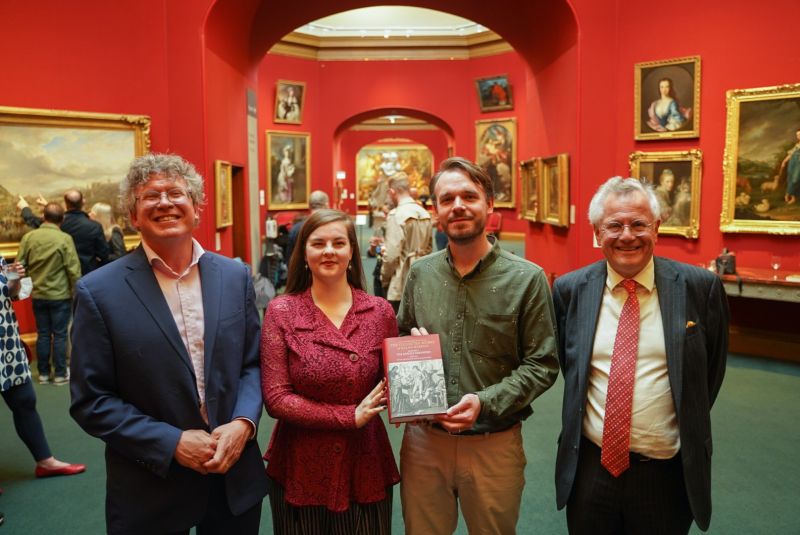
L-R: Steve Newman, Brianna E Robertson-Kirkland, Craig Lamont, Murray Pittock
On 5 July we were welcomed into Dr Bill Zachs’s exhibition space for another launch. Bill has been a friend of the edition since its inception. Indeed, we marked the beginning of the project in 2016, with an event in the same space to mark our intentions to produce the work with Edinburgh University Press. Six years, and just over £1M (FEC, Arts and Humanities Research Council) later, the project is in full flow. One volume on the shelf, another three in production, with two more to complete the set.
Over the last few months we have provided lots of information about The Gentle Shepherd, and it is very exciting to be able to see it in print after years of hard work and collaboration. But if you want to read about it from the point of view of the editors themselves, why not check out their own blogs? Published by Edinburgh University Press to mark this important milestone, you can find them here:
- David McGuinness, ‘How I came to make an edition of an imaginary musical text’
- Steve Newman, ‘Why You Should Read Allan Ramsay’s The Gentle Shepherd'
To supplement the new volume, we have also released a new interactive page on our website. Under ‘Performances’ you can find a Timeline, Map, and Table of Gentle Shepherd performances from the eighteenth century to the present day. At present, the data is very full, but the map itself has only a portion of entries. We are currently working to expand this, so that every known performance of the play can be mapped.
With this, and the book now available, we turn our attention to filling that Ramsay shelf with the forthcoming volumes. They are:
I: The Gentle Shepherd eds. Steve Newman and David McGuinness [available]
II: Poems: 1721 & 1728 ed. Rhona Brown [in press]
III: Poems: Uncollected & Dubia ed. Rhona Brown [in press]
IV: The Tea-Table Miscellany eds. Murray Pittock and Brianna E Robertson-Kirkland [final production stage]
V: Prose eds. Rhona Brown and Craig Lamont [underway]
VI: The Ever-Green eds. Murray Pittock and James J. Caudle [underway]
We are also striving to produce even more digital resources, including a digital bibliography and song recordings. So please do stay tuned!
CL
Blog 41: 8 June 2022
Hello Readers,
It may be Jubilee weekend, but the Ramsay team are celebrating the release of the very first volume in The Collected Works for Allan Ramsay: The Gentle Shepherd, edited by Steve Newman and David McGuinness. This is a beautifully, beefy edition produced by Edinburgh University Press that provides the most comprehensive and detailed examination of one of Ramsay’s most popular works. The play turned ballad opera, earned Ramsay both life-long and international success with performances of it taking place throughout the eighteenth, nineteenth and twentieth centuries with more recent productions taking place in 2016 and 2018.
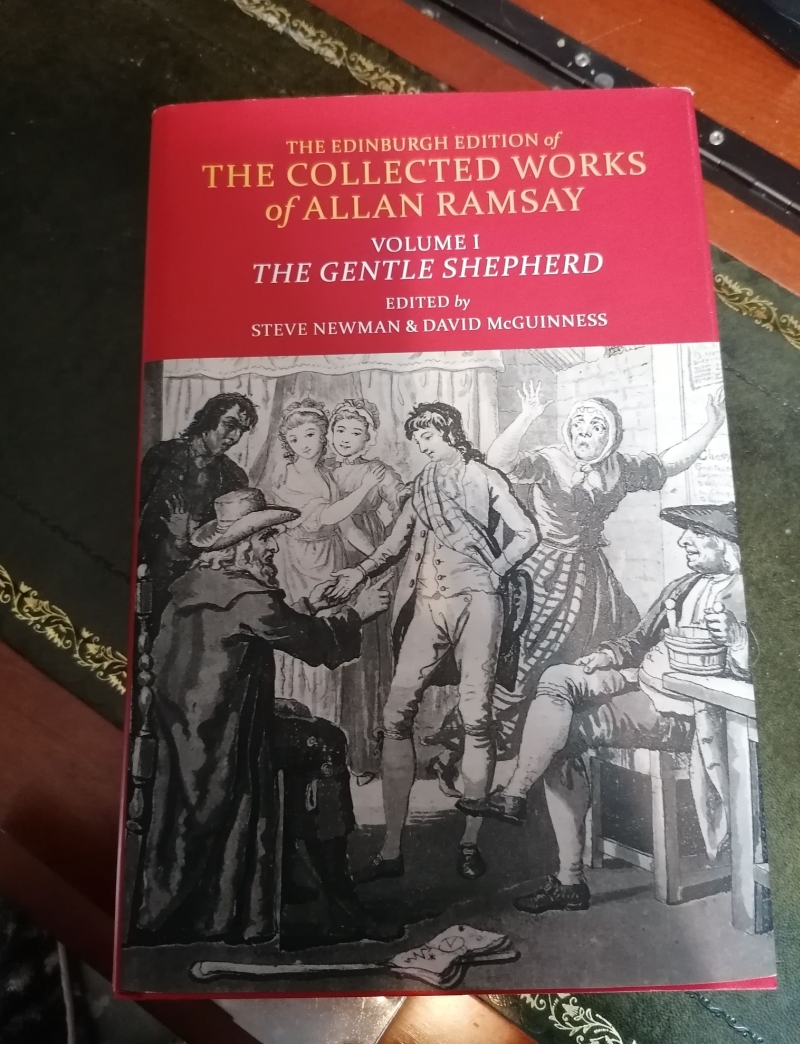
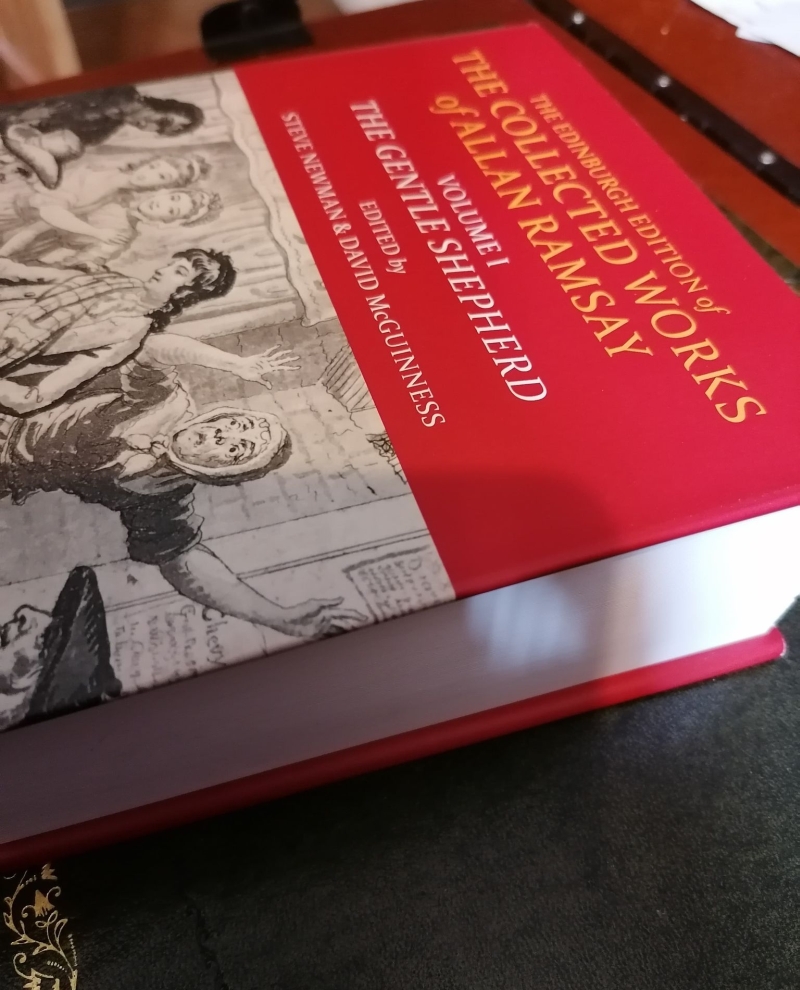
In our last blog, we noted that a large database of Gentle Shepherd performances will soon appear on the website showcasing where and how often Ramsay’s pastoral comedy was performed. So far, near 700 performances are recorded as having taken place in Edinburgh, London, the USA, and Australia, thus showing the reach of Ramsay’s work. At the moment, fellow RA Dr Craig Lamont and I are working closely with Brian Aitkin, the Digital Humanities Research Officer for the School of Critical Studies, to present all of this valuable information in such a way that it shows both the number of performances taking place each year and is easily searchable by geographical location and year. More anon.
It is wonderful to see this brand-new edition finally in print. Newman’s hefty introduction helpfully contextualises why a new edition was needed and gives a detailed account of its reception history, both as a literary text and its performances. Both the 1725 and 1729 texts have been transcribed and neatly presented, with detailed notes showing the various changes from manuscript to print. Indeed, the wealth of surviving manuscript material reveals Ramsay’s process in creating and editing The Gentle Shepherd.
For the first time, David McGuinness has taken a deep dive into the music. Avid readers will know that Ramsay never provided musically notated versions of the music he intended for the ballad opera version of The Gentle Shepherd, but he did indicate the tunes for each song. The practice of merely indicating the tune was not unique to Ramsay but borrowed from the broadside ballad tradition. Such a simple and inexpensive solution in Ramsay’s day created a wealth of investigative work for me and McGuinness as we attempted to identified what tunes, or rather what versions of the tunes might have been in Ramsay’s mind when he said, ‘To the tune of…’. The edition takes a thorough look at what musical sources were available at the time Ramsay was penning the ballad opera version of The Gentle Shepherd and discusses which versions of the tune suitably fit Ramsay’s lyrics. Music notation for many of these tunes are also provided.
Of course, one of the most exciting parts of the project (at least for me) is that we have been able to perform scenes and songs from The Gentle Shepherd based on the research we have undertaken. Scenes from The Gentle Shepherd were performed at The Ramsay Festival back in 2018, and I had the opportunity to perform some of the songs at the Musica Scotica conference in May 2019. McGuinness is currently recording songs from both The Gentle Shepherd and the Tea-Table Miscellany, which will be available by the end of the project.
We plan to celebrate the release of this wonderful new edition in the summer. Craig and I are firming up the details and will share more information as soon as everything is organised.
BRK
Blog 40: 28 April 2022
It's our 40th blog!
As we count down to the official release of the first volume of our Edition, edited by David McGuinness and Steve Newman, it is worth going over some recently-tread ground. Namely, the trails and meadows of Ramsay Country, ‘a few miles south of Edinburgh’, in the Pentlands.
Friend of the project, Nigel Leask, recently shared with us the 1808 Map of the Scenary of the Gentle Shepherd from a Plan of the Year 1770.
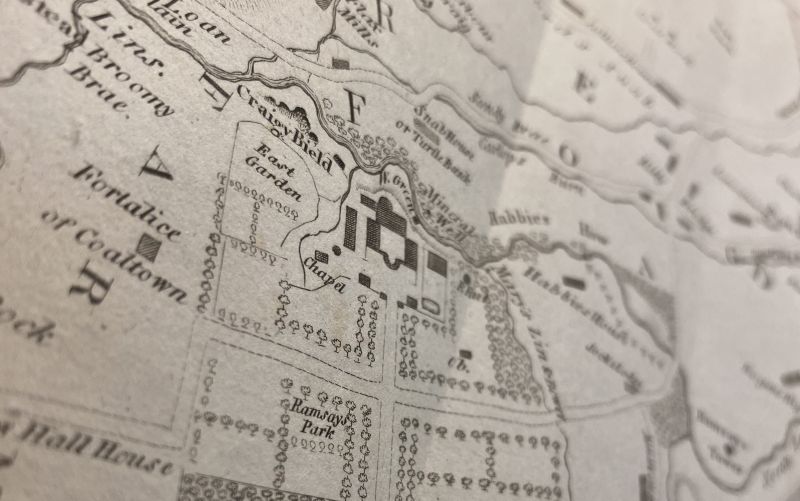
Link to hi-res version on NLS website in gallery: https://wee-windaes.nls.uk/the-gentle-shepherd/
We make reference to this map in our Reception pages, and, with more detail, in Craig’s essay published in Studies in Scottish Literature.
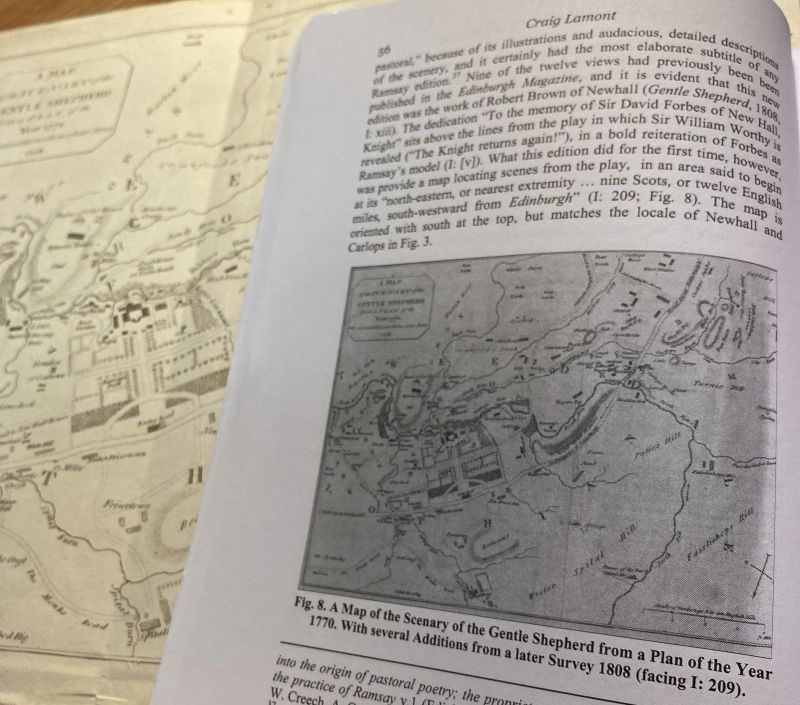
As you will see in Craig’s essay, this map was part of a cultural tug-of-war over who could lay claim to having the seat or the origin of Ramsay’s famous play.
Spoiler alert! New Hall seems to have won with some thanks due to this map, which appeared in Robert Brown’s edition of Gentle Shepherd in 1808.
In just a few weeks, then, the Ramsay website will have a very exciting addition, which also links into our brand-new edition of The Gentle Shepherd. The co-editor Steve Newman has been working on a database of Gentle Shepherd productions that have been performed throughout Britain, North America, and Australia since it’s very first documented performance in 1729. Side note, if keen Ramsay readers want to know more about the first performances of The Gentle Shepherd including new insight into which version of The Gentle Shepherd was performed by the Haddington Grammar School boys, then please read Brianna's article "Damage to Trees": Performing Ramsay's the Gentle Shepherd at Haddington Grammar School, available to read here.
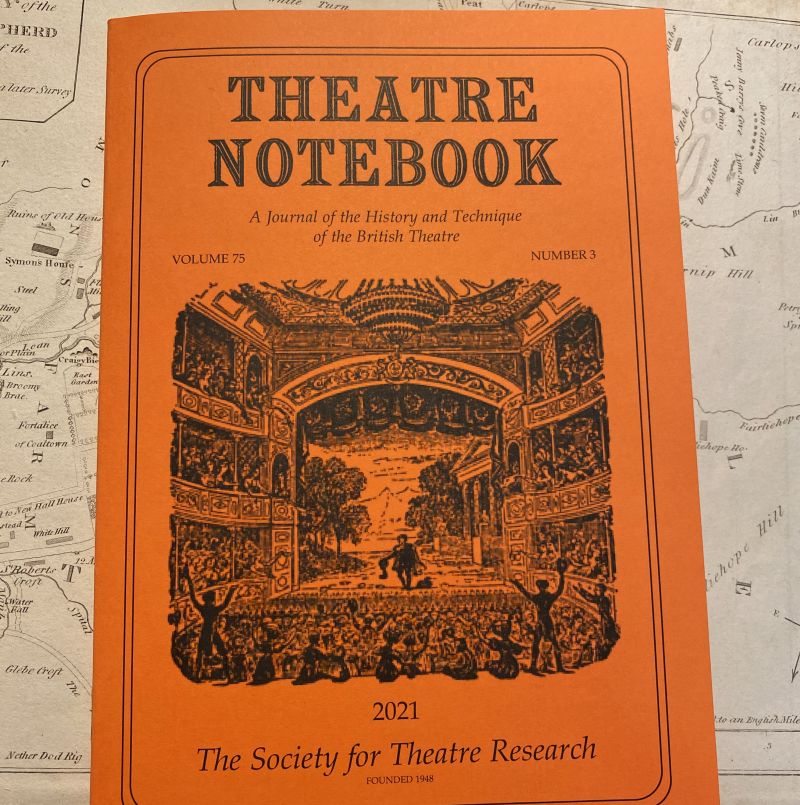
The team had also suspected that The Gentle Shepherd was very popular and regularly performed throughout the eighteenth and nineteenth centuries, but we never envisioned just how many performances took place, both locally and in far off distant lands. Indeed, an interesting finding is that Theophilius Cibber’s Patie and Peggie, an authorised London adaptation of The Gentle Shepherd, which cut down the original 5-act ballad opera to 2 acts was only performed in 2 separate seasons (1730–1, and 1746–7).
By 1752, The Gentle Shepherd, in all its glory, premiered at The Haymarket Theatre and there it remained as part of the regular repertoire until another, new updated version was produced by playwright Richard Tickell (1751–1793) and composer Thomas Linley (1733–1795). The main updates concerned the music, with Linley rescoring many of the original songs. The role of Patie also became a trouser role performed by Ann Cargill (1760–1784). That said, the substance of Ramsay’s original ballad opera remained the same. The Tickell-Linley version proved popular with performances regularly staged until the end of the eighteenth century. It was even performed in New York and Charleston in 1798 and 1801 respectively.
Musician and concert-master David Kennedy (1825–1886) who was known for performing Scots song took The Gentle Shepherd on tour, performing Ramsay’s popular theatrical in Edinburgh, Glasgow, London and even Melbourne, Australia. While The Gentle Shepherd fell out of the ballad opera repertory in the twentieth century, there were a few occasions when it was brought to life. Nigel Leask, above, also recently came into position of the programme for a 1949 performance of The Gentle Shepherd staged at Edinburgh Music Festival.
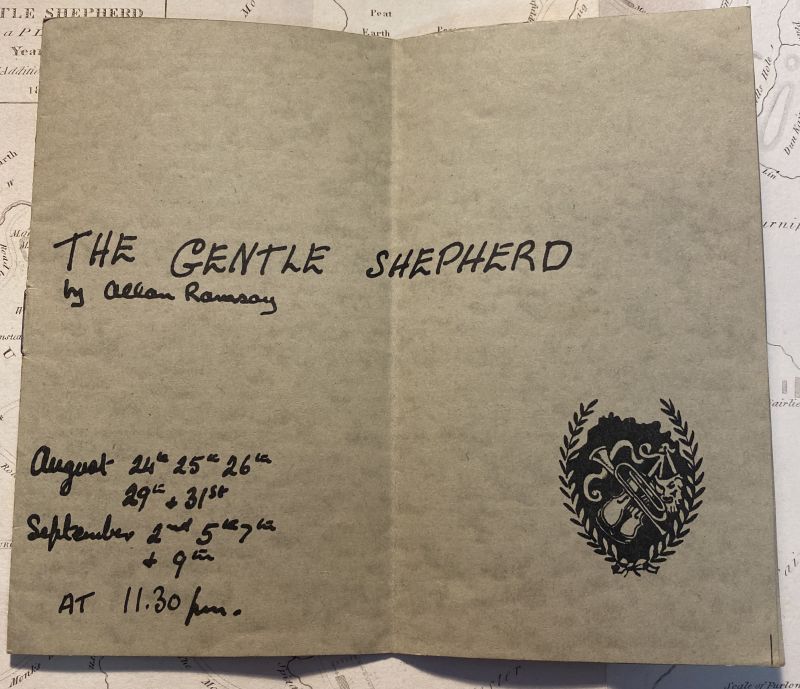
The programme is handwritten by musician and composer, Cedric Thorpe Davie (1913–1983) and provides insight into the personal involved in the production.
The performances highlighted here are just a snapshot of what appears in the database, which provides the most comprehensive overview of Gentle Shepherd performances to date. The resource will not only be excellent companion to the new Gentle Shepherd edition but will also be of use to scholars interested in theatre and performance history. The database will be released in May.
Next month’s blog will be entirely dedicated to the new edition of The Gentle Shepherd. In anticipation of its forthcoming release we have a sneak peek of what’s to come…
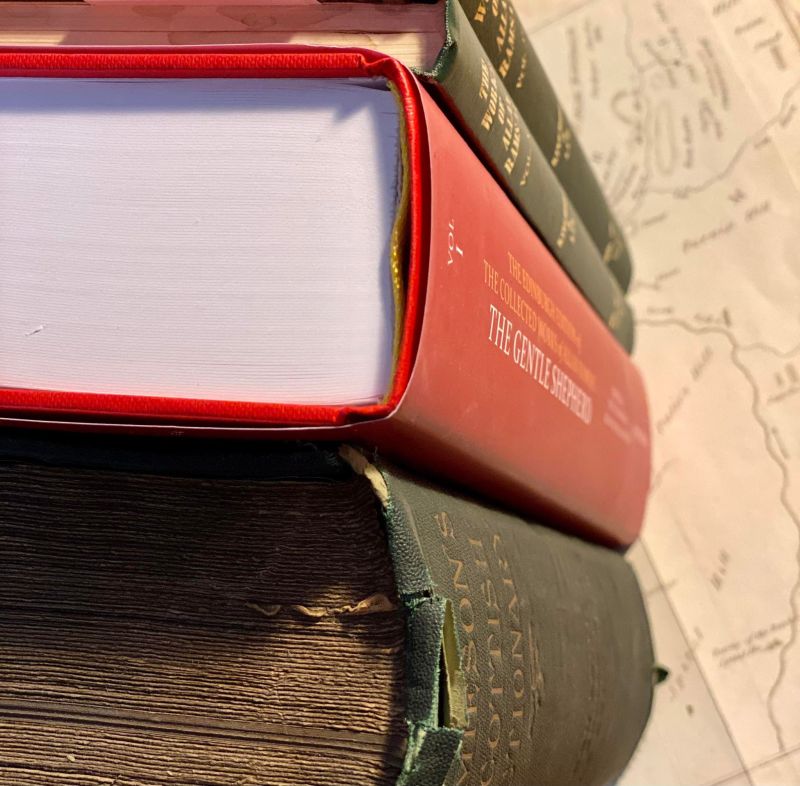
CL & BRK
Blog 39: 29 March 2022
Dear Ramsay Readers,
I hope you have enjoyed these early days of spring, with much blue skies and sunshine to enjoy already.
We are delighted to share the final cover (low-res) of the forthcoming first volume of our edition, The Gentle Shepherd:
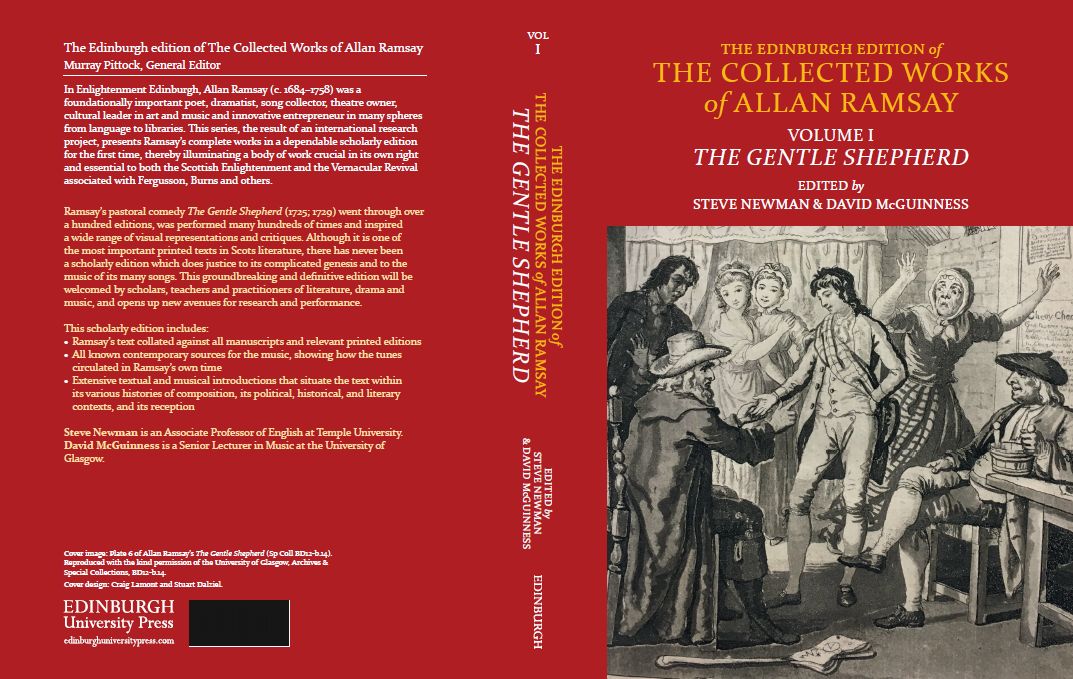
https://edinburghuniversitypress.com/book-the-gentle-shepherd.html
We should have copies of this in the coming weeks, with launch details around May/June to be confirmed and announced in due course.
Meanwhile, final proofing of the next two volumes (Poems) is ongoing, and typesetting for The Tea-Table Miscellany is well underway.
In the last blog, Brianna offered an overview of the forthcoming volumes of the edition, and I will take the chance to expand on that now and offer some new insights into the process.
First, here is a sample double-page spread from Poems.
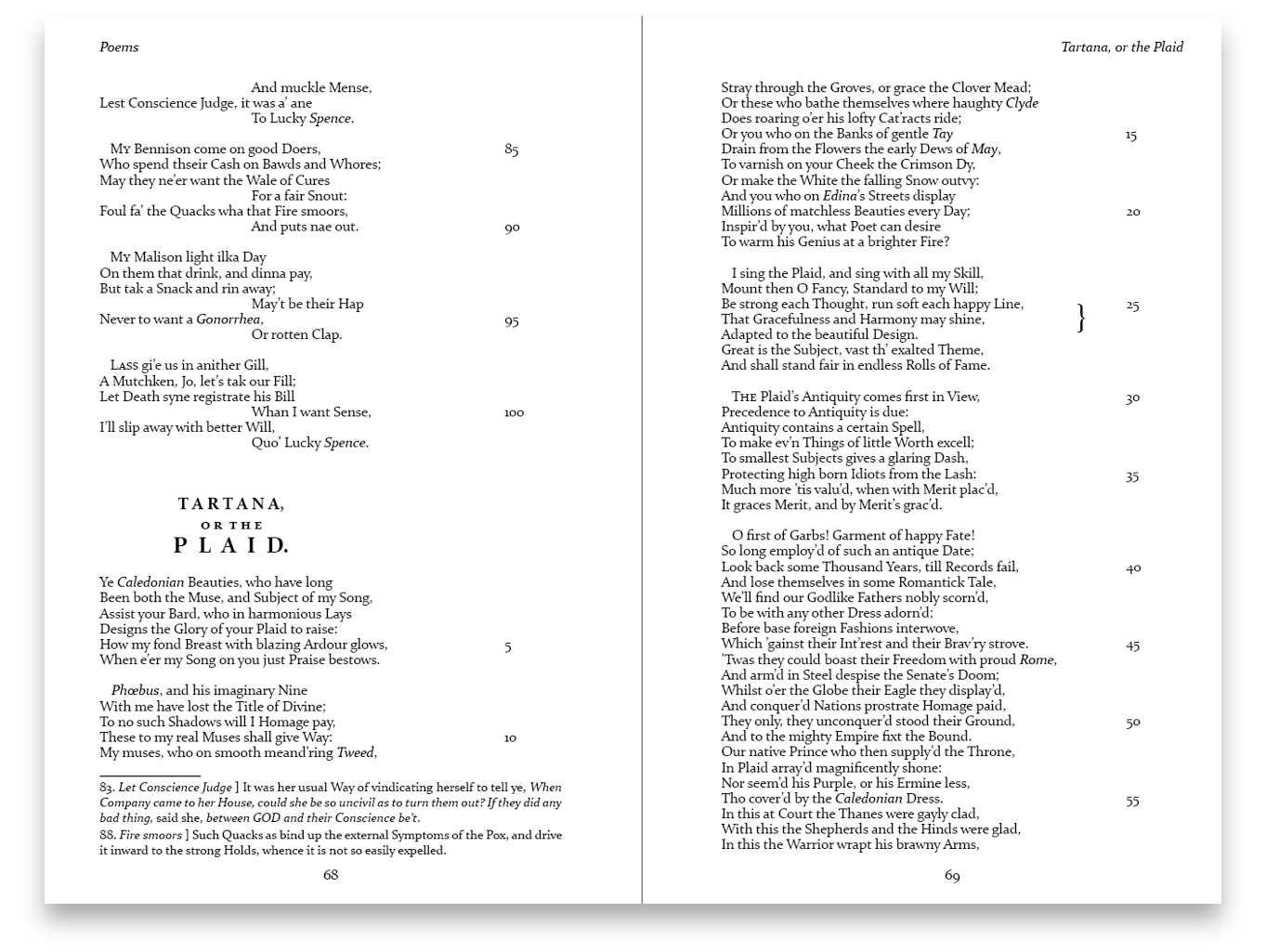
As you can see, the titles will resonate with the style in which they were first printed – in this case, in 1721 – and the footnotes are as Ramsay had originally intended. Triplete marks appear as in their first printing also, though Ramsay is not consistent with these across his poetry collections, so we have added them where necessary. Running headers will help locate poem titles easily, and we have included a full index of first lines, spanning both volumes of Poems, which also point to the given title (if applicable). In other words, we are producing a user-friendly edition without losing the scholarly integrity required to disseminate a combined print and manuscript culture. In the notes we also reproduce the doodles Ramsay made in manuscripts. We hope you enjoy those!
As mentioned, typesetting is also well underway for The Tea-Table Miscellany, which will include the text, notes, and music for all four volumes Ramsay produced in 1723, 1726, 1727, and 1737. Following the Introduction to this part of our new edition, edited by Murray Pittock and Brianna Robertson-Kirkland, we will reproduce a selection of the ornaments that appear throughout Tea-Table Miscellany, by Ramsay’s printer Ruddiman. Some of them can be seen at the University of Birmingham website Compositor: https://compositor.bham.ac.uk/. A simple search for ‘Ruddiman’ provides examples from Ramsay’s texts, including The Ever Green.
More on TTM as we make progress.
Prose! Ramsay has a good deal of prose writing to collect and edit, including almost 80 letters and his famous Scots Proverbs (1737) among others. The editing of this part of the edition will be carried out by Rhona Brown and myself. Although best known for The Gentle Shepherd and his poems and songs, the prose collection will be a crucial aspect of the edition, showcasing Ramsay’s epistolary mode, and his formative thoughts on major issues. We look forward to working on a ‘true and faithful account of’ the Porteous Riots (1736), and Ramsay’s (anonymously published) Defence of Dramatical Entertainments (1728), a response to William Law’s The absolute unlawfulness of the stage-entertainment fully demonstrated (1726). Indeed, Ramsay’s role in Scottish and British culture can be expanded greatly via prose.
So, for the foreseeable I’ll be working on finalising proofs for Poems to go to print, and working with Brianna to complete a first proof of TTM. More on all these fronts next month!
On another note, Brianna launched her book on 21 February 2022. You can find more information about it here: https://www.routledge.com/Venanzio-Rauzzini-and-the-Birth-of-a-New-Style-in-English-Singing-Scandalous/Robertson-Kirkland/p/book/9780367443375
We are very proud of her!
CL
Blog 38: 7 February 2022
Hello Ramsay Readers,
It’s early February and while daffodil shoots tease that Spring is just around the corner, at this very moment, snow and sleet are falling form the heavens and icy winds whip round the trees. Alas, winter is still with us but that does not deter the Ramsay team from pressing ahead. Indeed, since the beginning of the year we have all been busy bees pushing forward with various deadlines.
I’ll give a summary of our activities below, but first I must alert you to a Ramsay concert due to take place at Sloans Bar and Restaurant, Glasgow on 24th February 2022.
Concerto Caledonia will be joined by folksingers Iona Fyfe and Alasdair Roberts who will lead performances of Ramsay's Scots songs. The concert will take place in the Ballroom at Sloans, a historic location first built as a coffee house in 1797. Tickets are £20 (£10 concession) and are available to purchase here. For more information, please see details on Concerto Caledonia’s website.
Now, what else have the team been up to this past month?
Poems
Rhona Brown, editor of Ramsay’s Poems, submitted the final manuscript on St Andrew’s day and since then, lead RA Craig Lamont, has been typesetting the text ready for it to be sent to EUP for printing. The edition will include poems from the 1721 and 1728 edition, as well as the Uncollected Poems of Allan Ramsay, complete with detailed notes. It is a huge collection and as such, the edition will appear in two volumes.
TTM
Meanwhile, along with our PI, Professor Murray Pittock, I have been working through the notes for TTM, including double checking the music transcripts, and gathering all the various sources for the music source list. It has been a real joy to research all the songs appearing in TTM and seeing where Ramsay sourced his ideas for texts and tunes. It is such an eclectic musical mix and has given me new insights into popular culture in early eighteenth-century Scotland. My feelings on completing the edition are quite mixed. On the one hand, I will also be sad when I no longer spend my days thinking about how Ramsay imagined a tune would sound or what collection he might have been reading that inspired him to pen a new set of lyrics. On the other hand, I am very excited to see the edition out in the world. The deadline for completing the text ready for typesetting is 28 February, so I don’t have much time left (to work or to wait!).
Evergreen
Fellow RA, Jim Caudle, is continuing to press on editing The Evergreen. At the last team meeting, Jim highlighted the multiple Ramsay doodles he has found. Throughout Ramsay’s draft manuscripts he often draws medieval-like figures. There is even the occasional dragon. There is no denying Ramsay’s creative verve, but these doodles give a little more insight into his more whimsical side.
The Gentle Shepherd
We are gearing up for the release of The Gentle Shepherd, which is now listed on the Edinburgh University Press website. We are planning an exciting launch event in Edinburgh later in the year, though we aren’t quite ready to share the details just yet. Don’t worry. Once we have all the information ready, we will be sure to let everyone know.
New publication
Just at the end of January, my article ‘”Damage to Trees”: Performing Allan Ramsay’s The Gentle Shepherd at Haddington Grammar School’ was published in Theatre Notebook, a journal of the history and technique of the British theatre. In the article, I discuss the first performances of The Gentle Shepherd and bring to light new evidence of how it was staged at Haddington Grammar school. I had the idea for this article almost three years ago, while reading through the council minutes for 1729 held at the John Gray Centre in Haddington. It is so gratifying to see this work finally in print. The article is not available on the website yet, but it is available in print.
That’s all from me this month. Next month we will be celebrating the completion of TTM.
-BRK
Blog 37: 23 December 2021
Hello followers,
With only a few days until Christmas we wanted to sign-off with a short blog looking back on an incredibly important year for the Ramsay project.
2021 has certainly been an unusual year. We have dealt with more than one type of lockdown, at numerous points, and had our expectations change like the wind. Since the pandemic began, in fact, the very fabric of time has felt very different. We began work on the Ramsay edition in January 2018. By January 2020 we had made great progress, but we could not have imagined the changes to our lives that was just around the corner.
And now, looking at the horizon of 2022, the beginning of the fifth year of the project, we wanted to pause and take stock of just how far the work have come.
In January, we presented an online video on the project to the 2021 British Society for Eighteenth-Century Studies (BSECS). This video is still available to view on our dedicated Ramsay YouTube channel - https://www.youtube.com/watch?v=qFxhUFQkzuw&t=3s.
In March, we produced another video resource marking the special issue of Studies in Scottish Literature (2020). That video is also on our YouTube channel - https://www.youtube.com/watch?v=rG_1tXr8uUI.
In April, we got back into the archive (Craig was issued the first reader ticker for the National Records of Scotland since lockdown)! This was crucial to the final transcription and editing of Ramsay’s poems. Brianna also made a start on transcribing the music which will appear in the new edition of the Tea-Table Miscellany.
In May, Brianna had an article accepted for publication in Theatre Notebook, which digs deeper into the early performance history of The Gentle Shepherd. We will be sure to update you all with the article is published in early 2022.
In the summer, as the Covid vaccines began to roll out nationwide, we completed the typesetting of what will be the first volume of the Ramsay edition: The Gentle Shepherd, edited by Steve Newman and David McGuinness. As a team, we were so pleased to see this volume submitted to Edinburgh University Press to be published in 2022.
In November, Jim Caudle made good progress with work on The Ever Green with a trip to the British Library in London, where Ramsay’s manuscripts for the text are held. Brianna also took a trip to the British Library in search of the final pieces of music that add to the Tea-Table Miscellany wider musical and textual history.
And also in November, Rhona Brown, editor of Ramsay’s Poems, submitted her final files for typesetting. These will appear in print in 2022, showcasing the 1721, 1728, and Uncollected Poems of Allan Ramsay, fully collated with manuscripts. This huge effort, delivered exactly 300 years since the publication of Ramsay’s first authorised edition of verse, is an excellent way to end the year. In fact, we have begun typesetting with haste, hence the missing blog of late November/ early December!
Good work is being done to finish off Tea-Table Miscellany and bring it to a state of readiness for setting, and Prose is also well underway. In other words, things are in good shape for 2022, which will see the fruits of our labour appearing in print for the first time, as we continue editing the remaining volumes.
We hope that by then the world is a little safer, and we can celebrate moments of achievement together! Oh, to have some music from Ramsay’s day, some readings, and clinking glasses.
From all of us on the Ramsay team… have a well-deserved rest over Christmas, and a braw New-Year when it comes.
CL & BRK
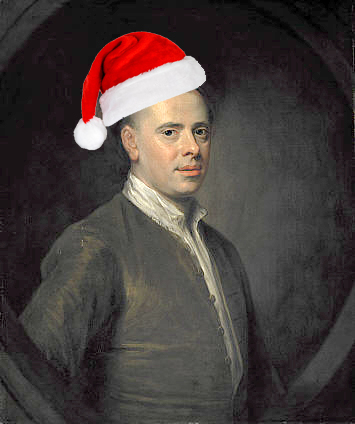
Blog 36: 28 October 2021
Happy October to all our readers.
October is always such a busy time of the year. Once again, the university campus is a lively bustling hubbub, and this year is extra special since Glasgow will host the highly anticipated COP26 conference. It is also the month when our belovéd bard was born and the 15th October marked Ramsay’s 335th birthday! Normally, in pre-COVID times, we would celebrate such an important occasion at The Allan Ramsay Festival, however, this year the festivities were limited to an afternoon event. Hopefully, next year we will be able to mark Ramsay’s birth with a variety of in-person events, particularly given that many of the new editions will finally be made available to the public. Just before Ramsay’s birthday, friend of the project, Dean Woodhouse created a beautiful video showcasing the landscape that was said to have inspired Ramsay’s The Gentle Shepherd. It is available to view here.
As such, the Ramsay team have been pressing on with the project. The new edited volume on Poems, edited by our very own Rhona Brown, is very near completion and we anticipate setting the volume before the year is out.
In our last blog, Craig happily announced that The Gentle Shepherd edited by Steve Newman and David McGuinness had been submitted to the press and we now excitedly await holding the final volume in our hands. That won’t be for a few months yet, but we have started planning celebrations for the launch in 2022.
TTM is also nearing completion and I have been busy working on the musical notes for volumes 1, 2 and 3. Tracking down song texts is one part of the process, but the other (and occasionally more difficult) part is finding the sources for the tunes and carefully analysing them. Some tunes are easier than others. For example, in TTM I, even though the tune, ‘Love is the Cause of my Mourning’, is found in several manuscript and print sources there are few inconsistencies in the music notation. It is also quite clearly the same tune in all located sources.
Other tunes are not so simple and have quite a complicated bibliographic history. I have managed to trace three completely different tunes for ‘Black Ey’d Susan’, a tune also found in TTM I. (It appears in TTM II too). Two different tunes titled ‘Black Ey’d Susan’ are traced to the London theatre, while the third is found in two different Scottish sources, including Alexander Stuart’s Musick for Allan Ramsay's Collection of Scots Songs. While one could assume that Stuart’s tune is the one Ramsay had in his head when he wrote the song text that might not be the case.
And that’s not all. One of the tunes had two different titles: ‘Black Ey’d Susan’ and ‘All in the Downs’ (which was the first line of text to one of the London theatre songs). Ramsay composed three different texts, indicating two of these texts should be sung to the tune ‘Black Ey’d Susan’, while the other should be sung to ‘All in the Downs’. Clearly, Ramsay thought there were two distinct tunes and part of my job has been finding, analysing, and dissecting something that may have been quite obvious to those who knew these tunes in the eighteenth century.
As you can see above, it is no easy task to explain such a complicated story in words, so I have been transcribing musical sources to show readers the musical differences. The beautiful part of music notation is that it is graphic and even if readers cannot understand the musical language, it is easy to see the one tune is not the same as the other when they are printed side by side.
TTM has certainly turned up many unexpected surprises and while I don’t want to give away too many of our findings, what I can say is that each of the four volumes have their own, unique story to tell. I cannot wait to see this volume in production.
Just to finish, we have some sad news. Long-time supporter of the project, Rosemary Brown is moving on from running The Allan Ramsay Hotel in Carlops. The project team would like to thank Rosemary for all her hard work and especially for making Allan Ramsay’s life and work a prominent feature of the hotel.
BRK
Blog 35: 24 September 2021
Greetings all,
On Thursday 23 September we held another editorial meeting to firm up some details around Tea-Table Miscellany, Poems, Prose, and the Ever-Green, i.e. the remaining volumes of our Edinburgh Edition of Ramsay. As reported in our last blog, volume one (The Gentle Shepherd) has now gone to press. We are also looking at being involved in some events in the future, so stay tuned to our social media channels for updates!
But what of the other volumes? Well, we are at the closing stages of TTM and Poems, both of which we can begin typesetting in the coming months. Prose and EG will follow, though work on both is going well. And there are often intersections with Ramsay and his many literary and business ventures.
As Editor of the Letters in the Prose volume, I’ve been going round the many libraries and archives which hold autograph manuscript letters from Ramsay. There are just under 80 in total. Take, for example, Ramsay’s letter to the London-based Scottish bookseller Andrew Millar. It is dated ‘Edr July 15th 1732’, and in the first line it acknowledges a letter from Millar from the previous week. The purpose of their exchange is to agree on a cost for Millar to publish three volumes of Ramsay’s Tea-Table Miscellany, which had evidently become very popular.
It is useful to point out that three of the eventual four TTM volumes had been in print in Edinburgh since 1727. There were at least a further eight editions, some of which collected all three together, published in London, Dublin, and Edinburgh, before the final volume was printed by Ramsay in 1737. Millar’s edition, to which Ramsay agreed for a fee of five pounds sterling, appeared in 1733, and on the title-page it boasted ‘Being the Compleatest and most Correct of any yet published By Allan Ramsay.’ Incidentally, this phrase was used again when Millar published all four volumes in his editions dated 1740 and 1750.
And if you’d like to see a similar letter, the Millar project at the University of Edinburgh has transcribed Ramsay’s letter to Millar dated 20 May 1735: http://www.millar-project.ed.ac.uk/manuscripts/html_output/11.html.
Letters like these are very valuable not only in charting key moments in Ramsay’s life (the 1735 letter to Millar begins ‘having built a new house lately…’) but also in his literary endeavours. As we know, pirate copies of Ramsay have plagued his publishing trade since the very beginning. The Mitchell Library letter shines a light on Ramsay’s authorisation of an important edition by one of the most important London-based figures of the Scottish Enlightenment.
There is another intersection here worth noting.
In 1729, Ramsay once gain published the second volume of TTM, the ‘fifth edition’. This particular edition is crucial to GS, for it contains ‘Songs to be sung in their proper Places on the acting of the Gentle Shepherd, at each the Page marked where they come in.’ The songs can be found in pp. 169-188. Why are they so crucial to GS? Well, quite simply, because the 1729 TTM and GS editions comprised, for the first time, the full ballad opera version of The Gentle Shepherd. Volume one of our Edinburgh Edition will show the workings of this relationship in full.
But there is also a crossover with Poems. Immediately after the GS sangs, this 1729 TTM contains a Song titled ‘On our Ladies being dressed in Scots Manufactory, at publick Assembly’ (pp. 189-192). The appearance of this song is something of a bonus, or extra, because it does not appear in the first edition of vol. 2, or in any other volume for that matter. And so, in accordance with our textual policy, it will be sorted into the Uncollected section of Poems, where we will use this TTM text and collate the two surviving autograph manuscripts. The first, a draft, can be found in the British Library, Egerton 2023, ff. 43-44, and the fair copy is located at the National Library of Scotland, MS 2233, ff. 8-9.
There are many variants across these three texts. Take line 17, for example.
In the draft manuscript, Ramsay has ‘Clean neat in her dress becomes the fair’.
In the fair copy he has ‘Neat in her Dress becomes the ffair’.
In the printed text it reads ‘Apparel neat becomes the Fair’.
This arc of revision is typical in Ramsay’s textual practice. We see ‘clean’ becoming ‘neat’, we see the capitalisation of ‘Dress’ coming in, and we see the presentation-style double ‘ff’ for ‘F’. And for all that, ‘Neat in her Dress’ is changed simply to ‘Apparel neat’, which, syllable for syllable, says the same thing but with a touch more… class? It is also worth noting that both manuscript versions were composed of four-line stanzas, whereas the printed version adheres to the eight-line verse style found in many of Ramsay’s TTM productions. These are just some of the many fascinating edits we will trace throughout every Ramsay poem and song, where possible.
I hope this has been a useful glimpse behind the red (see cover of vol. 1) editorial curtain of the Edinburgh Edition of the Collected Works of Allan Ramsay.
Until next time - thanks for reading!
CL
Blog 34: 13 August 2021
It is a little strange writing this blog. Our usual weather-gazing leads us nicely into seasonal verse by Ramsay, but in the past week we’ve had all the weather at once. One minute we’re in the sunshine with dripping ice cream, the next we’re running from hard and fast falling rain. But the main reason this blog is particularly strange is…
…this is the first blog since our big hand-in to Edinburgh University Press.
(drumroll)
At the end of July, we submitted the final version of The Gentle Shepherd: 600+ pages, complete with both the 1725 and 1729 versions of the text, adjacent song texts, notes, collation, music, a bibliography, a glossary, and some manuscript images and title-page images for good measure.
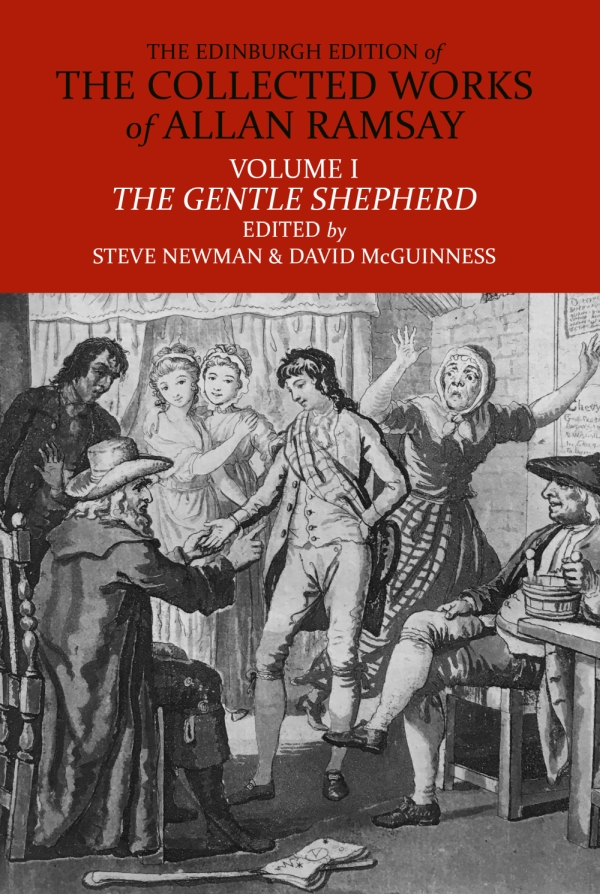
This is volume 1!
What a job Steve and David have done in getting this work together. We worked very closely with them as we set the volume, which we hope kick-starts the edition nicely. In the coming months we’ll be able to share more about the publication schedule as well as launch events. We can’t wait for you to see it in print.
Having left the charming world of The Gentle Shepherd for now, we turn our attention swiftly back to the forthcoming volumes: Poems and The Tea-Table Miscellany. On both, we are in a very healthy editorial position. We have text and collation notes for almost every poem and song, though with Ramsay’s ‘Uncollected’ works we continue to discuss and debate the best course of action for the particularly thorny poems. By this we mean those poems for which there is more than one reliable manuscript source. We tend to lead with the earliest-known version (it helps if they are dated, which is not always the case) and then provide the variants across subsequent versions in the notes. In some cases, an undated poem can be difficult to place. Luckily, Ramsay often sends his poems to known correspondents, or discusses at least a few topical events which help us estimate their date. Previous scholarly attempts to date Ramsay’s uncollected works, and trace all the texts, can often be misleading. We hope the Poems volume marks an important turn in Ramsay’s legacy, offering for the first time a full textual handling of all his poems. It does give the team a starting though, which cannot be said for The Tea-Table Miscellany (TTM).
Little work has been done on the archaeology of the songs (both musical and textual) published in the four TTM volumes until now, and so far, there are some really interesting findings to discuss in the notes. Our avid blog readers will need to wait until TTM is published to find out more – we can’t give away all the fun – but these new discoveries have really changed initial theories about how Ramsay pulled this rather complicated collection together. Like Poems, TTM is also inviting challenging editorial questions. Throughout TTM, Ramsay recycles tunes but that doesn’t mean the text he sets to the tune is a perfect fit. Stuart’s Musick for Allan Ramsay’s Collections of Scots Songs occasionally gives some idea about the tune Ramsay had in mind when he was devising a song, but there are also instances when it is stylistically instrumental and not at all suitable for singing. Moreover, not all of the tunes found in TTM were including in Stuart’s music book, which leaves the team with even more questions about what tune Ramsay had in mind and how he imagined text and tune fit together. While we might not be able to answer these questions definitively, the edition is the first to track the history of each song and consider how they were performed.
The Gentle Shepherd may have gone to press, but the team are pressing on with editing, setting, and planning potential launch activities. We will be sure to keep you updated.
CL & BRK
Blog 33: 9 July 2021
Summer is upon us, and the sun is shining. Meanwhile, the Ramsay team is in the final stages of setting and copy editing The Gentle Shepherd before submitting it to Edinburgh University Press later this month. When I was appointed as RA on the project, I knew that I would be expected to locate, analyse, and transcribe all of the musical sources connected to The Gentle Shepherd, but I never expected to be involved in setting the final text. While it may seem somewhat intimidating to learn how to use a brand-new piece of software, in this case, InDesign, a programme used explicitly for typesetting, I have enjoyed the experience of being involved in every stage of producing this edition. However, that does not mean that setting the text has been smooth sailing. There has been a great deal of learning involved in the process, and not just learning a new programme but also trying to problem-solve specific issues that often only affect the musical text. In this blog post, I thought I would reflect on some of these issues and discuss how I have resolved them. I make no claims to being a professional typesetter, nor do I think the solutions I have come up with are the only or most efficient approaches, but for any RAs or editorial teams faced with producing a camera-ready copy of text and music, it might be helpful to know a little more about some of the challenges one may encounter.
First, let me explain a little about how the music is transcribed before it is set in InDesign. Music editor on the volume, Dr David McGuinness, and I have been transcribing the musical material using music notation software aptly named Sibelius. (The programme reminds its users that it is named after Finnish composer Jean Sibelius by playing a short segment of his Symphony No. 6 in D minor). Generally, Sibelius gives us a bit of control in spacing the notes, the bars, and the lyrics. Once we were happy with the transcription, the music is exported as an image file and imported into InDesign. Sounds simple, right? Well, not quite. Just last week, I discovered that somewhere between exporting the Sibelius file, importing it to InDesign, and exporting the final file as a PDF, some of the music notes were cut off, even though it looked perfectly fine in Sibelius and InDesign. Eventually, I discovered the problem. All of the Sibelius music files were exported with a bounding box – a box that detects the objects on the page and automatically crops out the white space around it. Unfortunately, there is no option to change the bounding box size in Sibelius, so it will either export with the box or without it. I ended up exporting all the images again without the bounding box and cropping the images manually in Photoshop before inserting them into InDesign. It was a lengthier process all around, but ultimately it gave me a lot more control over how the images appear, especially when it came to splicing one musical example across two pages in a spread. That brings me to the second biggest issue I have encountered in setting the music: page turns.
Inconvenient page turns are one of the biggest frustrations for any musician who relies on reading music notation. Perhaps the page turn sits right in the middle of a difficult passage, or there is a repeat bar that typically would not cause the musician to trip if there was no page turn. I have seen my colleague’s photocopy pages and tape them together to avoid the page turn. I wonder how often musicians have thought: ‘Why is the page turn there? Couldn’t the publisher have chosen a better place?’ I didn’t fully appreciate the naivety of such questions until I started setting the music for The Gentle Shepherd.
In The Gentle Shepherd, we are not just setting music but also a lot of textual analysis and explanation that accompanies the music, so the question of page turns is a little more complex. To ensure the reader has a satisfying reading experience and is able to assess the written discussion alongside the music notation, all should appear on a page or a page spread – two pages viewed together. In some cases, the challenge is that the music and accompanying discussion does not always fit neatly into a spread, at least not without leaving a lot of white space. In fact, in some cases leaving some white space at the bottom of a page and setting a musical example on a fresh spread is necessary to avoid awkward page turns. My colleague and fellow setter, Dr Craig Lamont, has also been problem-solving similar issues in setting the text and I am sure he will happily share his solutions in a future blog post.
In general, I have tried to be mindful of how the musical examples and textual discussion will appear to the reader, whether they are music readers or not. If a musical example needs to appear across two pages in the spread, it is spliced where there is a natural “pause” (for lack of a better term) in the music. The splice is typically immediately after a repeat bar line or a double bar line at the end of a stave. If there is no natural pause, then the musical example is set on a separate page, even if this means leaving some white space on the previous page. This method works for an edition like The Gentle Shepherd as the music is not intended for live performance. Of course, a musician can perform the music in the edition, but it is not a performing score. Instead, the examples are there to be illustrative. If we were setting a performance edition, we would need to pay much more attention to how the music was initially set in our notation software.
These were two of the biggest issues I have encountered in setting the edition, and it has been gratifying to find workable solutions. In many ways, setting the edition of The Gentle Shepherd has helped me feel even more connected to Ramsay. While he did not print The Gentle Shepherd (that was the work of Thomas Ruddiman), he was involved in its creation and final publication. And Ramsay did have some experience of printing music, having printed Alexander Stuart’s Musick for Allan Ramsay’s Collection of Scots Songs. It has helped me understand the mechanics of textual and musical settings, which, no doubt, in the eighteenth century, would have been far more complex than it is today. As an RA, I am so grateful to be on a project that allows me to enhance my skills as a researcher and learn brand new skills, which will serve me in my later career.
BRK
Blog 32: 1 June 2021
At long last, Scotland has enjoyed a heatwave over the holiday weekend. Hopefully this is a good omen as the Covid vaccines continue on, and restrictions are gradually eased. Last time round, Brianna kindly reported on a good number of new developments relating to the wider activities of our team, with new website launches and international activities. In this blog I’ll be writing about the typesetting process for the first volume of the edition, and offering more insights into my most recent trip to Edinburgh.
The Gentle Shepherd! We are very close to having a first, full typeset draft of what will be our first volume, and it is very exciting. Working on text and music as closely as we are, Brianna and I have been setting these sections concurrently on Adobe InDesign. As the textual researcher I’ll focus more on the verse rather than the music.
Following many conversations with the production team at Edinburgh University Press, we’ve got our sizes, margins, type (‘Constantia’), and spacing all decided. With these settings in place, we are creating several documents to be collated at the end, which (after much proofreading!) will form the final ready-to-print file.
A few notes about the details we are looking to replicate: while this is not a facsimile edition, we are looking to emulate some of Ruddiman’s printing quirks in appropriate places. Part of the reason for this is to retain something of the original edition without compromising the reader’s accessibility. After all, some of Ramsay’s printed works were very busy, a lot for the eye to take in. This was typical in the early eighteenth century, before printers like Robert and Andrew Foulis helped encourage a culture of finer printing.
Take these pages for example:
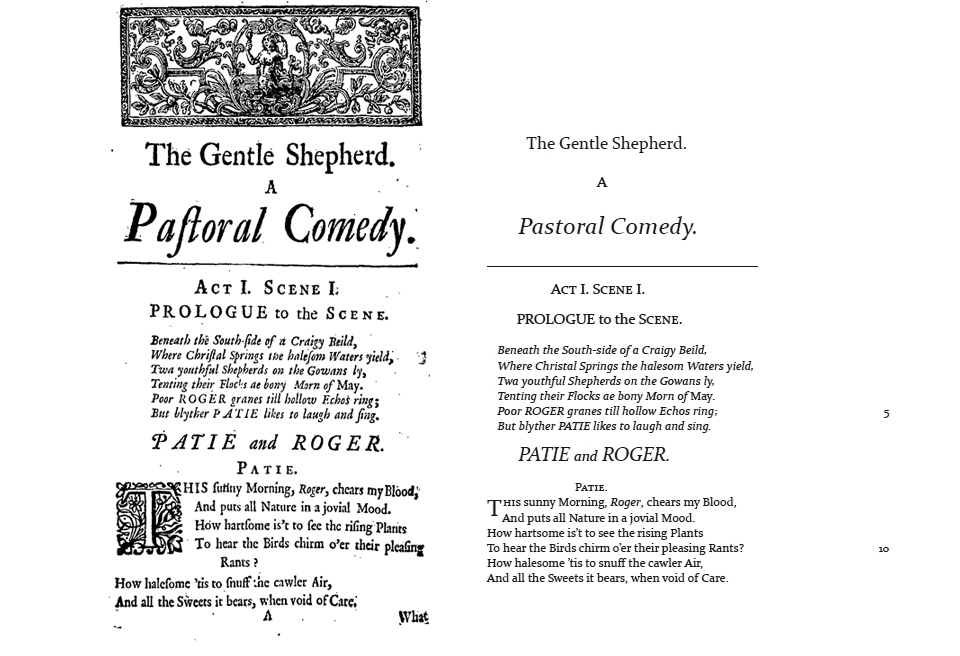
In our setting, we have added line numbers, and we have lost the header ornament and the very large illuminated letter. This modern aesthetic intends to suit more readers, but mirrors some of the original composition. In other places in our volume, we will take the opportunity to feature images. Facing the beginning of Act 2, for example, we have included the relevant page from the Fair Copy manuscript, giving the reader a sense of the evolution of the work from manuscript to print.
Elsewhere, as in Act 3, Scene 2, we have echoed the black letter type and the Ruddiman ornaments used to divide these crucial stanzas:
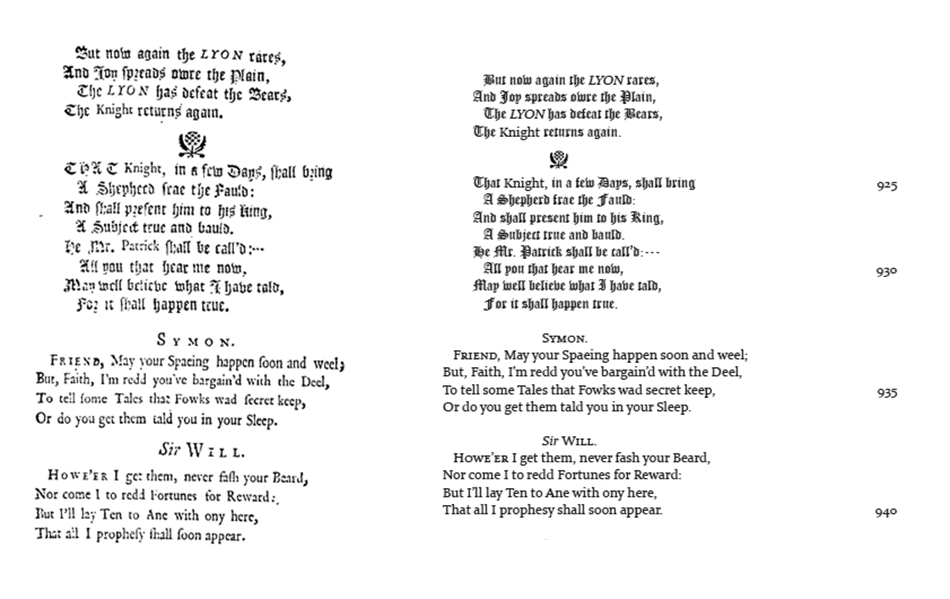
As it is the only instance of this in the text, it made sense to pay homage to the original. Indeed, we will be doing something similar in the setting of Tea-Table Miscellany, where the recognisable ornaments of Ruddiman are dotted throughout.
Taking a break from the typesetting, I have also been back to Edinburgh. Firstly, I was transcribing the last of material kindly laid out for the project at the National Records of Scotland. Most of this material consisted of Ramsay’s letters: giving us transcriptions for later in the edition where I will be working with Rhona Brown on the Prose volume. That same day, I walked from the NRS across Waverley bridge, up the High Street and into the NLS, where a few formidable volumes lay waiting. In these, I took photographs of some more Ramsay letters, and more than a few curious poems, for which we have no manuscript source, but which survive in posthumous prints. Deciding on the credibility of these is a work in progress, more on that anon!
It is my hope that, in the next few months, we can began sharing more features of the edition. The cover art, and colour scheme for the jackets, are being decided at the moment. For such an important part of the aesthetic of our edition, you can imagine that these decisions are not being taken lightly!
Thank you for keeping up with the Ramsay project.
CL
Blog 31: 30 April 2021
April marks the return of spring. Indeed, throughout the month we have enjoyed warmer weather and sunny days. However, April 2021 is particularly significant as the country slowly wakes from four months of lockdown. Restaurants, non-essential stores, and salons have reopened and today, (30 April) many historic venues, which are popular destinations for tourists and families throughout the summer, are opening their doors to the public as well. The Ramsay team have wasted no time getting back to the archives. Fellow Research Associate, Craig Lamont, was back at the National Records of Scotland (NRS) on Wednesday, gathering material for the much-anticipated edition of Poems edited by Rhona Brown. In fact, the NRS informed Craig that he was reader no. 1 of the year!
Picture of the NRS taken by Craig Lamont on his return to the archives.
Earlier in the month, while we eagerly awaited the reopening of libraries and archives, the Ramsay team have continued to work on The Gentle Shepherd, Poems, Tea-Table Miscellany, and The Ever-Green. David McGuiness and Steve Newman have now passed most of their fantastic work to me and Craig for text setting in InDesign. It is so gratifying to see the edition come together and morph into its final form. There will still be a few weeks of adjustments before the full text is set, but I cannot wait to see the full edition complete.
At the end of last month, David McGuinness appeared on the Early Music America Early Music Trivia Night co-presented by the Bach + Beethoven Experience. Incidentally, the Bach + Beethoven Experience gave a performance of The Gentle Shepherd in Chicago in 2016 and some information on the performance, including a video and images from the production can be found on their website. The Early Music Trivia Night is an hour dedicated to discussion and, you guessed it, early music trivia. These Trivia Nights are live-streamed via Early Music America’s YouTube channel. The trivia night that David was a part of was dedicated to Gaelic music, but David found a way to talk about our auld Allan! Check out the discussion which starts at 38 minutes: https://www.youtube.com/watch?v=AnOWyu4A4-Y.
David has also launched a new section of the hms.scot website, which provides a comprehensive catalogue of 27 Scottish manuscript sources of violin music from before 1750, with around 3500 tunes all searchable by name, Theme Code and other features. The catalogue was carefully researched and put together by Aaron McGregor. hms.scot is also home to over 200 Scottish printed sources of vernacular violin music from before 1850, which were carefully gathered and curated as part of the three-year AHRC-funded project, Bass Culture in Scottish Musical Traditions. I’m sure this new addition to the website will prove invaluable to those working on the history of Scottish music. Indeed, I will be making plenty of use of it as we continue researching the Tea-Table Miscellany.
Finally, while I have been hard at work on the Ramsay project, I also found a little bit of time to build and launch my new website, https://briannarobertson-kirkland.com/. Over the past year, I have been fortunate to deliver presentations and talks nationally and internationally, and many of these have been recorded. But I realised I didn’t have a website where I could present, in one place, all of my various activities. I have a university profile, two in fact, which I update regularly, but there is always that issue: moving positions will also mean losing an institutional profile that has been curated over a number of years. For early-career researchers, who are currently between roles or who are in a short-term position, a website could be a way of keeping a neat record of activities that is also public-facing.
The summer is just around the corner, but you can be sure that the Ramsay team will continue to press ahead. Check back next month to find out more about what we have been up to!
-BRK
Blog 30: 30 March 2021
We’ve now reached our 30th blog! As always, there is lots going on keeping the Ramsay team busy. Our new colleague Jim is underway with his work on The Ever Green, using the first edition (2 vols., 1724) and the autograph manuscript/ printer’s copy held at the British Library (MS Egerton 2024). Steve and David are in the final stages of preparing The Gentle Shepherd, and it is very exciting to see it coming together. Textual spoiler alert: the collation notes are intense! If you know about the manuscript culture surrounding the text, you will know that Ramsay’s drafts and fair copy, pitted against the first editions (1725; 1729) represent many variants and cancelled lines. It’s been eye-twisting work at times, but work that sees an important shift toward comprehensive, rigorous scholarship in Ramsay studies.
As noted in the last blog the new special issue of SSL is out now, freely available. Murray and I put together a video advertising the contents of the volume and more Ramsay discussions more generally:
Before we get started on the typesetting, I’ve been tying up some loose ends with the Poems volume. These will consist of the contents of Ramsay’s two editions of Poems, published in 1721 and 1728. The more complicated work comes into play for the rest: the ‘Uncollected’. Tracking variants between print and manuscript sources can bear quite heavily on the Notes. For example, in this line from Ramsay’s ‘The Parrat’, we need to note the commas missing from the manuscript version which the printer, Ruddiman, seems to have corrected.


It is also noteworthy that Ramsay spells it ‘Parot’ in his manuscript but in the printed version ‘Parrat’ is used throughout. The other substantive variants are plenty, and at times the changes are so great, or so messy, that we print the whole line in the notes.
A good example of this is a poem never printed. ‘To Her Grace Kathrine Dutchess of Queensberry on her departure from Scotland July 15th 1734.’ A very informative and precise title, and an interesting poem which survives in fair copy autograph at the National Records of Scotland, with numbered stanzas and all. Take the opening stanza from that manuscript, and compare it with the other surviving source, a draft manuscript held at the British Library:
Why from us does Clarinda Stray
from us so much in Love
Ah Could our wish engage her Stay
She never hence would move
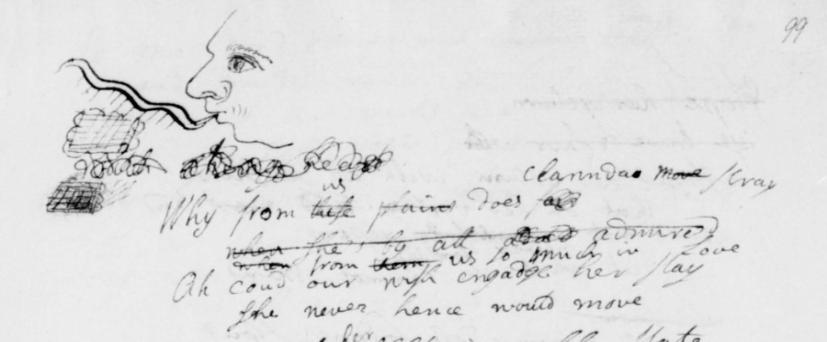
The collation notes here include all changes and cancelled lines, as well as a note on the doodle at the head of the page. For instance, Line 1 would note the following cancellations: ‘these plains’; ‘fair’; ‘move’. In Line 3 we would note the spelling variants ‘coud’ and ‘engadge’, whereas Line 4 is the same. Line 2 is also the same, but only after heavy revision, all of which would also be noted.
This is just a glimpse into the time-consuming work involved in dealing with Ramsay’s extensive poetic works. Sometimes we have to piece together fragments, or debate whether a transcript in another hand is a reliable ‘witness’ where no autograph manuscript survives. We usually err on the side of caution, but for works of Ramsay’s printed posthumously there are tough decisions being made all the time.
In the next few blogs we will share more updates on the typesetting work, which images we plan to use in the edition, and hopefully talk through some of the ways in which music and text will work together in what will be a landmark moment for Ramsay studies in The Gentle Shepherd (ie. vol. 1 of the forthcoming Edinburgh Edition of the Collected Works of Allan Ramsay).
Until then, stay safe!
CL
Blog 29: 27 February 2021
As we draw closer to Spring, the sights of The Gentle Shepherd become more crystal in the mind. Despite the ongoing restrictions, there is a sense of hope in the air, and the decent weather certainly helps. But it is not with idle fancy that we consider a stroll in Ramsay Country, though it would certainly combat what Brianna so aptly referred to in the previous blog as Zoom Fatigue. I am thinking so much about these familiar scenes because we are about to enter a very exciting phase in the project, with the final touches being added to the text and music of what will be volume one, over the next four weeks. Once the files are in and we have had the chance to review everything, Brianna and I will be turning our attention to typesetting the approved text. This is when we get a real glimpse of how our Edinburgh Edition of the Collected Works of Allan Ramsay will look. Spoiler: it's looking great!
If you want to read about The Gentle Shepherd in the meantime, why not have a browse through the recently published special issue of Studies in Scottish Literature (SSL), guest edited by Murray Pittock and myself.
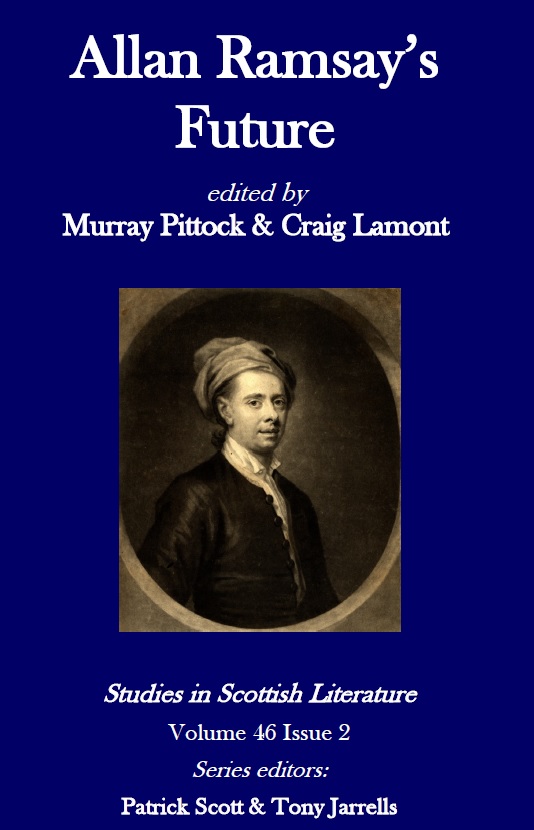
Cover of the SSL special issue on Ramsay
For the full journal, which is freely accessible, click here. Brianna offers an excellent bibliographical overview of the changes to GS from first printing in 1725 up to the famous Foulis edition of 1788. Steve Newman shows how the work engages with "pastoral improvement", and I offer another take on Ramsay and cultural memory, this time looking at the commemorations of GS in the Pentlands. The other contributions look at Romanticism, sociability, Latin, and Scots. You can expect a video looking at the special issue in more detail coming to the website soon!
And so the cogs of the Ramsay machine grind on. As Brianna and I prepare GS, Rhona Brown is making new strides with the Poems text, rounding off the 1728 collected poems and the Uncollected. Most repositories are still closed right now, but thankfully the bulk of the 1721 and 1728 manuscript material had already been consulted. These resources are so important to the edition and we are all looking forward to visiting libraries and archives again soon.
As of 1 March, we welcome a new colleague to our team!
Dr James J Caudle will be assisting with The Ever Green, one of the most linguistically intriguing of Ramsay’s works. Jim joins us from the AHRC-funded project ‘Editing Robert Burns for the 21st Century’ (PI: Gerard Carruthers), on which he will continue to work. Like Rhona and I, Jim will have a unique insight into the correspondence and poems of Burns and the world of Ramsay simultaneously. Living and working at each end of the eighteenth century, Ramsay and Burns’s frames of reference often converge, but in some cases are entirely their own. With Jim in place, we look forward to the latter stages of the research and editing, and the entirety of the edition taking shape.
Previously (from 2000–2017), Jim served as the Associate Editor of the Yale Boswell Editions. During his service there he collaborated with an international team of editors (including Murray Pittock), and helped to bring several volumes of James Boswell’s writings into print, including the General Correspondence 1757–1763, for which he received a co-editorial credit. More on Jim will be published in the Team section of the website in the next week!
In the background to our work on the edition, myself and Brianna have been working on a Scotnote on Ramsay. Scotnotes are study guides published by the Association of Scottish Literary Studies (ASLS). As the website states, ‘they are aimed at senior pupils in secondary schools and students in further education colleges and colleges of education.’ Previous Scotnotes have covered a wide range of Scottish literary figures from Robert Henryson (no. 11) to Robert Burns (no. 9) and Hugh MacDiarmid (15). Slotting Ramsay into the fray is an important step towards (re)establishing him in the canon. We will update you with more information on when this is likely to be published in due course.
Indeed, it is one of the general aims of our edition to showcase the importance and enduring worth of Ramsay’s works, and to consider just how much his legacy has changed between generations. We should not forget that Ramsay has aye been seen as a crucial figure in Scotland’s literary history, bridging the medieval era with the burgeoning age of Enlightenment. In a nineteenth-century Sketch of Ramsay’s life it is written that he ‘rose to a degree of popularity, which had been attained by no poet in Scotland since the days of Sir David Lindsay’!1
But enough scrieving, I’m awa back to reading Allan.
CL
______
(1) The Gentle Shepherd A Pastoral Comedy. By Allan Ramsay. With Sketch of the Author, and a Glossary of Scottish Words (Chicago: Fergus Printing Co., 1883), 5.
Blog 28: 22 January 2021
It is January and while we have been forced back into lockdown, the Ramsay team are still hard at work, creating, editing, and sharing our research. Indeed, we have all become relatively used to working from home and utilising the online space for teaching, research and socialising. Such changes have extended to conference activities and while some conferences opted to postpone in the hopes of holding a traditional in-person event, others opted to move online. One such conference was the British Society for Eighteenth-Century Studies (BSECS), which typical holds its annual conference in early January at St Hughes College, Oxford. The Ramsay team even presented at the conference in 2019, where we shared some of the preliminary findings from the Ramsay project. This year BSECS maintained its spot in the conference calendar by moving online.
For this conference, the Ramsay team prepared a different kind of presentation from the traditional 20-minute live paper preparation. We presented a 20-minute pre-recorded video that succinctly shared further details about the project to the BSECS community. Each of the editors discussed the editions they were working on and what has surprised them about the research so far. Our Principal Investigator, Professor Murray Pittock, also provided some insight into his inspiration for the project. Finally, Dr Craig Lamont and I discussed some of the public engagement activities we have been involved in including the recent exhibition at the National Library of Scotland and the annual Allan Ramsay Festival. This medium allowed the project team to quickly summarise important aspects of the project and, though each of the contributors were interviewed separately, similar considerations, questions, and themes emerged, revealing a delightful cohesiveness to the project as a whole.
Let me provide a brief overview of the BSECS 2021 online conference, which took place 6-8 January. This year, I was fortunate to have been asked to organise the BSECS annual conference and as such, I played a major role in moving it online. I already had some experience of organising and running an online conference in May, which gave me some insight into the benefits and challenges of hosting a large-scale online event. However, in May, using Zoom was still rather new for many people. Etiquettes for presenting live to an online community were only starting to form and we were only beginning to realise the importance of ensuring large-scale events were secure from the dreaded Zoom-bomber! By January 2021, there was more of a common understanding about how to use Zoom and what to do when presenting or attending a live online panel. That being said, I did make sure to send comprehensive guidance to all speakers and attendees so no one was left in the dark.
However, moving a conference online also comes with its own challenges and my BSECS colleagues and I realised that by January, many of our attendees may be struggling with Zoom fatigue, especially if they had just finished a semester of online teaching. There was also the question of accessibility, with our considerations centring on ensuring the conference was open to attendees across the world, who may have been juggling a variety of caring responsibilities in addition to their own workloads. I proposed that one of the conference days was asynchronous, giving attendees the opportunity to view pre-recorded content when convenient. We also uploaded the live panels from the previous day, allowing registered attendees to catch up on sessions that they might have missed – a BSECS iPlayer if you will! Incorporating an asynchronous day gave a bit of breathing space to those who may have struggled to engage with 3-days of live, synchronous content. It also allowed projects to submit new, pre-recorded video content that otherwise might not have suited a live, synchronous session. The Ramsay team took advantage of this opportunity and, as such, we were able to succinctly explain and show material that likely would have taken much longer to express in a live session.
The video proved popular obtaining 131 views in the two-weeks it was available to watch, and it was the most viewed video on the BSECS channel. Unfortunately, the BSECS 2021 conference videos are no longer available, but we have migrated The Collected Works of Allan Ramsay Virtual Tour video to our own Ramsay channel, where it is publicly available to watch. I have embedded a link to the video below. In the meantime, the Ramsay team continue to press on with the project. We are especially looking forward to hitting our next major milestone in the spring, when we hope to begin typesetting The Gentle Shepherd.
The Collected Works of Allan Ramsay Virtual Tour video: https://youtu.be/qFxhUFQkzuw
BRK
Blog 27: 31 December 2020
What a strange year 2020 has been! In January, we had so many in-person events planned that would have allowed us to discuss and share our progress on the project. We had no idea that just a few months later, we would be confined to our homes for most of the year. Like so many, the team have had to readjust to a new way of working, where digitisation is imperative, meetings are held on Zoom, and events are reconceived for a digital platform. In this blog, Craig and Brianna will reflect on how the team have adjusted to working from home and how we have continued to move forward with the project despite the unexpected turbulence 2020 has thrown at us.
Exhibition
The plan for a Ramsay exhibition at the NLS had been in the works for several years, but the real planning and organising of the event started in 2019. In the first few months of 2020, we finalise the items we wanted to include, we had written the exhibition display information and additional content for the NLS website. We had even planned the opening event, due to take place in March, just a few weeks after the exhibition had opened. “Allan Ramsay: Writing the Scots Enlightenment” was successfully unveiled on the 18th February, but was forced to close early when the country went into lockdown in March.
Over the next few weeks, we hoped lockdown would end and the country would return to normal, but we quickly realised that would not be the case. Instead, we considered creating a virtual tour of the exhibition, a video that would capture the items in situ. With the help of Dr Ralph McLean, Manuscripts Curator (Long 18th Century Collections), we planned a new way of presenting the exhibition so it could be enjoyed digitally. In past blogs, we have already reflected on our process of organising (4 August) and creating the video of the exhibition (7 September), and if you would like to see the video, it is available to watch at this link. While it is shame that the exhibition was only open for a short time and we were unable to celebrate it in-person, the video has allowed us to capture the display and share it to our wider community.
Poems Uncollected
Working on Ramsay’s poetry is a real privilege. As an RA at the coalface of his draft verse, you get a sense of everything from his inconsistent spelling to his unusual reordering of words on lines. After all the manuscript sleuthing you compare your notes against the final, printed version of any one poem. Before this year, I’d been working on his first two books of Poems (1721; 1728). It was hardly ‘easy’ work, but there was a rhythm and a flow to it: track the history of each poem for each volume backwards, and prepare notes for the editor to prepare a final text. In 2020 we turned to the ‘uncollected’ poems which is, as you have guessed, all of Ramsay’s poems not collected in an authorised edition. So, everything we know to be Ramsay’s – in manuscript or in print – not yet dealt with. At the end of May we completed as full a run of these as lockdown-life allowed. Pending access to some archives, the job is more or less done.
The first item is A Poem to the Memory of the Famous Archbald [sic] Pitcairn, M.D. No MS survives, but the printed text can be seen in the NLS. Most of the ‘difficult’ work comes from transcribing the draft poems and fragments found in the British Library’s Egerton 2023 MS. Some of these are untitled, with lines indicating a change of mind, or that they belong as part of another poem: things like that. Very footery work to say the least. Finishing this in the summer was a major milestone for the project.
GS
We are entering the final stages of editing The Gentle Shepherd and much of the work carried out by us research assistants, has been gathering the final pieces of archival material for the editors. We also started sampling small sections of the edition, in preparation for setting the whole text in March 2021. Craig reflected on some of the gathering work he has been doing for GS in the November blog.
We have also been in touch with EUP to sample the size of the margins and the layout of the text. Typesetting properly begins next year, so we wanted to get a head start on this to iron out any creases in the design. We had to be mindful that the two volumes of Ramsay’s Poems will be larger than this Gentle Shepherd volume, so negotiating the margins to ensure we have a consistent style across the entire edition to accommodate different elements is key. It is an exciting time, to see what the final version will look like when it’s printed!
TTM
It has been an enjoyable and exciting challenge mapping the musical and textual archaeology of the four volumes of The Tea-Table Miscellany. The process started in 2018 and is now mostly complete with some really interesting findings emerging. The project team cannot share specific details until the edition is published, but the amount of literary, musical and theatrical material Ramsay was drawing on to create TTM demonstrates the extent of his knowledge and networks. If Ramsay were at the centre, what unravels from him is a complex, interconnected system, which spans both place and time. While the initial gathering process is complete, there is still more work to be done on the edition in the coming year and we will be sure to update you on our progress!
Libraries
Many of our recent blogs have focussed on the reopening of libraries during the difficult ongoing situation with Covid-19. Thankfully, with most of the Ramsay material held in the National Library of Scotland, we’ve been able to get back in to see various printed and manuscript sources for verification purposes. Most other libraries and archives have reopened, but regardless of the different conditions these institutions can operate under, one thing has been made clear: digital orders are more important than ever. While we can’t travel as freely, asking the British Library or the Bodleian to send scans of a specific item is our best option. Even some Scottish libraries will be able to facilitate us in this way. As 2021 unfolds we will be sure to keep you up to date with how this part of the job is going.
Conclusion
And so we come to an end of the very strange year of 2020. Every one of us has been affected in some way, and we thank the people who are working to keep things ticking over: from retail workers to nurses to bus drivers. As with any team project at a University, we are all working to the same goals, though our teaching and research commitments are not always even. And so we are also grateful to the ongoing efforts of our teachers, tutors, and colleagues for working tirelessly to make university life as normal as can be. In Ramsay’s day, when he leafed through the pages of the Bannatyne Manuscript, he would have seen the phrase ‘in tyme of pest’, written there in the year 1568. Here’s hoping by the time we provide another end of year blog, the hardships of 2020 are a thing of the past, too.
BRK & CL
Blog 26: 27 November 2020
For the majority of the year we have been working in a very new and unexpected way, mostly from home and with the help of our colleagues. Such is the nature of team work at the best of times, but in this unusual year this has been increasingly important. Next month, Brianna and I will look back on the whole journey of 2020, from lockdown to re-emergence to re-lockdown. The important thing is that we are still able to collaborate and make progress. Perhaps in another era, without the same technology, this would simply not have been possible.
In Blog 24, I wrote about how nice it was to return to the National Library of Scotland to check some details in the Fair Copy of The Gentle Shepherd (MS 15972). Since then I have actually been back to see this manuscript again, as well as the three ‘draft’ manuscripts of the drama, bound together in one impressive volume at the Centre for Research Collections at the University of Edinburgh (MS Laing.II.212*). As we edge closer to finalizing the text of The Gentle Shepherd it is important that any doubts in our notes are vanquished, so we have to go into the edges of the volumes themselves. As the image below shows, the words ‘Morn’ and ‘Pool’ are partially obscured with tape.
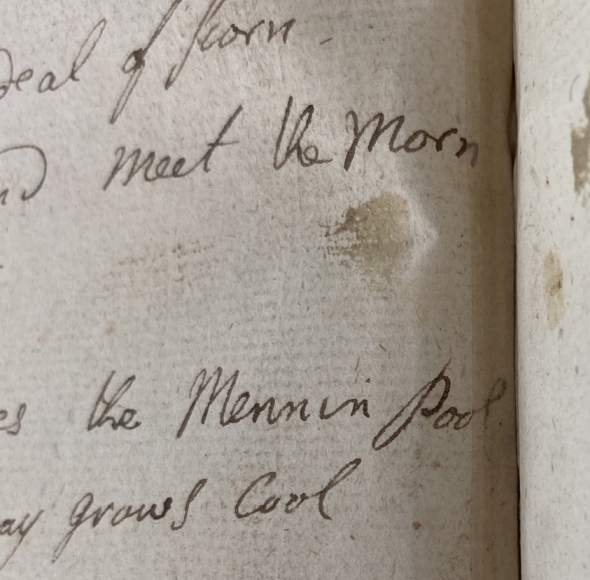
This sometimes happens with printed works as well. Take The Tea-Table Miscellany of 1729 for example (ie. Volume Second, Fifth Edition, printed in Edinburgh). The series of sangs therein (at p. 169) correspond to the formation of The Gentle Shepherd as a ballad opera. During restricted access to libraries, we rely more than ever on digital resources such as ECCO (HistoricalTexts). Sometimes, though, these smaller books are badly (re)bound, and so the scanning can only offer 95% of the text. As is always the case, then, we need a hybrid approach of digital facsimiles and access to the objects themselves, to carefully look closer to the binding and see the questionable word in full. Thankfully we were able to do this during the course of 2020.
Sometimes, the checks we need to do come down to just one letter. In the 1728 printing of the play, within Ramsay’s second volume of Poems (1728), the available digital scans seemed to bear the word ‘On’ at the very beginning of p. 310. Steve Newman had his doubts, however, and so I checked 3x copies of the book, finding the word ‘Or’. The full line is ‘Or the full Banquet when we feast our Soul’, and so you can understand how ‘On’ was a likely choice at one point. Whether it was simply a smudge on the scan, or a scanning error of some kind, these things do happen and in our edition we are aiming for the utmost accuracy.
Feeling a sense of inevitability regarding another lockdown while I was there, I was sure to make some notes on the other copies of Poems (1728) I had ordered up. One in particular (L. C. 1149) has become a sort of scrapbook in its own right. On first glance it is like any good copy of the book, but once you get through it you can find inset illustrations. They are far too small for the size of the page, and a note in the catalogue suggests they belong instead to a 1797 edition of Ramsay. According to Burns Martin, this would be The Poems of Allan Ramsay. With an Account of his Life and Writings, &c. And a Glossary. In Two Volumes. Embellished with Superb Engravings. The publishers were Stewart and Meikle of Glasgow, whose names are most often associated with the late eighteenth-century chapbooks of Robert Burns [1]. What makes this copy of Ramsay’s book even more intriguing is the facsimile attached to the endpapers, of the autograph manuscript ‘Verses addrest to the Mavis Well which flows into the Gardens of Mavis Bank’. The real deal can be found in the NLS, too (MS 15973, f. 8). As it happens, this poem will be included in the ‘Uncollected’ section of our forthcoming Poems volumes (ed. Rhona Brown).
I may not be visiting the Edinburgh libraries for a few weeks, or perhaps even until the new year. Our progress on the edition will continue regardless, as we prepare to begin typesetting volume 1.
Until next month, stay safe.
CL
[1] In the forthcoming edition of the Burns Chronicle, Craig has an article about these Stewart & Miekle chapbooks, with a note about their edition of Ramsay.
Blog 25: 15 October 2020
Today is oor ol’ bard’s 334th birthday! Normally we would mark the event at the annual Allan Ramsay Festival, which for the last four years has taken place at the Allan Ramsay Hotel in Carlops. Owner, Rosemary Brown, has driven the organisation of past festivals and is keen for it to continue in future; however, the events of 2020 mean we cannot meet together to enjoy Ramsay-related festivities and feasting. Never fear, I thought this would be a good opportunity to look back at previous festivals and hopefully we can have an extra special celebration in 2021 for Ramsay’s 335thbirthday.
The First Allan Ramsay Festival, 14th-16th October 2016
The inaugural festival was a three-day event, complete with an exhibition, an Evening of Ramsay’s Music and Poetry, Guided Walks to the ‘Scenery of The Gentle Shepherd’, a talk entitled ‘Five Things Allan Ramsay gave Scotland in the Seventy Years of his Life’ delivered by Professor Murray Pittock, and a Celebratory Dinner. It was quite fitting that ‘The Allan Ramsay Historic Environment Scotland Plaque’ was unveiled on Ramsay’s birthday.
The first night really established the celebratory mood, with music played by the Carlops Players with Les Morss & Murray Campbell, followed by a late-night Scottish Folk Music session with local, Edinburgh-based band The Cauldstaneslap.
The Guided Walks given by Dean Woodhouse and Dr Patsy Campbell showcased the beauty of the surrounding Carlops countryside, and revived a popular past-time, where Gentle Shepherd enthusiasts would follow the countryside trails to picturesque sites, which are said to have inspired Ramsay’s popular work. The exhibition, still on display in the Allan Ramsay Hotel, includes images of people from the late 19th/early 20th century lounging at Habbie’s Howe. The trail maps, created by Dean Woodhouse, are available on the Hotel website. Also, if any readers are keen to see the exhibition materials from 2016, they are also on the website, along with the Festival Programme and more details about the history of the hotel.
Finally, Professor Murray Pittock delivered a wonderful ‘Toast to the Immortal Memory of Allan Ramsay’.
The Second Allan Ramsay Festival, 14th October 2017
Though the second festival was a one-day event, it was still jam-packed with talks, walks and feasting (sorry, I couldn’t continue the rhyme!). The new ‘Ramsay Edinburgh Heritage Trail’ map was released, allowing visitors to walk the streets and paths Ramsay may have taken when he lived and worked in Edinburgh. The trail map is still available on the Hotel website.
Lucinda Lax, curator of 18th-century art at the Scottish National Portrait Gallery in Edinburgh, delivered an excellent presentation at Penicuik House, which is just a few miles from The Allan Ramsay Hotel. The Ramsay Obelisk, erected by Sir James Clerk, 3rd Baronet to the memory of Allan Ramsay, is visible from the grounds of Penicuik House.
Billy Kay gave an enjoyable talk entitled, ‘Knee Deep in Claret’ and Professor Murray Pittock, once again delivered ‘A Toast to the Immortal Memory of Allan Ramsay’.
The Third Allan Ramsay Festival, 12th-13th October 2018
The two-day event was themed around the music and dancing from The Gentle Shepherd. Concerto Caledonia led the first Allan Ramsay Ceilidh, complete with 18th-century country dances set to tunes from the period. The beauty of these dances is that they are a little slower in pace than the more modern ceilidh dances, so anyone can get involved. We also benefitted from Aaron McGregor’s expertise as he carefully walked us the through the more unusual 18th-century country dance steps.
At the Celebratory Dinner, we were treated to scenes from The Gentle Shepherd, performed by Mhairi Lawson, Iona Fyfe, Scott Gardiner and Concerto Caledonia. Professor Murray Pittock expertly delivered ‘A Toast to Ramsay’s Immortal Memory’ and we welcomed back Billy Kay, who blew out Ramsay’s birthday candles. If readers are keen to read more about the 2018 festival, there is a , which includes a few pictures and a video of the ceilidh dancing.
The Fourth Allan Ramsay Festival, 18th-19th October 2019
This brings us to last year, when the festival took place over two days and had bit more of ‘folk’ twist. Those who attended the ceilidh the previous year really enjoyed the more informal, 18th-century flavoured event, and Rosemary was keen to curate a similar evening. The Allan Ramsay’s “Easy Club” Folk Night was held on the Friday, led by story-teller John Nichol and friends. Throughout the evening, guests were treated to stories and songs.
Saturday was jam-packed with workshops and entertainment including borders fiddling, borders pipes, music, song and story-telling, followed by the Celebratory Dinner and concert hosted by Professor Fred Freeman (RCS) and John Moran.
Until we meet again…
The Allan Ramsay Festival has become a fun-filled, annual event and it is a real shame we cannot celebrate at the event again this year. However, the hotel is doing some really important community work and have fantastic resources on their website that provide more insight into Ramsay’s connections to Carlops and Edinburgh.
If readers are really missing Ramsay content, The Collected Works of Allan Ramsay website also includes detailed information about Ramsay’s Reception, his writing, songs and music related to Ramsay’s work, our knowledge exchange partnerships, and updates on what the team are currently working on.
To finish, let’s raise a glass to Allan Ramsay and celebrate his astonishing contribution to Scotland’s history.
BRK
Blog 24: 7 September 2020
In this collaborative diary blog, Craig and Brianna reflect on their visits to the NLS and making the ‘Allan Ramsay: Writing the Scots Enlightenment’ exhibition video. If you would like to read a more in-depth blog about video and the exhibition display, please
Friday, 4 September

Craig outside the NLS, pleased with the weather, taking in a gulp of air before putting on his mask.
Life in Scotland has a semblance of the old normality we’d perhaps taken for granted. We are not back in the University offices quite yet but we’re still working hard on the project and we’re getting to the National Library of Scotland for some crucial consultations. I’m (Craig) heading to the NLS today, right now (9am), to double check some details in the fair copy Gentle Shepherd manuscript (ie. MS 15972). I’ve also ordered up some newspapers in which a select few Ramsay poems appeared for the first time, to check against other manuscript sources in the ‘uncollected’ section of the forthcoming Poems volume.
With Greater Glasgow in a ‘no household visits’ lockdown, and with the residents of Aberdeen having already been through tougher restrictions, it feels all the more important to have these opportunities to travel and work at our (second) favourite place in Scotland. This will be my second visit to the NLS since reopening and I really have to commend them for the way they’ve handled it. The staff have been excellent and the signage is laid out very clearly. My thanks also to Jamie McIntosh from special collections, who emailed me with detailed instructions on the slightly tricky business of ordering and consulting a range of newspapers during the new regulations (the different sizes, microfilm options etc).
Today’s visit will be another step forward, then, for both the Gentle Shepherd and Poems section of the edition, following a fruitful video call yesterday with Brianna and the two GS editors Steve and David. I’d also spoken to Rhona, Poems editor, so it’s been a good week for Ramsay progress. The appointments at the NLS are so in-demand that Brianna will be visiting tomorrow (Saturday) for her own consultations.
Of course, we did get to see the NLS ‘behind closed doors’ at the end of July, to carry out the filming for the past display, ‘Allan Ramsay: Writing the Scots Enlightenment’. The resulting video is now live, and you can watch it for yourself here!
Saturday, 5 September
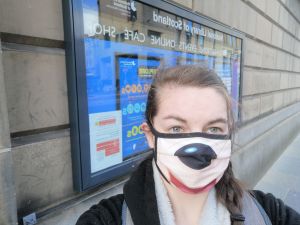
Brianna outside the NLS, sporting her Mickey mask!
Editing this video was a lot of fun, in part because I (Brianna) got to relive the experience of filming it. It was a pleasure taking an even closer look at the display (albeit through a camera-eye view). Robert James, who recorded the video, did a wonderful job capturing all of the items both on video and still images, especially while working in difficult circumstances. I am not speaking about the pandemic, but rather filming in a darkened room with lots of reflective glass! The display has been taken down at the NLS, but I am so pleased we were able to preserve it in video form.
I am also excited to be back to the NLS. In fact, just like Craig, I am writing this blog from the comfort of the Special Collections reading room, where I am taking a short break from looking at 17thand early 18th-century music manuscripts. Even at the weekend, the NLS team are working hard to ensure working in the library is running efficiently while also following appropriate safety measures.
August was a really exciting month and we are looking forward to the start of the teaching term September.
BRK & CL
Blog 23: 4 August 2020
Scotland is finally emerging from lockdown, and while it is important, we remain diligent to follow government advice in the coming weeks, the Ramsay team are hopeful to return to some normality. The National Library of Scotland (NLS), one of our partners on the Ramsay project, are planning to re-open soon, albeit with new measures in place. Craig and Brianna were fortunate to gain access to the ‘Allan Ramsay: Writing the Scots Enlightenment’ exhibition on display at the NLS, to capture images and produce a short film before the display is taken down in time for the library re-opening. The exhibition was due to run from 18 February until the 16 May 2020, but was forced to close early due to Covid-19. It explored a range of themes including Ramsay's talent for verse and drama, his influence in reviving the Scots language, his passion for theatre and music and his relationship with his son, and showcased some of the most significant and beautiful items pertinent to Ramsay’s story. The team recognised many Ramsay enthusiasts would not have had the opportunity to see this exhibition in situ. With this in mind, we were keen to reimagine it in another format so it can still be shared publicly. The video will be made available shortly, but in this blog Craig and Brianna will reflect on why they selected some of the items for the exhibition.
The Four Sections
The display area selected for the exhibition was relatively small, so we wanted to explore a range of themes that would explain Ramsay’s multifaceted career as well as key family and friend connections. We settled on four key sections ‘Poetry’, ‘Music’, ‘Drama’ and ‘Ramsay and his Son’. In each section, some of the items are intrinsically linked, showcasing the interconnectedness of Ramsay’s activities and networks.
Music
This blog series has regularly highlighted the importance of music in Ramsay’s work, but also the issues this area presents since Ramsay only printed one book with music notation, Alexander Stuart’s Musick for Allan Ramsay's Collection of Scots Songs (1726?).
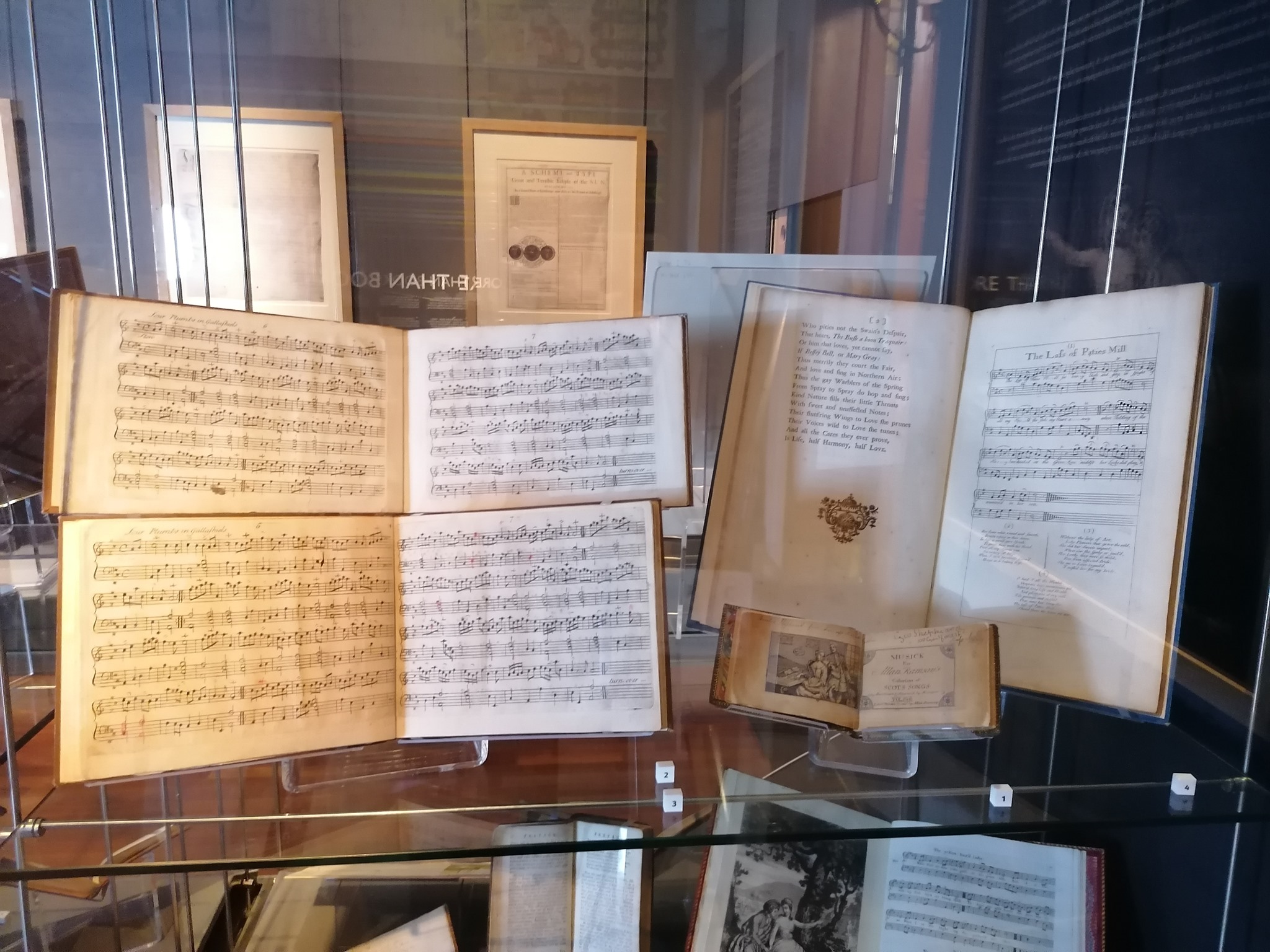
Figure 1: Music display, top shelf
However, within the exhibition, we were able to display some of the music books with the popularly-known tunes Ramsay referred to in his Tea-Table Miscellany and Gentle Shepherd. One example is Adam Craig’s A collection of the choicest Scots tunes (1727 & 1730). Incidentally, Craig and Stuart were colleagues employed by the Edinburgh Musical Society. Both of their music books were engraved by Richard Cooper (1701-1764), who also engraved a portrait of Ramsay, published in second subscriber's edition of his Poems, Vol. II, Edinburgh (1728) (see Rock, ND).
It was also important to display the first edition of The Gentle Shepherd that printed music notation for the songs. John Robertson produced a tiny pocket book edition of the ballad opera in 1758, and at the back the music notation for the songs tunes are printed (albeit without the lyrics underlaid).
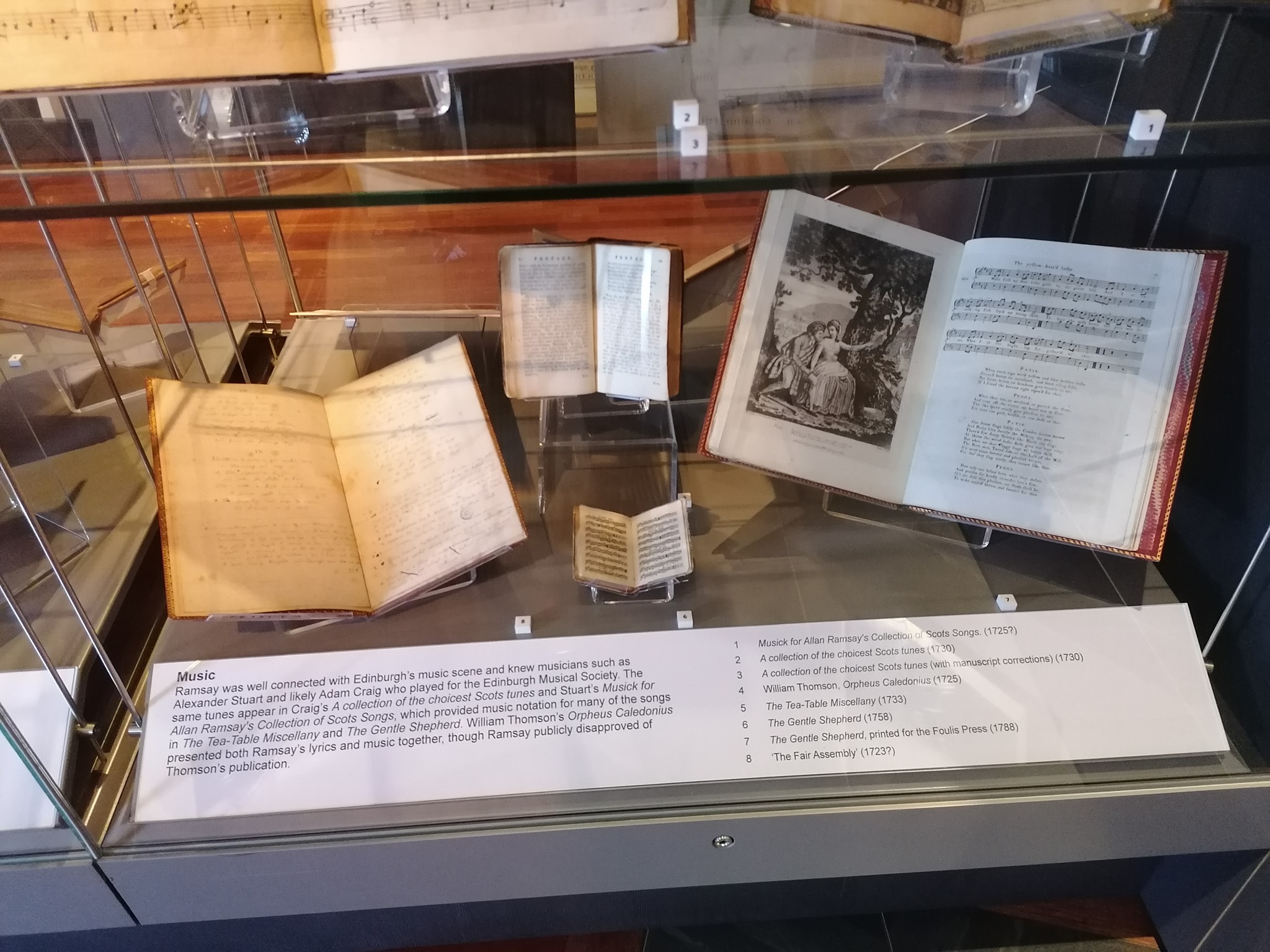
Figure 2: Music display, bottom shelf. The Robertson edition is the tiny pocket book in the centre of the display.
This is quite different from the expensive edition of The Gentle Shepherd produced by Andrew Foulis in 1788, which printed fully notated musical accompaniments, and underlaid lyrics (left of the Robertson edition in the display).
This demonstrates how the presentation of Ramsay’s Gentle Shepherd continued to evolve after the author’s death in 1758.
Drama
Though editions of The Gentle Shepherd appear in the music section, it would be remiss if it wasn’t mentioned in the section dedicated to drama. Here, we were able to display the beautiful ‘Fair Copy MS’, which includes Ramsay’s comical illustrations, alongside the first edition of the play published in 1725.
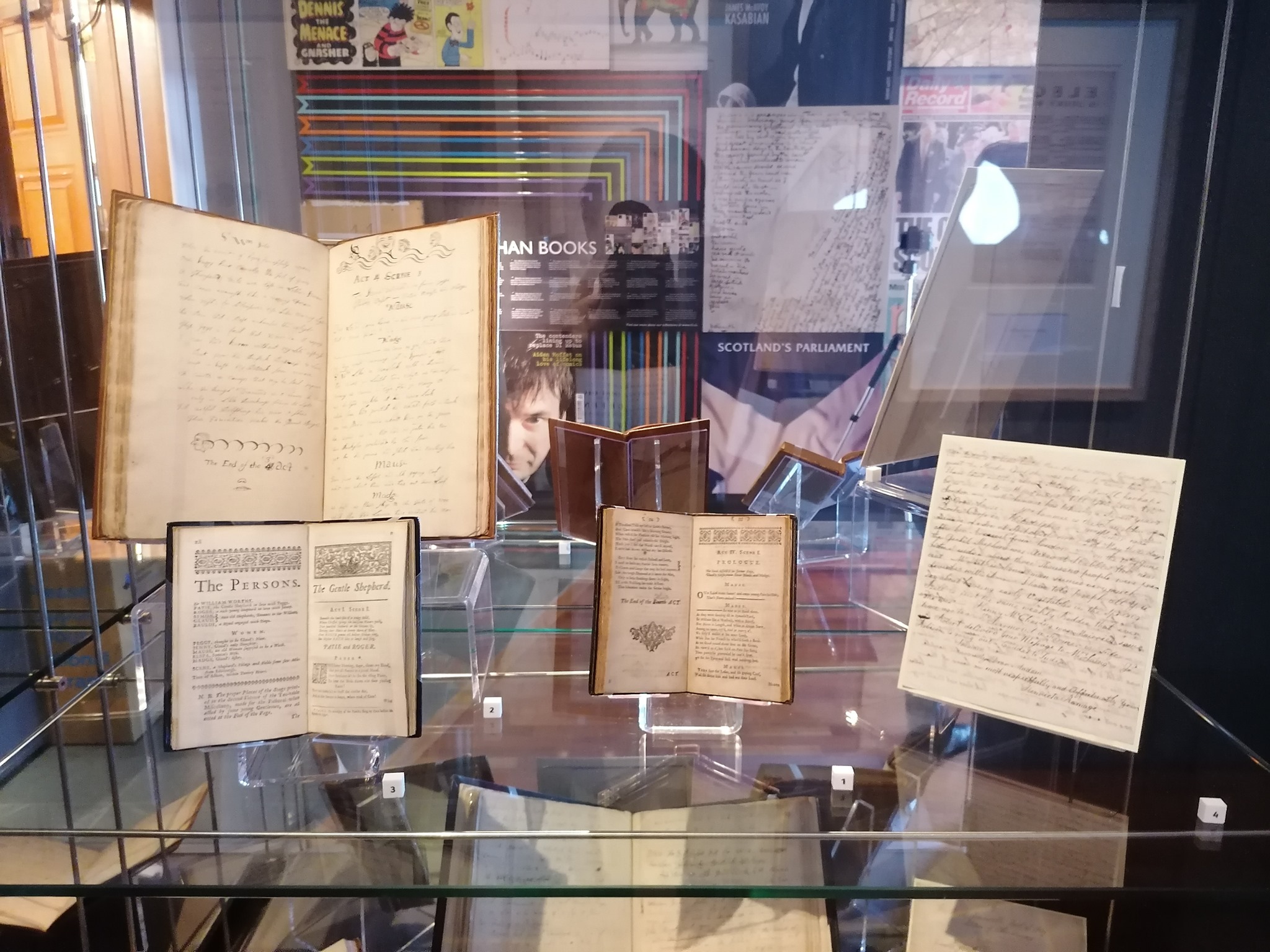
Figure 3: Drama display, top shelf. The Fair Copy (1725) appears in the top left corner of the display.
However, Ramsay’s investment in drama and theatre extended far beyond his authoring a play and ballad opera. He opened his own theatre at Carruber’s Close in 1736, where Farquhar The Virgin Unmask’d or An Old Man Taught Wisdom was performed and he advocated for the protection of the theatre for most of his life. ‘Ramsay’s defence of the Theatre as an art form’ and his ‘petition to Lord Milton’ are just two examples of his campaigning to defend theatre in Scotland.
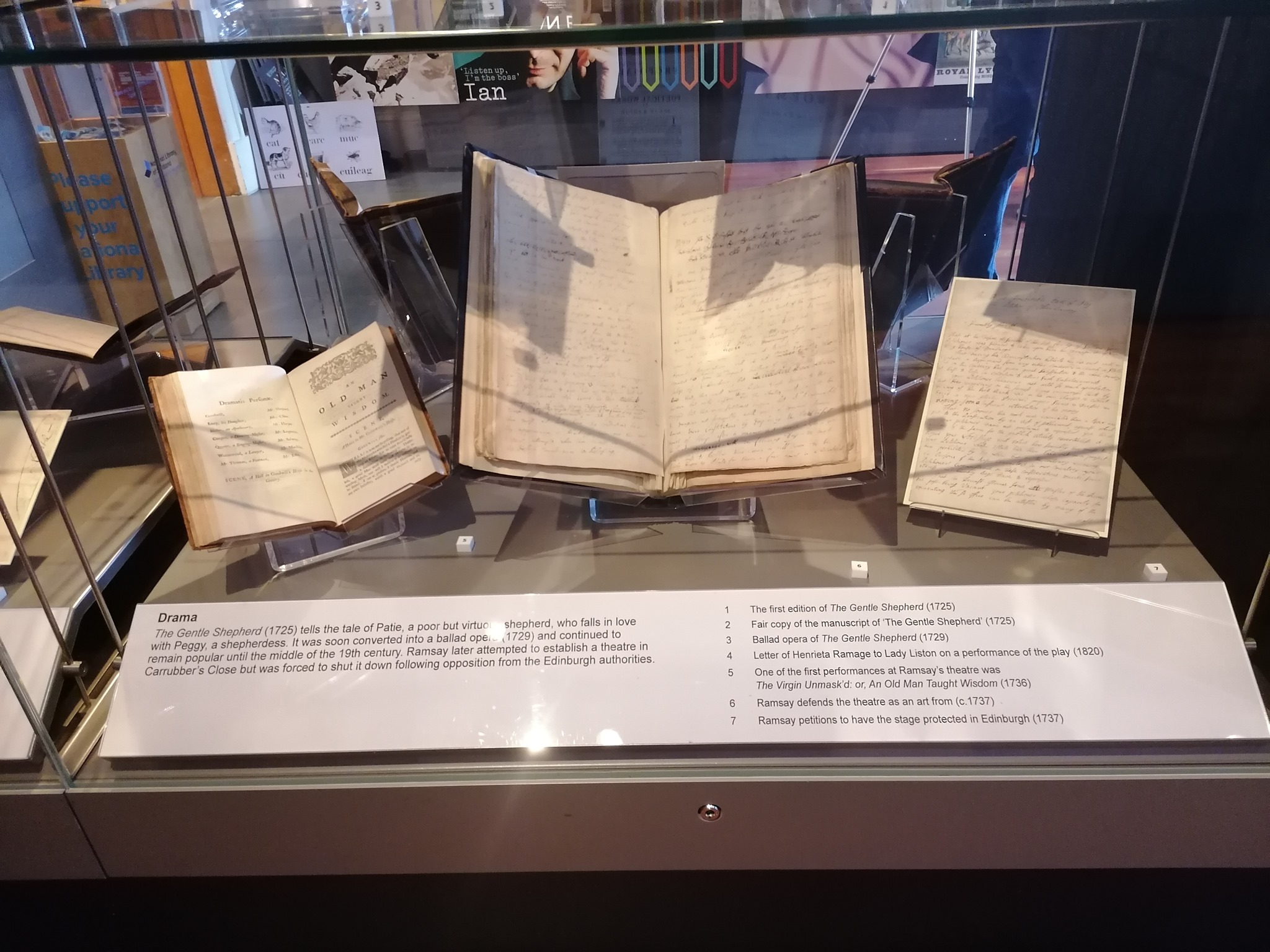
Figure 4: Drama display, bottom shelf.
Poetry
Ramsay’s activity as a poet was difficult to encapsulate in the limited space of an exhibition, but the items we selected for display represent some of the most crucial moments. On the back wall were Ramsay’s 1710 Burgess ticket for Edinburgh and two broadsides, Elegy on Lucky Wood (1718), and A Scheme and Type of the Great and Terrible Eclipse of the Sun (1715). We covered the latter in Blog #21. These represent Ramsay’s presence in popular print.
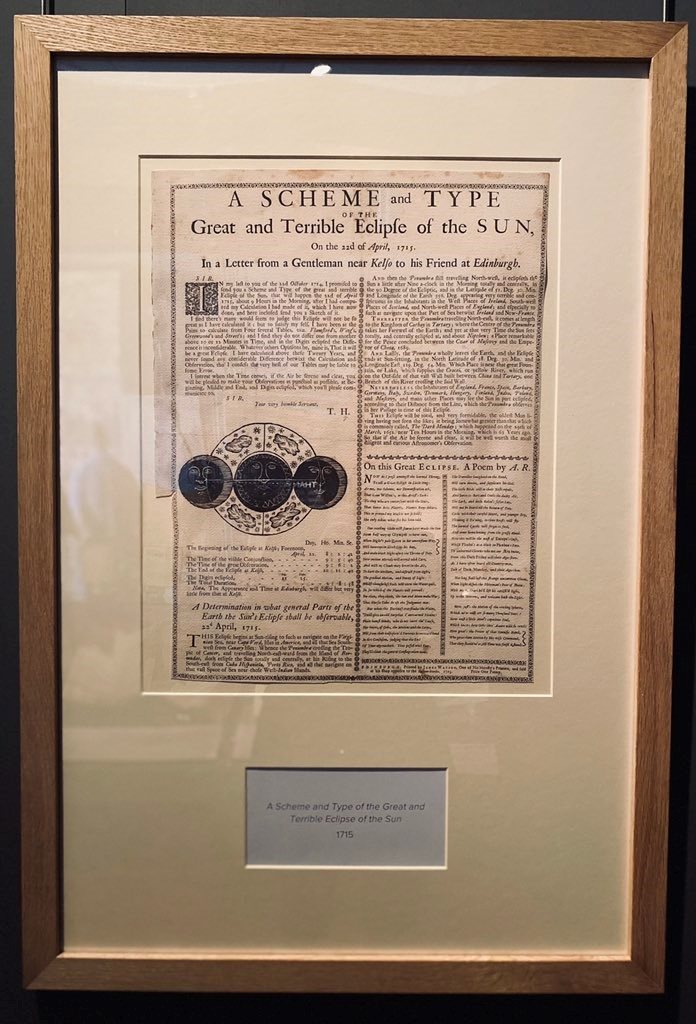
Figure 5: A rare Ramsay poem found in a broadside.
Beside this, it was crucial to show the 1720 Subscription List for the Poetical Works of Allan Ramsay. As our new edition will show, a book by Ramsay titled Poems can be found in archives bearing the date ‘1720’, as if to indicate this as the date of publication for his first book-length production. But, almost invariably, the contents of this book are actually comprised of other chapbooks to give the appearance of a complete and finished work. But as the Subscription List shows, it is more likely that the 1721 edition of Poems, also on display, was the first ‘authorised’ version, for, unlike the 1720 book, it included a list of subscribers inside.
We also wanted to show some examples of Ramsay’s manuscript poems, and so we included Ramsay’s acrostic poem on Mary Sleigh (c. 1724) and his inscription in the Banntyne manuscript (1726). In the latter, Ramsay essentially composes some verse in praise of the wonders of the old Scots poems found in the Bannatyne, while connecting his reading of it to the production of The Ever Green (2 vols, 1724), which we also put on display.
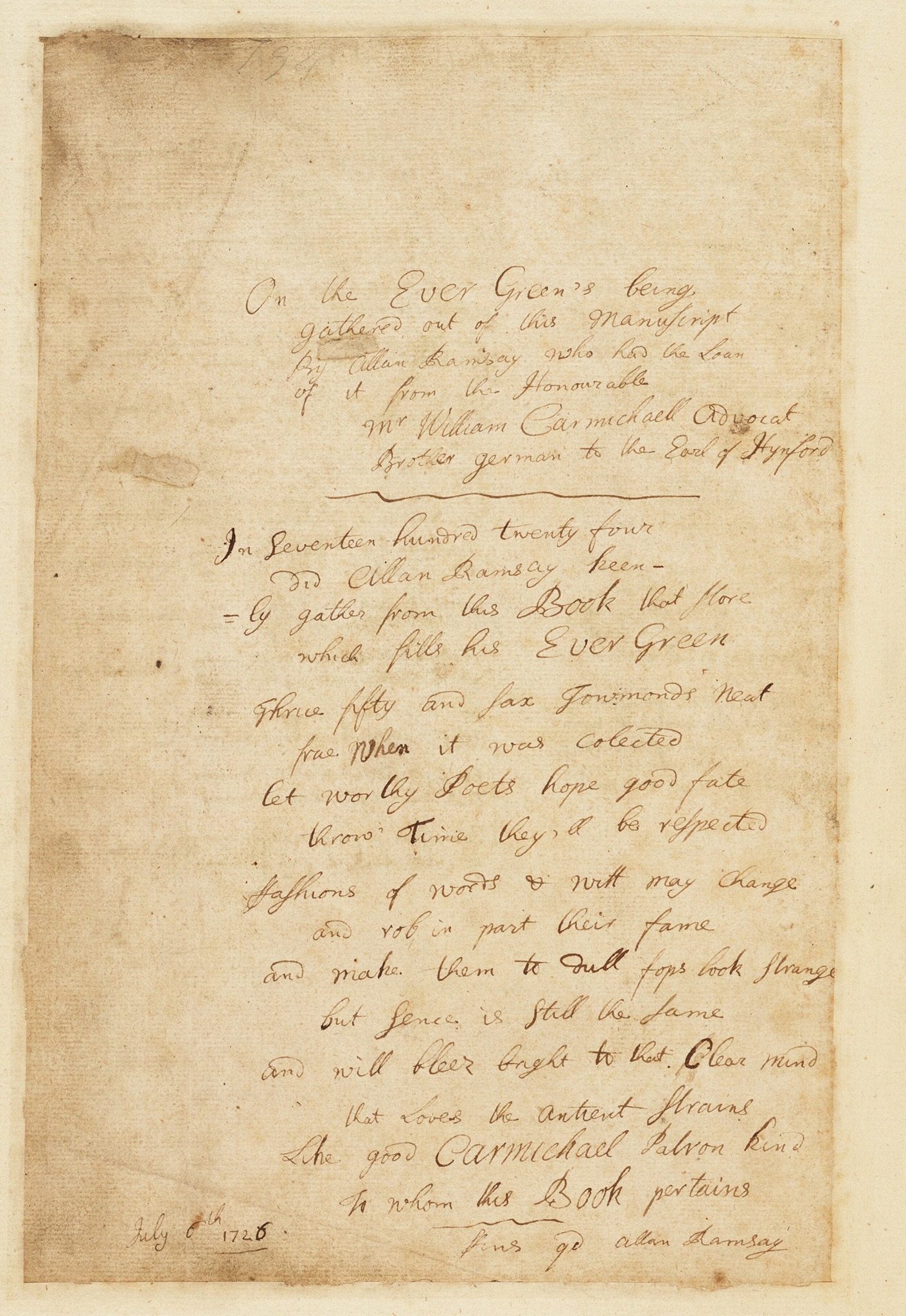
Figure 6: Ramsay’s inscription in the Bannatyne MS (Adv. MS. 1. 1. 6, f. 374v)
Ramsay and his Son
Ramsay’s son of the same name is best known as a portrait painter, and his contribution to the culture of the Scottish Enlightenment has given him a unique place. But we wanted to offer a view of his father’s role in his life during our display. In a letter to Patrick Lindsay dated 5 April 1735, Ramsay senior boasts about his son’s talents in painting and lays out his wishes for a tour of Italy to improve his skills. In the NLS there can only be found Ramsay Junior’s Neapolitan passport (1737), which was also on display.
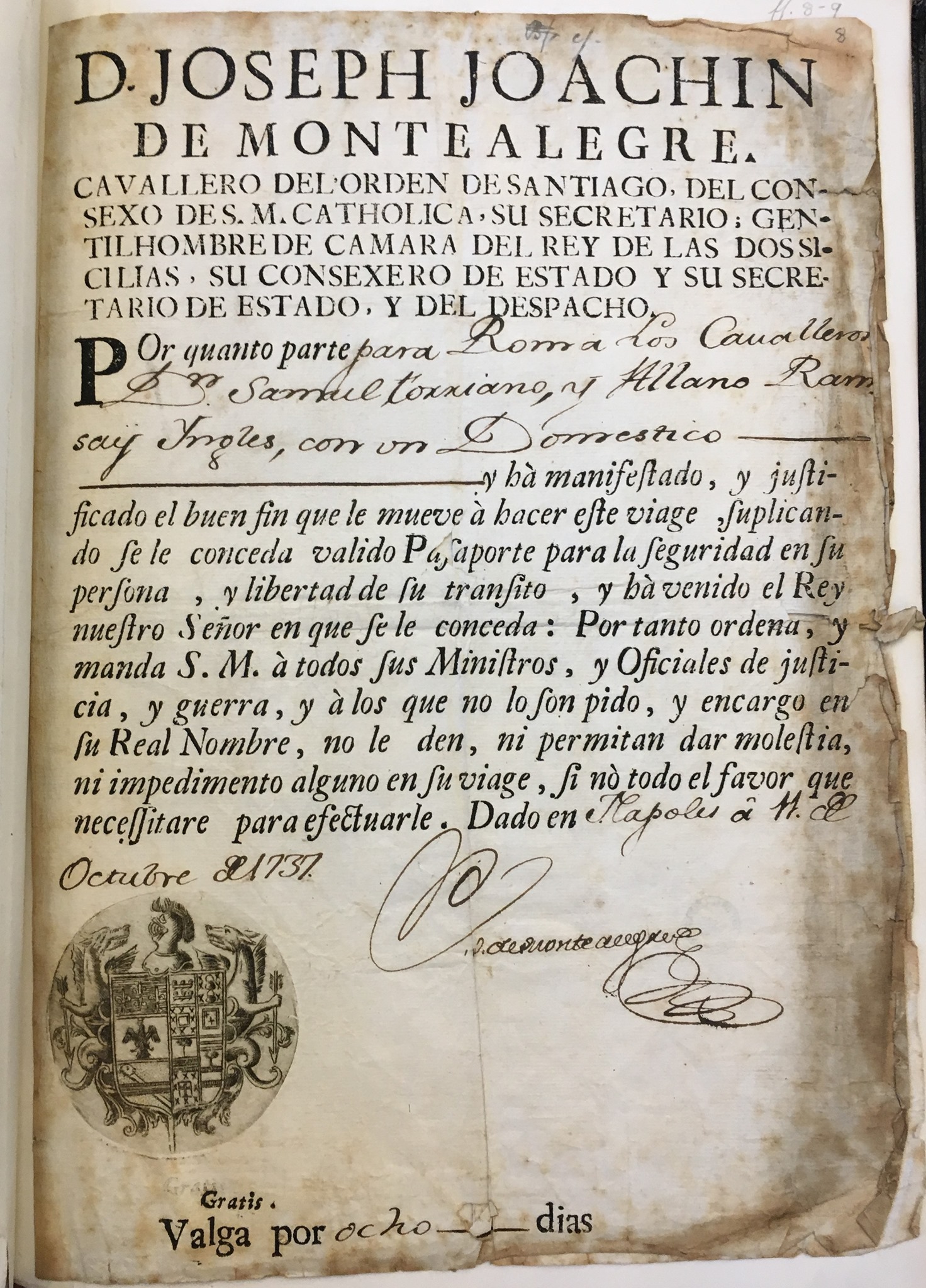
Figure 7: The Neapolitan Passport for Allan Ramsay, junior (MS 3421, f. 8)
Dr Ralph McLean also picked out, from William Hughan’s The Jacobite Lodge at Rome (1910) the evidence of Ramsay junior meeting Jacobite exiles while abroad. And finally, it was very pleasing to have on display the Plan of the Goose-pie house.
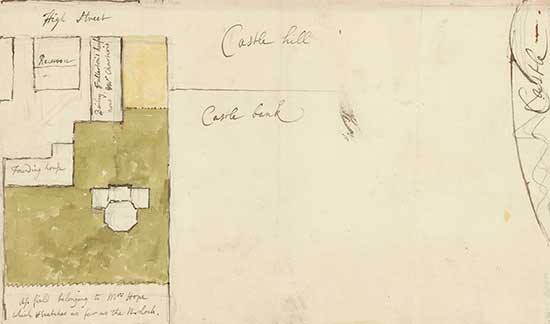
Figure 8: Design of the Goose-pie house, c. 1733 (MS. 9994 ff. 101)
This plan shows the location of the house on Castle hill, and in the forthcoming film, Dr McLean explains that the name is in reference to the shape of the building, being similar to a pie tin. Ramsay junior took ownership of the property around 1741, staying in the family home his father had built rather than moving to the New Town, which he could likely have afforded!
Conclusion
For all of us, 2020 has been a difficult year, largely defined by the global pandemic and having to adjust our ways of living and working. For those who did not get the chance to see ‘Allan Ramsay: Writing the Scots Enlightenment’, and for those who only managed a quick look, we hope that this blog brings you closer to the material. By covering the four sections with some examples, we tried to encapsulate more about Ramsay’s life than was commonly known. Of course, nothing quite beats the real thing: which is why we are working on a short film to give you an even closer look at the display area and the objects themselves. Keep an eye out on social media, where we will soon announce details of this. Thank you for reading.
CL & BRK
References
Rock, Joe. (ND). Richard Cooper - life chronology, Richard Cooper Engraver, Available from here.
Blog 22: 31 July 2020
Screen’d in my walls, you may bleak winter shun,
And, for a while, forgot the distant sun;
My blazing fires, bright lamps, and sparkling wine,
As summer sun shall warm, like him shall shine.
Spring has been uncharacteristically beautiful and it seems the nice weather will continue into the summer. Had this been any other year, families and friends would be gathering in gardens, parks, beaches and cities for BBQs, drinks and general socialising. Just as Ramsay reflected in his 1718 ‘Edinburgh’s Address to the Country’, the summer months are a much-needed change from the bleak and isolating Scottish winters. Yet, we live in unprecedented times. Public spaces are no longer places to flock. BBQs and drinks are shared only between those who already reside in the same home. Socialising with anyone else is only made possible with cameras, screens and a stable internet connection. For 10 weeks we have lived in unusual circumstances, and while it isn’t exactly “normal” we have all had to adjust our methods of working as well as home life.
In this blog, I wanted to reflect on research methods while working from home. I am so grateful for the many excellent databases and resources online and these are the only reason why I have been able to continue my research during lockdown.
So, what have I been working on?
I have finally made it to the last volume of The Tea-Table Miscellany (hence TTM4) and it is already shaping up to be an interesting volume. Not only is it longer than the other three volumes but it is an odd mix of old and new material. In short, the edition will have plenty to discuss. I have also been preparing an article for a special edition of Studies in Scottish Literature. Unfortunately, my original plan for an article had to be put to one side after realising the National Library of Scotland would be closed for the foreseeable future. Though many items in the NLS collection have been digitised, the sources I needed have not. But there are still plenty of Ramsay-related issues that need addressing and my new idea for an article is coming together nicely.
How have I managed to continue moving forward when the university, libraries and archives are closed?
I am going to let you all in on my secret and list some of the databases and digital collections that have been vital to my research. I am sure musicians, literature-specialists and eighteenth-centurists will be familiar with many of these sites, but I also realise there could be researchers who have not come across them and may benefit from knowing what they offer. I have separated the list into digitised collections and databases.
Digitised collections
Eighteenth-century Collections Online (ECCO)
Hosted by Gale, this digital collection of eighteenth-century sources has given me instant access to books, collections of songs and instrumental works. One of its useful functions are in-text searches and while it isn’t perfect, it usually yields results, reducing the amount of time spent sifting through each page of text or music (especially when each page takes approximately 5-10 seconds to load). For my article, I examined every edition of Ramsay’s The Gentle Shepherd published between 1725-1788 and ECCO has proved essential. 62 out of 88 to be precise editions are available to view on ECCO (with many more available on Googlebooks). It is available via most institutional libraries.
National Library of Scotland Digital Collection
The National Library of Scotland have a wealth of digitised sources. One of the most useful features is the in-text search function, which is fairly accurate. Within song collections, each page is individually labelled, so it is easy to navigate the digitised book (though if there are two songs on the same page, the second is not typically listed). Images are high-quality, so it is useful for detailed transcription work.
Databases
Folger Shakespeare Library, the Union First Line Index
Within TTM, many songs were published in earlier works but there is no reference to its origin or author. The Union First Line Index provides a database of the first lines for both manuscript and print verse held by contributing institutions. I have been able to trace the majority of Ramsay’s songs to previous publications using this resource. On its own, it provides key information for where a text might be found, but when it is utilised in tandem with ECCO and the NLS digital collections, I can quickly check if:
1. The correct text appears in the source.
2. The disparities between the source text and Ramsay’s.
This is by no means a comprehensive list, but these are the web resources I have found most useful. Though digitisation has come a long way in the last ten years, libraries and archives are still struggling to find funding for big data and digitisation projects. I hope by bringing attention to the excellence and need for these resources, it will encourage more investment in digitisation projects in the future. Lockdown has certainly shown me the value of digitisation and online databases; I wouldn’t have been able to work without them!
Roud Folk Song Index hosted by the Vaughn Williams Memorial Library
This database was compiled by folklore expert Steve Roud. It consists of approximately 250,000 references to nearly 25,000 songs collected from manuscripts and prints across the world (Faulkner, 2016: 99). Though the database tends to bring up many nineteenth-century sources, I have found it particularly useful when searching for songs in large, early eighteenth-century music collections such as The Merry Musician or a Cure for the Spleen, The Musical Miscellany and Pills to Purge Melancholy. Several early eighteenth-century English opera scores and libretti are also listed in the database. It is more reliable than other databases when it comes to the finer details; for example, book volume and page number information, but the interface is a little more difficult to navigate. Entries cannot be filtered by year, or sorted into alphabetical or chronological order. It can take a little more time to sift through the results. This is another resource that is most effective when used in tandem with ECCO and the NLS digitised collections.
Jisc Library Hub Discover (formally known as Copac)
This is a database which brings together a comprehensive list of the UK’s National Libraries (including the British Library, university libraries, and specialist research libraries). I have found this resource particularly useful in tracking tricky book titles, which may have been listed oddly (or incorrectly) in other databases. I have also found results that did not appear in the First Line Index, the Roud Index, NLS or ECCO. This is partly because it links to several specialist libraries. Unfortunately, if rare sources do appear, they are not typically digitised, though it does where the item is held and its call number. For sources that are found in digitised collections, it usually includes a direct link.
This is by no means a comprehensive list, but these are the web resources I have found most useful. Though digitisation has come a long way in the last ten years, libraries and archives are still struggling to find funding for big data and digitisation projects. I hope by bringing attention to the excellence and need for these resources, it will encourage more investment in digitisation projects in the future. Lockdown has certainly shown me the value of digitsation and online databases; I wouldn’t have been able to work without them!
BRK
References
Faulkner, Kate. (2016). From shoeboxes to the World Wide Web: the enthusiast as indexer. The Indexer. 34 (3): 99–103.
Blog 21: 28 April 2020
It’s been a little while since our last blog. Three months to the day.
At the end of January, the work/life balance seemed both intense (thanks, Burns) and routine. Normal. We blogged about editing Poems, Tea-Table Miscellany and Murray Pittock’s report on the worth of Robert Burns to the Scottish economy. At the same time it was reported that the coronavirus had claimed the lives of 106 people in China, and had spread to ‘at least sixteen countries.’ The terms Covid-19 and SARS-CoV-2 did not yet exist.
We could scarcely have imagined today’s global scenario. To varying degrees the world is in lockdown. Social life now consists of speaking to one another on screens, or from doorways at a safe distance. People are queuing to get into shops, and the NHS are applauded on Thursday nights at 8pm for their efforts. Meanwhile more people are dying. It would be both cruel and probably inaccurate to record the current number of deaths here, now, but it’s fair to say we could scarcely have imagined this at the end of January.
Like so many of us fortunate enough to do so, I am working from home. Yesterday I was transcribing some of the Uncollected Poems of Ramsay (ie. those verified poems not included in his 1721 or 1728 quarto editions). This includes some major works like A Tale of Three Bonnets (published anonymously in 1722) as well as lesser-known poems published in periodicals or in other collections. For the most part, we are looking at manuscript poems in the NLS or the British Library which never made it to print in Ramsay’s lifetime, some of these going completely overlooked throughout the nineteenth and into the twentieth century.
There are many fragments to get through, to see if they connect, if they’ve been mis-attributed in the past. For example there is a fragment (beginning ‘Is there a condition/ Included in your Late commission’) in the British Library MS Egerton 2024, f. 115v. The rest of this MS volume consists entirely of Ramsay’s work for The Ever Green, so this little random piece of verse is dated c. 1724. It is an unremarkable poem, if slightly curious that it should appear amongst much older verse.
Those older works are informed, at times, by Ramsay’s consultation of the Bannatyne Manuscript. Now fully digitized, the famous text at the NLS was compiled in 1568 by an Edinburgh merchant, George Bannatyne, while the Plague swept Europe. Gazing into the past as we so often do can be comforting, but not in this instance.
Toward the end of his 420-line poem Health (1724), Ramsay compares the ideal conditions of his native land with other, inhospitable places:
Health must be here a Stranger, where the Rage
Of fev’rish Beams forbid a lengthen’d Age.
Indeed, health and contentment are Ramsay’s biggest themes, returning time and again in his favoured pastoral setting. ‘Here useful Plenty mitigates our Care,’ he writes, ‘Health with freshest Sweets embalms the Air.’ Lines like these can be soothing, and as the weather has taken a turn for the better we can look forward to a time when life seems more like it used to, less fraught with anxiety and doubt.
Around this time last month, we were due to see many of you at an event to mark the Ramsay exhibition in the NLS Treasures Display. We hope to arrange a similar event in the future, but it will be some time before details can be confirmed. We are also awaiting updates and advice before we know if our exhibition will (re)open to the public. It is strange to consider the quietness of the libraries and reading rooms, now eerily silent. Right now, on the wall beside the display cases is a broadside entitled A Scheme and Type of the Great and Terrible Eclipse of the Sun, on the 22d April 1722. In the bottom-right corner is Ramsay’s poem dedicated to the event. The following excerpts, I hope, can speak for our patient wait for light.
Now curious Mortals will attend with Care,
And wish no Clouds may hover in the Air,
To dark the Medium, and obstruct from Sight,
The gradual Motion, and Decay of Light
[…]
Not long shall last this strange uncommon Gloom,
When Light dispels the Plowman's Fear of Doom:
With merry Heart he'll lift his ravish'd Sight,
Up to the Heavens, and welcome back the Light.
In the meantime we will continue working on the Edition, we will meet regularly (virtually of course, via video conference), making new decisions on the future of the project. At the moment we’re in discussion over what image(s) to use for the dust jacket on each volume. To be debating these finer details is exciting: a reminder of how far we have come since work on the edition itself began just over two years ago.
Next month Brianna will take the blogging reins, and although it’s uncertain exactly where we will be in terms of lockdown, we will certainly have plenty more Ramsay to talk about.
Until then, stay safe &c. &c.
CL
Blog 20: 28 January 2020
We have finally made it to 2020 and in a completely unplanned, wholly coincidental occurrence, this is the twentieth blog! In our previous post we reflected on our progress throughout 2019, but in true Ramsay-fashion, we head into the New Year full steam ahead, with plenty of events upcoming.
Over the past six months, we have been working with Ralph McLean at the National Library of Scotland to produce the new Treasures Display at the library, which will showcase beautiful artefacts that all belong to the Ramsay story. From ephemeral documents, to cheap and expensive editions; from music books to dramatic works, the extent of Ramsay’s influence and legacy will be explored in the exhibition. To accompany it, there will be a dedicated National Library of Scotland webpage, which provides a little more detail about the items. Once the website is live, we will share it on our social media outlets. While the Treasures Display will run from 20 February-16 May 2020, the Ramsay team will formally launch the exhibition at a sell-out event taking place on the 26th March 2020.
Brianna and Craig have also completed a large amount of work on the Tea-Table Miscellany (hence TTM), including an investigation into the origin of the songs for TTM3 and collating the copy text for TTM2. Brianna has found her work on TTM3 absolutely fascinating, in part because there has been little investigation into it. Moreover, the presentation of the songs are quite different to TTM1 and TTM2. The tunes are rarely named in this volume, and there are only a few occasions when Ramsay’s hints at the origin of the source, for example, ‘SONG XLVIII. Sung by Pinkanello, merry Andrew to Leverigo the Montebank Doctor’. However, the first line of the text has revealed some really interesting finds. Resources such as Union First Line Index of English Verse, the Roud Index, the Bodleian Broadside Ballads Online and the USCB English Broadside Ballad archive, and Claude Simpson’s seminal work on broadside ballads have been crucial to this work and have really helped uncover new and exciting finds. More on this anon!
Pending a few pesky manuscript pages Craig is approaching the finish line in his preparatory notes on collation for TTM2. The majority of the extant source-texts for songs by (or adapted by) Ramsay in this case are to be found in the British Library, Egerton MS 2023. There are a few in the National Library and in the Edinburgh University Library, sometimes a revised stanza or two here and there. In most cases, these source-texts are without a title, and we go by the song lyrics to pin down which part of TTM they match. After passing the finish line with the large second volume of Ramsay’s Poems (1728), Craig is also tracking down and making notes on the Uncollected works, scattered here and there in subsequent editions, magazines, and newspapers. For the first time in the project we are now looking at some poems wherein the only copytext available is in manuscript form, sans punctuation and standard capitalisations. Some interesting points to be discussed at the next editorial board for sure.
As we enter February we often let out a sigh. January can be a long and precarious month, but it also brings the joys of Burns season, culminating in the celebration of Burns Night, on the (other) bard’s birthday: 25 January. Having just toasted the genius of Rabbie on Saturday it is worth mentioning here the recent work done by the General Editor of our Collected Works and project PI, Prof. Murray Pittock, whose report on ‘Robert Burns and the Scottish Economy’ was launched earlier this month. The report, finding the value of Burns to the economy at c£203M annually (and his enduring brand value at an additional c£139.5M annually), was discussed at the Scottish Parliament on 21 January. One of the biggest recommendations going forward is the rebranding of Prestwick Airport as Robert Burns International Airport. It is an exciting and encouraging time all round not just for Burns but for Scottish Literature more generally. With both Ramsay and Burns works being published in new scholarly editions we are at a new frontier.
There is no reason why Ramsay’s contributions to the literary and cultural story of Scotland shouldn’t become more enshrined. With the Festivals, and the upcoming NLS event, who is to say that we won’t have a more recognised Ramsay brand in the future? We’ve got to start somewhere… and in fact, with Maggie Johnston’s Tuppeny Ale, we already have. More suggestions welcome!
CL & BRK
Blog 19: 12 December 2019
In the final blog of the year, we’ve laid out the activities of the project throughout 2019.
Conferences
To begin 2019, the Ramsay team travelled to Oxford to present at the British Society for Eighteenth-Century Studies (BSECS) conference. Our panel on Ramsay discussed the two sides of the project, textual editing and musical discovery, but also how these two are intrinsically linked together. The panel was well attended and it was wonderful opportunity to answer questions and hear some feedback on the project so far. We blogged about the conference early in January 2019, which can be found under Blog 10.
In March, Brianna and Steve Newman presented at the American Society for Eighteenth-Century Studies (ASECS) conference, and this time focussed their discussion on the performance history of The Gentle Shepherd. Steve honed-in on the themes within The Gentle Shepherd, while Brianna tracked the evolution of the tunes and explained the various difficulties the music presents. Brianna and Steve posted their papers on the blog in March this year. The papers can be found under Blog 12.
In May, Brianna and David McGuinness presented a joint-paper at Musica Scotica in Stirling. This joint paper, which also incorporated live musical examples, presented a more detailed discussion on the background archaeology of the tunes found in Ramsay’s Gentle Shepherd. Brianna blogged about the conference in May, which can be found under Blog 14.
Under contract
The team were so pleased to successfully secure contracts for the first two editions in the Ramsay series: Poems and The Gentle Shepherd. The first volume of The Tea-Table Miscellany is also currently under review and we are hopeful for a positive outcome.
Music archaeology
At the start of the year, Brianna had completed the initial work finding early notated sources for the tunes mentioned in The Gentle Shepherd. Since then, she has continued to refine this initial list, discovering issues with certain early publications. For example, a tune book held in the Wighton Collection, Dundee Central Library, which was initially thought to be The Lady’s Banquet volume 4, was actually two other dance tune books interleaved together. These two publications needed to be tracked down and dated. Another publication, John Young’s A Collection of Original Scotch Tunes for the Violin, seemed to only exist as a copied manuscript (see the digitised MS version here), but a unique print copy has now been tracked down at the National Library of Scotland. There was also the small issue of an edition of The Gentle Shepherd containing notated music having been dated 1736. If this had been the case, it is the first example of an edition of its kind and it was printed during Ramsay’s lifetime. However, the dating proved to be incorrect and it is actually a much later edition. These are just a few examples of some of the more in-depth explorative work going into this new edition of The Gentle Shepherd.
Meanwhile, she has also been carrying out the initial archaeological work on The Tea-Table Miscellany. The initial work has been completed for TTM I and this volume has now moved into the refinement stage. TTM II has also been completed and TTM III is now well under way.
Textual Editing
For the most part, Craig spent the first half of 2019 collating The Gentle Shepherd (ed. Steve Newman). You will have read about some of this in previous blogs but it’s worth outlining how it developed here. Having created the copytext files for the two agreed-upon editions of the famous drama, 1725 and 1729, it was necessary to consider all the source texts that led to these printings. With the 1725 edition being the first printing, Craig collated all of the manuscript sources. There are four distinct sources in two locations. The first three are seemingly early drafts, bound together and held at Edinburgh University Library (EUL). The National Library of Scotland (NLS) holds the fair copy, fully intended to be followed by the printer. Beside these four MS sources, it was important to track any variants between the 1725 text and a rare 1723 pamphlet entitled Jenny and Meggy, which formed the basis of Act I, Scene II of the drama. Tracking all the variants and redactions across these sources together totalled around 33,000 words. The 1729 text was lighter work, firstly because the manuscript sources had already been wrapped up. Nonetheless, there were variants to consider. Printed in 1725, again in 1726, and finally in Poems (1728, pp. 305-382) with a condensed style, these three prior prints were compared against the 1729 edition, which is significant for being the first version with the songs (as footnotes), indicating a ‘ballad opera’ text. These notes came out at around 13,000 words.
In the summer Craig began to work on Tea-Table Miscellany (ed. Murray Pittock), creating copytext files for volumes I (1723) and II (1726), and commencing collation. Many of the manuscripts for the songs are held at the British Library (MS Egerton 2023), and in some cases prior printings were collated from Scots Songs (1718; 1719; 1720) and Poems I (1721). Having already completed the collation for Poems I, Craig also reopened the collation files for Poems (ed. Rhona Brown), sorting through the very large second volume of 1728. While The Gentle Shepherd proved a serious effort for collation in terms of revisions, Poems II was difficult in its own right for the variety of sources. Compared to Poems I, many more manuscript sources for II have survived. They are held in the British Library, the National Records of Scotland, the NLS, EUL, Northumberland Archives and Harvard. Several poems are epic in size, with multiple print and MS sources to consider, and so the work was often glacial in pace. In the end the collation totalled just shy of 50,000 words!
Festival
On 18-19 October 2019 the fourth Allan Ramsay Festival was held at the traditional home of the Festival, the Allan Ramsay Hotel in Carlops. Guests were treated to a wonderful weekend of folk music, workshops, and excellent catering. You can read more about the Festivals here.
The Website
Having established the website in February 2018, we made an effort throughout 2019 to add to the resources available. Murray Pittock’s monograph Enlightenment in a Smart City was published in December 2018, and, as a significant output from the project we have a dedicated landing page for this on the site here. This year also provided us with many excellent opportunities to work with our Knowledge Exchange partners, and so we have highlighted them on a new part of the website, here. As ever, the Reception pages continue to grow the most. It is a natural by-product of the team’s research and networking at conferences and on social media that new items of Ramsayana should come to our attention. These pages, we hope, provide an insight into the richness of Ramsay’s legacy, and help provide an excellent backdrop to the drive of our edition: to revive an often-overlooked Scots writer of major importance.
Next steps…
There are several things happening in 2020 keeping the Ramsay team busy. Collation work on TTM and the uncollected/unpublished Poems continues. There is also the matter of working on Ramsay’s correspondence, most of which is held at the National Records of Scotland in Edinburgh.
- On 20 February, in the Treasures Display area of the NLS, ‘Allan Ramsay: writing the Scots Enlightenment’ will open. Consisting of items held at the NLS relating to Ramsay’s poems, music, and print history, this display will run until 2 May, partly coinciding with the excellent ongoing major exhibition Northern Lights: The Scottish Enlightenment(in which you will find some Ramsay material!) Our display has been co-curated by Ralph McLean of NLS, Brianna, and Craig.
- On 26 March we will be hosting a formal launch of the above, held in the NLS Board Room. Members of the Ramsay team will offer an insight into their research and editing work to give context to the Treasures Display. Booking for this will open early next year.
- Allan Ramsay panel, 3rd World Congress of Scottish Literatures, 24-28 June 2020, Charles University, Prague.
- Murray Pittock and Craig Lamont are co-editing a Special Issue of Studies in Scottish Literature (University of South Carolina), no. 46:2 (Fall), to include new research on Ramsay’s networks of sociability; commemoration; Scoto-Latinity; the editing and performances of The Gentle Shepherd; and Ramsay’s work with the Bannatyne Manuscript and Older Scots.
As for all the rest, we will keep you posted as best we can with our monthly blogs. Thank you all so much for following our story as it develops.
Many thanks and best wishes for Christmas and New Year.
CL & BRK
Blog 18: 11 November 2019
To Mrs. S. H. on her taking something ill I said
Tune of, Hallow Ev’n.
WHY hangs that Cloud upon thy Brow?
That beanteous Heav’n ere while serene?
Whence do these Storms and Tempests flow?
Or what this Gust of Passion mean?
The 15th October marked Ramsay’s 333rd birthday and once again, the occasion was marked in celebration at the annual Allan Ramsay Festival held at the Allan Ramsay Hotel in Carlops. This year’s festival was themed ‘A Celebration of Folk Music’ and included a folk night with John Nicols and friends, a folk workshop, celebratory dinner and concert. Robert Burns was also a feature of this year’s festival with Rosemary Brown, general manager of the hotel, noting she was ‘very happy to bring attention to these two Scottish Bards’. The Allan Ramsay Hotel is going from strength to strength and it is a pleasure to see the festival established as an annual event. There are even travel reviews, which both positively recommend the hotel as an excellent place to stay and incorporate a little historical background about Allan Ramsay (Snr). I will refrain from mentioning all the reviews here, but if you are interested to read a few the most recent have been posted by The Tartan Spoon and The Herald. The hotel team have worked hard to incorporate current research on Allan Ramsay (Snr) both through the festival and maintaining a year-long exhibition. These knowledge exchange links are helping to (re)grow Ramsay’s public recognition in the 21st century.
Meanwhile, the Ramsay team are working hard to develop a much more nuanced understanding of who was in his contemporary network and how all these people worked together to significantly change the future of art and culture in Scotland. We already know Ramsay was involved in the Musick Club and the early days of the Edinburgh Musical Society, where it is likely he first met Alexander Stuart (or Stewart), Adam Craig and William McGibbon (Gelbert, 2012: 94). Each of these musicians produced their own collection of Scottish music; Stuart’s Musick for Allan Ramsay's Collection of Scots Songs published around 1726-7 provides music notation for the songs in Ramsay’s Tea-Table Miscellany and there is a lot of cross over in terms of content between this publication, Craig’s A Collection of the Choicest Scots Tunes (1727) and McGibbon’s A Collection of Scots Tunes (1742-6). All three collections were engraved by Richard Cooper, an accomplished engraver, who engraved almost all the music published in Scotland between 1726 and 1756. Along with Ramsay, he was also founder and first treasurer of the Edinburgh School of St Luke, the earliest academy of art in Scotland (Clayton & McConnell, 2011).
Just this week, I also came across another connection between Ramsay and a prominent Scottish musician, James Oswald. Ramsay’s printer, Thomas Ruddiman is listed as a subscriber to Oswald’s A Curious Collection of Scots Tunes published in Edinburgh in 1740. Oswald started his career as a dancing master in Dunfermline but his real interest was in musical composition. He published several collections of music including A Collection of Curious of Scots tunes (1742) and the Caledonian Pocket Companion (1743-59). Many of the tunes in these collections also appear in The Tea-Table Miscellany. We know that Ramsay was aware of Oswald and most likely personally knew him, since he penned ‘An Epistle to James Oswald’ just after the dancing master/musician departed for London in 1741. In this post, I have only scratched the surface of Ramsay’s personal associations and yet, we can already see a complex, interconnected network, where the bard was both influenced and an influencer.
Even in his Tea-Table Miscellany, Ramsay gives his readers hints about who in his network inspired his lyrics. The lyrics that opened this post are set to the tune of Hallow Ev’n, a tune that can be found in many of the collections mentioned above. As I was preparing this blog post, I had hoped that Ramsay would provide a more literal representation of ‘Hallowe’en’ itself, but instead he opts for subtlety. Hallowe’en is often associated with division: day and night, light and dark, the angelic and the sinful, all of which are mentioned in Ramsay’s lyrics. However, the song was actually inspired by ‘something ill [Ramsay] said’ to a Mrs S.H. This is just one example of how lyrics and tune intersect, demonstrating that his choice of tune was often quite deliberate. By understanding Ramsay’s network, we are able to build a much more detailed picture of who he was as person and, more importantly, how these networks developed his brand (as it were), allowing him to become one of the most influential voices of art and culture in early eighteenth-century Scotland.
BRK
Blog 17: 23 September 2019
Good afternoon readers. The new term has begun at the University and we’re getting on with things as normal in the Ramsay project. Last week Brianna and I met with Ralph McLean of the National Library of Scotland to make progress with our plans to have a Ramsay display there. Right now, the Scottish Enlightenment Exhibition is going on. Running until April 2020, our plans to curate Ramsay objects in the Treasures Display will coincide, opening late February 2020. We’ll be looking to tell a convincing and concise story about Ramsay’s influence on the Scottish Enlightenment using the NLS items, a good many of which I highlighted in a blog for BARS, which you can read here.
Behind the scenes our work on the edition is going well. Brianna continues to hunt down musical sources for The Tea-Table Miscellany while I continue with the textual side of that work. I’m also making progress with the text and notes for Poems II, published in 1728. As you may remember, Ramsay’s second book of authorized Poems includes the entire Gentle Shepherd text as well as a good number of previously published works such as Fables and Tales, and, indeed, many songs from the second volume of Tea-Table Miscellany (1726). Sometimes working on Ramsay is like puzzling over a Rubik’s Cube. You often get the sense that you’ve seen this pattern of words and rhyme before… maybe even the same title… but you always have to be careful not to undo or redo the work of a previous volume when getting to grips with the present one.
For example, look at the correlation between Poems I (1721) and TTM I (1723). ‘The happy Lover’s Reflection’ from Poems (p. 60) becomes ‘The last time I came o’er the Moor’ in TTM (p. 73). This is often the case, when the tune or the first line becomes the ‘new’ title for an already printed work: a shrewd move in making one’s catalogue look fuller! Likewise the song ‘Lass with a Lump o’ Land’ appears in TTM II (1726, p. 11) as ‘Lass with a Lump of Land’ in Poems II (1728, p. 389). Sometimes, the titles and text are identical. The not-so-subtle approach.
Not including the ephemeral and shorted editions, this quick list consisting only of Poems, TTM, and Gentle Shepherd illustrates how much potential there is for Ramsay to recycle some of his most popular songs and texts across a seventeen-year period:
- Poems I (1720)
- Tea-Table Miscellany I (1723; reprinted 1724)
- The Gentle Shepherd (1725)
- Tea-Table Miscellany II (1726)
- Tea-Table Miscellany III (1727)
- Poems II (1728)
- The Gentle Shepherd [songs in footnotes] (1729)
- The Gentle Shepherd [songs in text] (1734)
- Tea-Table Miscellany IV (1737)
Of course, this is only a fraction of the bibliographical story. But I can offer a wee insight into the life of an RA in the discussion of copytext creation. Now, in the twenty-first century you would presume that scholars working on a project like this would have an easier time in doing this. In many ways, we do. Digital facsimile, remote access, etc. But with all the new masses of information suddenly available comes an increased need for wariness. Google Books, for instance, might offer an image-to-text function for a freely available text which we happen to need for Ramsay. But what happens when…
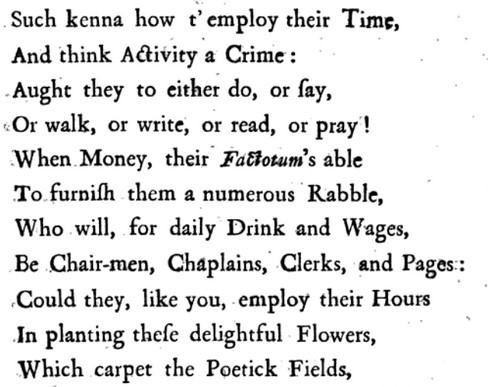
Becomes…
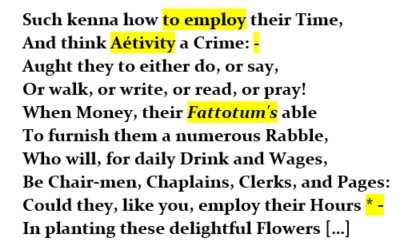
When you consider the fact that most image-to-text functions generate the eighteenth-century ‘s’ as an ‘f’, the above is actually a fairly reliable ‘translation’ when compared with others. Some are completely incoherent, with all sorts of coded-looking nonsense filling out the lines, to say nothing of line structure. Yet, in the above you can see how, for some reason, ‘t’employ’ has been unpacked: ‘to employ’, and, because of the top tail on the ‘t’ in ‘Activity’ and ‘Factotum’s’ we are left with two glaring errors. The other random marks are merely a consequence of the different smudges and blots picked up from the original scan. But it poses the question: is it actually more efficient to just work with a clean page and an original, rather than copying, pasting, and combing for errors, and inevitably missing some? The example above is from p. 280 of Poems II.
But the question of scholarship in the digital age is another matter. For now, we have a clear set of priorities in the Ramsay project with a clear policy to back it up. By treating the first appearance of a poem or song as the most significant helps us thread together a coherent story regarding the movability of Ramsay’s works.
Tomorrow, I’m diving into more collation work. Having obtained digital scans of the Egerton MSS containing Ramsay originals, I’ll be tracking the variants between those and the printed text. Some of the pages are water-damaged, but photoshop helps often makes the pages much more readable (Thank you, Digital Age)!
Until next time, thank you for reading –
CL
Blog 16: 22 August 2019
Good afternoon all and what a summer it has been. After the glorious, warm weather in July we have experienced a fairly wet and windy August. Even so, the Ramsay team haven’t let the dull weather deter us. We have been hard at work throughout the summer collating, debating and gathering. In Blog 13, Craig reflected on some the processes for collating text and I thought I would take the opportunity to reflect on the process for gathering musical sources.
It is no secret that Ramsay lived and worked in a vibrantly active artistic community – his work certainly demonstrates a number of cultural influences. While there is no musical notation in any of Ramsay’s volumes, he meticulously notes which tune his songs should be sung to in The Gentle Shepherd, the Tea-Table Miscellany (hence TTM) volumes I & II and even some of his Poems. To get a sense of what tune Ramsay had in his mind, the team need to build a comprehensive understanding of the music in circulation in Edinburgh during Ramsay’s life. I have built databases for each of his works, which track the circulating history for each song. While this may seem like a difficult and tedious job, one which has never been undertaken for Ramsay’s work, other scholars have laid the groundwork for just such a task.
I am going to use TTM II as an example, since that is the volume I have been working on throughout July. Within TTM II Ramsay sets a song to the tune of ‘Lochaber no more’. The song is still quite popular and many renditions of it appear on YouTube (in fact, here is one that actually attributes the lyrics to Allan Ramsay). But is this the same tune that existed in Ramsay’s day and if so, how far back can we track it and where did it come from? These are the big overarching questions I need to ask when I am looking at the archaeology of a song and while I might not find a specific origin, most of the tunes are traceable to the early eighteenth century.
There are a number of online databases that help with the initial investigation. For example, my first go to site is Charles Gore’s Scottish Music Index. Most of the sources in the databases are from the later 18th and early 19th century, which isn’t the most helpful, but the ‘theme code’ does provide useful hints for a tune that may have an alternative title. Ramsay does have a habit of giving an unexpected title to an otherwise well known tune. One example is in The Gentle Shepherd (1729) where he calls ‘The Yellow Hair’d Laddie’ ‘Winter was cauld and my cleathing was thin’. It isn’t until 1734 he gives the tune its better known name. There are a few reasons why he might have done this: perhaps he was familiar with the alternative title; perhaps he wanted his publication to be a little more unique; or (and by far the trickier concern for the editorial team) he actually had a different tune in mind all along but at some point in history Ramsay’s tune become known as something else – something which we might not be able to find... This is why it is essential to check each and every source and record consistencies and deviations in the music. Gore is just one music database, but there are several others including The Roud Index housed at the Vaughn Williams Library, and the Traditional Tune Archive. More recently, I have been using Evelyn Stell’s Early Scottish Melodies Online, which provides indexes for 17th-century Scottish sources. Her PhD also handily provides indexes for the majority of Scottish music manuscripts created during the 17th and 18th centuries.
Ramsay drew inspiration for his work from all kinds of sources including broadside ballads and the London theatre productions. Broadside ballad indexes such as Broadside Ballads Online, maintained by the Bodleain Library and the English Broadside Ballad Archive maintained by the University of California Santa Barbara have turned up some really interesting finds as well as the Union First Line Index of English Verse and the and the British Library’s English Short Title Catalogue.
Going back to ‘Lochaber no more’, it is notated in several 17th and early 18th century manuscripts and even appears as a tune in John Playford’s The Dancing Master. Its title has varied throughout: it has been known as ‘King James' March to Ireland’, ‘Reeve's Maggot’ and eventually ‘Lochaber’. Frequently, when a tune has a different title there will be subtle differences in its musical shape and structure, but this doesn’t necessarily mean it didn’t originate from the same source. Occasionally, the alternative tune title gives provides more evidence for what Ramsay had in mind, particularly if the title is the same or similar to his. This is why we cannot always rule out alternative titles as different tunes. All of this needs to be tracked, recorded and considered before we even think about how the lyrics fit to the tune (though that is also an essential area of work). In fact, Steve Newman has just written a blog post for Romantic National Song Network where he discusses the wider cultural context influencing Ramsay’s songs.
The work put into creating these open access online databases has made the process of gathering and interrogating sources simpler and quicker. While it is important to use more traditional research methods such as looking at the original sources, scrutinising library catalogues, building a primary source bibliography from books and articles etc. it is also important utilise online databases. Just think how much the scholarly field has changed in the last 10 years as a result of these resources...
BRK
Blog 15: 2 July 2019
Good afternoon all! As we look forward to July we reflect on a very busy June.
In Blog 13 I wrote about the print culture of The Gentle Shepherd and sketched out some of the processes we take on board with the text. Well, I can happily note here that we have now collated both the 1725 and 1729 texts! This is a crucial step in the editorial process, as we now have the raw data, ie. the listed textual variants that chart the journey of the text from its first publication to its evolution into a ballad opera. We have also had another team meeting to discuss the progress of the Edition and make plans for future events. Keep following these blogs for more news!
Just over 18 months in, the project now has a very lively and interconnected dynamic. There are more crossovers now, for example, between the proposed volumes. As Ramsay was fond of recycling and reworking material across several editions, it is only natural that pieces appear time and again in different works and with different contexts. Because of this, the textual and musical research is now becoming more intertwined, with lots of interesting stories regarding Ramsay’s sources for old tunes and ballads coming to the fore.
In other words, the research work is very much in full flow. With work on The Gentle Shepherd at the next stage, the second volume of Poems (which, incidentally, includes The Gentle Shepherd) and The Tea-Table Miscellany (4 vols) are now top priority. I am particularly enjoying working with Ramsay’s Fables and Tales. First published in 1722, some of them appear in the second volume of Poems, adding some lightness and wisdom to break up the longer works.
But as I keep an eye on the website and our extra resources, I am reminded of a poem from the first poetry volume. In ‘Content’ Ramsay explores some thoughts on commemoration:
Thro’ these and other Shrines we wander’d long,
Which merit no Description in my Song:
’Till at the last, methought we cast our Eye
Upon an antique Temple, square and high,
Its Area wide, its Spire did pierce the Sky;
On adamantine Dorick Pillars rear’d,
Strong Gothick Work the massy Pile appear’d:
Nothing seem’d little, all was great design’d,
Which pleas’d the Eye at once, and fill’d the Mind.
Whilst Wonder did my curious Thoughts engage,
To us approach’d a studious rev’rend Sage:
Both Aw and Kindness his grave Aspect bore,
Which spoke him rich with Wisdom’s finest Store.
- Poems (1721), p. 156.
Marked in the Index as a ‘Serious’ poem, Ramsay here reflects on an age of remembrance designed to honour the great and inspire the living. The poem, by the way, went through three editions and was also published in London as a standalone pamphlet before Ramsay’s debut collection was printed in 1721. We can therefore assume that these ideas were formative and central to Ramsay. This makes it all the more fitting that, in our approach to Ramsay’s reception, we have a line to the poet’s own ideas on the topic.
If you’ve been following the updates on our Monuments page you will see a healthy list of Ramsay memorials, mostly in Edinburgh. They are:
- The Ramsay Obelisk (1759) in Penicuik
- (Various) Newhall House & Estate (c. 1810) in Carlops
- The Ramsay Memorial (c. 1820) in Greyfriars Kirkyard, Edinburgh
- Ramsay head on the Scott Monument (c. 1844), Edinburgh
- The Allan Ramsay Monument (1865), Edinburgh
- Ramsay bust in the Wallace Monument (1900)
- Ramsay plasterwork in the Usher Hall (1914)
I have a few more leads I’m following up in and around Ramsay country, so you can expect to read more about these in the near future! In the Objects page you can also see sandstone figures from The Gentle Shepherd, Ramsay postcards, textiles, and Mauchline Ware. Our page on Ramsay Criticism continues to grow as we build our Bibliography, and be sure to check our new Reference & Allusion page, which includes a c. 1823 pamphlet entitled Lucky McKinnon’s Last Advice following Ramsay’s Lucky Spence. Thank you to Dr Rhona Brown for finding this! Quick question, can you come up with a better rhyme for Kinnon than ‘sin in’t’? Have a look at the page here and give it a go!
For the rest of July, then, I’ll be working on these fronts; pushing along as much of the collation work as I can. And if you know of any interesting Ramsayana we don’t have online, please be sure to get in touch. We would love to hear from you!
Thank you for reading.
CL
Blog 14: 31 May 2019
Gae farer up the burn to Habbie’s How
Where a’ the sweets o’ spring an’ simmer grow:
Between twa birks, out o’er a little lin,
The water fa’s and maks a singin’ din:
(Act I, scene ii, The Gentle Shepherd)
Though spring has arrived, it has been a rather dreich month and not at all the beautiful, idyllic pastoral scene Ramsay described in his Gentle Shepherd. Nevertheless, the Ramsay have been hard at work and as we heard in the last blog post Craig has been collating The Gentle Shepherd (1729), and I am going to continue the theme by treating readers to some musical examples from the ballad opera. These were recorded at the Musica Scotica conference, which took place on the 3-5 May 2019.
Musica Scotica is one of the leading annual conferences, which focusses specifically on Scottish music. Dr David McGuinness and I we were delighted to be able to open proceedings with our lecture-recital that addressed many of the editorial and performance practice issues in The Gentle Shepherd. Though many of the conference attendees were aware of Allan Ramsay, they were unaware of the many musical complexities the team are wading through. These have partly been caused by The Gentle Shepherd’s popularity throughout the eighteenth and nineteenth centuries, which inspired several musical editions. Unlike the many editions produced by Ramsay that did not include music notation, later editions such as those produced by John Robertson in 1758 and Andrew Foulis in 1788 combine text and music together perhaps in an attempt to provide clearer performance instructions for musicians. However, as David and I pointed out, Robertson’s 1758 edition often prints instrumental versions of the tune, which span a wide range; the tunes frequently sit too low or two high for an untrained vocalist. We demonstrated this by performing O Mither, What Shall I Do, from the Robertson edition. I have been trained in the Western classical tradition, so the range wasn’t particularly challenging, though the lyrics in the second half of the air are a little more difficult to articulate since the tune jumps to a much higher register.
https://soundcloud.com/user-288928743/peggy
We were aware that after our performance the conference attendees may not have been convinced that the drastic change in register between the first and second half of the air was difficult. So, we challenged them to sing it as well, hammering home the point that a singer without training may not be able to reach the extremities of the range. David did transpose the tune down, so that the second half wasn’t quite so high, but it made the first half of the tune rather low.
https://soundcloud.com/user-288928743/peggy-crowd
The Robertson edition also poses a historical problem, since it was produced in the year of Ramsay’s death and there is no evidence that Ramsay was ever involved in its creation. It tells us very little about the performance practice tradition at the time the ballad opera version of The Gentle Shepherd was performed. This is why (and as I have discussed in previous blogs) we are searching for, analysing and using musical sources in circulation during Ramsay’s day. Of course, sources directly connected to Ramsay and his circle take priority, but these present further musical performance practice issues.
Musick for Allan Ramsay's 71 Scots Songs (1725-6?) created by Alexander Stuart and printed by Allan Ramsay himself, in theory, should provide clear musical instructions for singers and instrumentalists who are keen to perform the airs from The Gentle Shepherd (1729) and the Tea-Table Miscellany (1723). However, once again, much of the printed notation is instrumental in nature. ‘Hap me with thy Pettycoat’ is a perfect example, since the highly ornamented melody line is extremely florid, it leaps across octaves, doesn’t leave space for breathing, and runs of lyrics before the end of the line. Our rendition of this tune as presented in Musick for Allan Ramsay's 71 Scots Songs and can be heard below:
https://soundcloud.com/user-288928743/were-i-assured-youll-constant
However, some of notated tunes are distinctly vocal, particularly the tune ‘By the Delicious Warmness of thy Mouth’, which appears near the end of the book and would appear to be an original composition produced for The Gentle Shepherd. The music notation provides clear markings for placing the lyrics, there is plenty of space to breath, and there is even evidence of word painting in the first line, where the singer moves into a warmer area of the vocal register to sing ‘warmness’. Unfortunately, the tune isn’t particularly memorable, and is a little awkward in places, but compared to the other examples, it sits comfortably within the vocal range as can be heard in the following example:
https://soundcloud.com/user-288928743/by-the-delicious-warmness
Though I have been carrying out extensive investigations into each of these tunes, it was interesting to dig a little deeper into the intricate musical issues through performance. Though the tunes are quite short, they don’t always follow the most intuitive musical path, with each one presenting its own challenges. While I didn’t particularly struggle with the range, my experience was similar to Iona Fyfe who felt it was difficult to convey the story, because she was spending a lot of time navigating the tune itself. If readers would like to know more about Iona’s performance, which was part of the 2018 Allan Ramsay Festival, it was the subject of a previous blog post, which can be found hereand a video of The Allan Ramsay Ceilidh, which took place the same weekend is available to watch here.
In the coming months, we will be inviting other singers from different vocal backgrounds to perform songs from The Gentle Shepherd, which will help us get a better sense of this music. Until then, please follow us on our Twitter @edin_enlighten and continue to follow our monthly blog series.
BRK
Blog 13: 6 May 2019
Good afternoon! Hoping this blog finds you well and rested on this bank holiday Monday.
This time last year I quoted Ramsay’s ‘Elegy on James, Lord Carnegie’, with its reference to ‘sweetest dawns, in May, with clouds.’ The skies overhead might not have changed all that much, but with these blogs we can chart the progress of each new milestone in the project.
Back then, we were looking forward to proposing volumes to EUP, kick-starting the website, and planning for the third Allan Ramsay Festival. The volumes are taking shape nicely, the website is now up, running, and growing fast, and the Festival was once again a great event to meet up and celebrate the life of Ramsay.
In the last blog Brianna reported on the Ramsay panel at The American Society for Eighteenth-Century Studies annual meeting in Denver. This, coming only a few months after our panel at the British Society for Eighteenth-Century Studies conference has helped spread the word about our project and share ideas about our ongoing work. As you can see on our website, we have also taken our research into events in Stirling (Musica Scotia) and Edinburgh (8th European Conference on Alcohol Policy).
These conferences and meetings help us feed new ideas and insights back into our research, and as the project grows in stature we are hoping to showcase even more discoveries and techniques that might paint a more vivid portrait of Ramsay (pun in reference to his son very much intended). We will keep you posted on any upcoming events, lectures, or conferences we plan to attend in good time, and hopefully we can meet some of you there.
Meanwhile on the textual front I’ve now commenced the collation of the 1729 Gentle Shepherd with Steve Newman. Having waded through the manuscript sources of the play, the task now lies with noting the variants across the extant printed editions. This is still a very laborious task but it is markedly simpler in many ways. For instance, a word in Ramsay’s hand (clear as he is) may have some ambiguity (upper/lower case) or might be heavily redacted. In the final printed version these problems do not arise. There are still misprints and printer’s quirks to note (like page number errors), but these are easily slotted into a bibliography and have less bearing on the meaning of the text.
A few basic things about the trajectory of the Gentle Shepherd in print. It was first printed in 1725 in Edinburgh, comprising two earlier works – Patie and Roger (1720) and Jenny and Meggy (1723) – in the first two scenes. A ‘second edition’ was published in 1726, with many minor textual variants which you can track in their entirety when the volume is published. The main addition was the dedicatory poem ‘To the Countess of Eglintoun’ (Accept, O! Eglintoun, thy rural Lays…) by William Hamilton of Bangour (1704–1754). This new edition was reprinted in Dublin in 1727, but the importance of the 1729 Edinburgh edition that we are working on is the inclusion of songs, as footnotes, matching up with the second volume of The Tea-Table Miscellany. In his Bibliography Burns Martin notes that ‘this is the first intimation that Ramsay had converted his pastoral into a ballad opera.’
Alongside this I’m working on the Poems with Rhona Brown, and keeping tabs on some prose items including letters that might help inform the biography of Ramsay. There are many good things about doing these jobs side by side. First of all, it gives you a sense of recurring themes in Ramsay’s oeuvre. For example, the importance of good health (rather than too much wealth) and contentment is mentioned not just throughout the Gentle Shepherd, but also in Ramsay’s earlier works such as Content (1719) and ‘Familiar Epistles’ (c. 1719) sent to William Hamilton of GIlbertfield (c.1665–1751). It is also pleasing to see the simultaneous growth of two volumes of the Edition, and to get an understanding of Ramsay’s productivity and diversity.
All in all, the textual work has been a rewarding, if time-consuming, task – and so it continues. In the coming weeks the Editorial Board and Knowledge Exchange team will be meeting up to review our current work and make new plans. I can tell you now that our plans to host an NLS Treasures Display exhibition on Ramsay will be brought forward, and should be ready in the early months of 2020 (more on this after our meetings).
Thank you for checking in on the project – wishing you well this holiday Monday. Until next time, why not check our website again: we’ve added some more items to the Reception pages including a note on Ramsay in Edinburgh’s Usher Hall.
Thank you!
CL
Blog 12: 23 March 2019
‘From this and the following Volume Mr. Thomson (who is allowed by all to be a good Teacher and Singer of Scots Songs) cull’d his Orpheus Caledonius, the Musick for both the Voice and Flute, and the Words of the Songs finely engraven in a folio Book, for the Use of Persons of the highest Quality in Britain, and dedicated to her Royal Highness, now her Majesty out most gracious Queen. This by the by I thought proper to intimate and my self that Justice which the Publisher neglected; since he ought to have acquainted his Illustrious List of Subscribers, that the most of the Songs were mine, the Musick abstracted’ (Tea-Table Miscellany, 1729: vii-viii).
It has only been a couple of months since the Ramsay team spoke at the annual BSECS conference in Oxford, but we are once again showcasing our work to the eighteenth-century scholarly community, this time at The American Society for Eighteenth-Century Studies annual meeting. ASECS is an interdisciplinary group dedicated to the advancement of scholarship in all aspects of the long eighteenth century and this year’s gathering is taking place at Grand Hyatt Hotel in Denver, Colorado. I was honoured to be asked by Steve Newman, co-editor of The Gentle Shepherd edition if I would like to join him on the Eighteenth-century Scottish Studies Society panel. This was a fantastic opportunity to address both the musical and textual issues we are navigating. While this wasn’t a Ramsay-dedicated panel, the attendees were very excited to hear about the work that is being carried out.
Steve presented a fantastic paper that addressed issues of mediation, well more specifically re-mediation by focussing on the composition and reception history of The Gentle Shepherd. Steve swiftly addressed issues surrounding Ramsay’s assembly of the text in his manuscripts, analysing the way Ramsay presents ideas of “improvement”, which speak to the political struggles of the 1720s. But, he went on to argue, that if we are to understand how the play establishes itself as a narrative of Scottish improvement, we have to turn to the history of its production and reception, starting with the Haddington Grammar School and moving far beyond its time and place, with performances taking place throughout the 18th and 19th centuries in Scotland, London, North America and Australia. Steve directed his attention to a private performance that involved the Linley and Tickell families as well as William Henry Ireland, the well-known Shakespearean forger and also considered the key role played by The Gentle Shepherd in Lydia Maria Child’s “The West Indian Boy,” which places the text within the charged cross-currents of the 19th century United States. Steve has kindly agreed to share his paper, which can be found here.
This discussion neatly complemented my own presentation on The Gentle Shepherd, where I used the tune ‘The Yellow Hair’d Laddie’ as a case study to present several issues we are facing when it comes to editing the music. As discussed in the BSECS meeting blog post, I rather heavy handedly made sure to state the lack of music notation in Ramsay’s manuscript and print editions but provided several examples of early musically notated sources that demonstrate the tune was in circulation during his lifetime. ‘The Yellow Hair’d Laddie’ can be found in its notated form in The Balcarres Lute Book (1700?), and Mrs Crockat’s MS (1709) but neither of these are connected to Ramsay’s circle. Versions of the tune that Ramsay is more likely to have heard appear in Adam Craig’s A Collection of the Choicest Scots Tunes from 1727 and of, course Alexander Stuart’s Musick For Allan Ramsay’s Collection of Scots Songs (1726?) but neither of these contain lyrics. While this might not seem that unusual, I have noticed a recurring trend where music and lyrics are separated in Scottish print and manuscript sources. In fact, one of the only sources from the period that prints music and words together is William Thomson’s Orpheus Caledonius (1725). As we can see in the quote that opens this blog, Ramsay’s pointed remark makes it clear there was no collaboration between the two men. If you would like to read my paper, please find it here.
Despite the popularity of Orpheus Caledonius as well as the regularity with which music and words are printed together in London ballad opera publications such as those by Theophilus Cibber, Joseph Mitchell and John Gay, Ramsay continued to create text-only editions that merely provide an indication of the tune. Alas, Ramsay was not to know the many performance practice issues he would create for performers wanting to mount productions of his ballad opera three centuries later. But that is part of the joy of researching this seminal work and the attendees who came to this panel were keen to hear more about how the edition will speak to the performance community. The discussion moved away from the physical evidence, and onto a much more in-depth consideration of how we flexibly interpret the work. While we might like to think of The Gentle Shepherd publication as a blueprint for performance, that is simply not the case. Improvisation, substitution and negotiation between the text and the performer were much more common than performing the work from beginning to end with little deviation.
This was a fascinating panel to be part of and I was pleased that the discussion was so lively. Many thanks to Steve Newman for the invitation!
BRK
Blog 11: 2 March 2019
He that has just enough, can soundly sleep:
The O’ercome only fashes Fowk to keep.
- The Gentle Shepherd (1725), ll. 47-8
The above is one of my favourite couplets not just from The Gentle Shepherd but from Ramsay’s works more widely. Indeed, a few days after pay day and with the onset of another busy month on the horizon it sometimes helps to take a step back and listen as the sentiments of Ramsay’s age echo into our own. ‘He that has just enough, can soundly sleep.’ That comma, the little pause in the first of the two lines is a call for patience; a wee reminder that to listen well can be rewarding. This opening scene of the opening act of Ramsay’s play is full of such wisdom and advice, offered from a poor but content shepherd to a wealthier but altogether more destitute one, whose soul is ‘sadly out of tune’.
When it was first printed as Patie and Roger in 1720 the comma was not there and the word ‘Fowk’ was printed ‘Fouk.’ These minor variants are like weeds in the garden of Ramsay’s verse, you need to find them and understand their history before you decide what to do with them. Luckily, my job is to simply note their existence: really more an auditor than a gardener. It was next printed, as ‘Patie and Roger’, within Poems (1721), again without the comma. It was not until The Gentle Shepherd was so-titled and first printed that the comma was introduced. Yes, a comma might seem inconsequential, and there are certainly times where a line could benefit without it. But in preparing the collation notes for Steve Newman (editor), I sometimes pause over these quirks and wonder if they might mean more…
Such has been my work over the past month, since January and Burns Season gave way to the brief month of February. Brianna and I have also been putting some plans in motion for The Tea-Table Miscellany under the direction of Murray Pittock (General Editor and editor of TTM). We’ve been locating copies of the four principal volumes which will form the copytext. Looking for them revealed the true extent of the popularity of TTM. Volume 1 was printed in 1723 - with a reprint appearing in 1724 once thought to be the first edition. The rest of the work appeared as follows: volume 2 (1726); 3 (1727); 4 (1737).
There were, however, at least ten separate editions bearing the name The Tea Table Miscellany between 1723 and 1737. Sometimes printed in Edinburgh, sometimes in Dublin or London, these editions were local reprints of the more popular of these four volumes. For instance, the booksellers maybe sold more of volume 2 than volume 3 by 1730, and so they produced more editions of volume 2 only. Sometimes the printers would compete, combining some volumes together and boasting their comprehensive efforts on the title page. This was the case with a Dublin edition of 1729, titled:
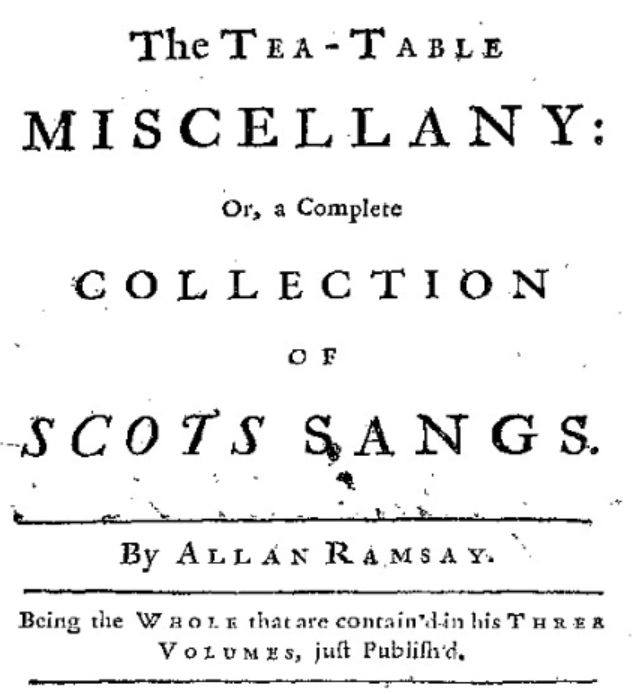
As you can tell, we’ve also made progress with the descriptive bibliography. This has been a natural extension of the work required to comprehend the publication history of the key works we are preparing for Edinburgh University Press. In other words, the natural flow of the project directs the research in several directions at once.
One of the other great things about this past month has been the opportunity to take some of this research into the classroom. The Scottish Literature Honours Course ‘Popular Literary Enlightenment’ examines the ‘widely-circulated Scottish Literature of the eighteenth century (incorporating cheaply-produced literature such as periodicals, pamphlets, chapbooks and broadsides); the motivations for its production; the networks through which it was circulated; and its significance in the wider context of the Scottish Enlightenment.’
Because of his influence on the period we studied Ramsay over the course of four hours. Many Scottish Literature students were first introduced to Ramsay’s work in second year, via works such as ‘Lucky Spence’s Last Advice’ and ‘Elegy on Maggy Johnston.’ In this course, however, I introduced the Honours cohort to the scope of his works and dedicated a separate lesson to The Gentle Shepherd itself.
We even looked at some of the bibliographical quirks in Ramsay’s catalogue and used emerging digital resources (such as those in the NLS) to solve textual problems. I used the 1788 Foulis edition of GS as a case study for the title of the course, and in Dr Ronnie Young’s recent class the students had the chance to see this and other texts from the course in the Library’s Special Collections (thank you, Robert MacLean!)
For the next couple of months I will be finishing off the collation and copytext for The Gentle Shepherd and updating our website. If you missed our tweets, have a look at this pair of sandstone figures and the bust of Ramsay in the Wallace Monument (Stirling). The Editorial Meeting are meeting again at the end of April, but either myself or Brianna will keep you up-to-date in the meantime!
Thank you as always for reading.
CL
Blog 10: 25 January 2019
“There is I know not what of wild happiness of thought and expression peculiarly beautiful in the old Scottish song style, of which his Grace, old venerable Skinner, the author of Tullochgorum, &c., and the late Ross at Lochlee of true Scottish poetic memory, are the only modern instances that I recollect, since Ramsay with his contemporaries, and poor Bob Ferguson, went to the World of deathless existence and truly immortal song.” Robert Burns to James Hoy, 6 November 1787.
Happy Burns night everyone! We hope you don’t mind us stepping into this day of festivities to give you an update on our progress with Burns’s forefather of vernacular poetry. Unlike our previous blogs which tend to be single-authored, Craig and Brianna both reflect on their attendance at a conference recently attended by the Ramsay team.
The Ramsay Team kicked off the year with a trip to St Hugh’s College, Oxford for the British Society for Eighteenth-century Studies (BSECS) conference where we had our very own panel dedicated to The Collected Works of Allan Ramsay. BSECS is Europe’s largest annual international conference dedicated to eighteenth-century studies, making it the perfect platform to present our work.
The panel was chaired by our very own Murray Pittock, who provided a detailed introduction to the project, while Brianna and Craig spoke in depth about the ongoing gathering and editing work currently being undertaken in preparation for the edition of Poems and The Gentle Shepherd.
Brianna will now reflect on her paper and the intriguing questions asked by the eager and engaged attendees:
Though I have spent many months carefully gathering pre-1729 musical sources related to the tunes in The Gentle Shepherd, I cannot ignore the elephant in the room – there is no music notation in any of Ramsay’s editions. In fact, the performance tradition of The Gentle Shepherd might not have lasted as long as it has done without later 18th-century editions such as Robertson 1758 and Foulis 1788 producing music notation alongside the text. In my paper ‘‘Indoor or outdoor? The performance history of Allan Ramsay’s The Gentle Shepherd’ I was careful to point this out, but I wanted to focus on the early performance history in particular. Despite this, questions from the attendees honed in on the later performance tradition where information regarding instrumentation and performance evidence is more explicit. Fortunately, I have also been looking at the reception of The Gentle Shepherd and have found a rich international performance history in America and Australia. It was a delight to hear from a researcher in the audience that this also extends to Jamaica. In the coming months, the Ramsay team will be exploring this lead, which shows a much more international reach of the first Scots ballad opera than what we anticipated.
For Craig, the BSECS panel was a great opportunity to showcase some of the poems he’s been working with and to tease out some of the more complicated issues:
Now that we have been working together for a year on this project it was ideal to talk about the ways in which the poetry is coming together. The title of my talk - ‘The Ravishing images crowd upon me’ - was lifted from the Preface to Ramsay’s first edition of Poems (1721). In it, he talks up the high place of verse over prose, which he finds too limiting. And so I took the delegates through a few examples to showcase Ramsay’s broad range and diversity. I also looked a little at publication history, and at some of the quirks of Ramsay’s manuscripts including the breve above the letter ŭ, seemingly a manuscript tradition he was trying to emulate. I looked also at the stanza variants in Christ’s Kirk on the Green between 1718 and 1720 to underline Ramsay’s use of the Bannatyne MS. I’ve covered some of these issues in the recent BARS Blog, but to talk to these issues with colleagues was very helpful. Most interesting I think was the response to the ways in which Ramsay creates a hybrid Scots over time. He sometimes ramps up, and other times downplays the emphasis of the Scots language depending on the reader. His audiences in London in the 1720s helped explain this, and I was given a few tips about other British poets who sought the approval of their neighbourly poets in the early eighteenth century. After a full calendar year of travelling, gathering, photographing, and transcribing I was encouraged that my foray into the editing process has resonated well with many of our colleagues.
Having already made the trip from Glasgow to Oxford, Craig also made the extra 55 miles to London for a look at the Ramsay manuscripts in the British Library.
Now that we are making real progress with the text and collation of both the Poems and The Gentle Shepherd I spent a day looking at the Egerton manuscripts in the BL. In MS 2023 you can find scores of autograph Ramsay poems. Some of them are in draft form and reveal intriguing details about his writing process, ie. which lines he wanted to cut, which words he wasn’t sure about, etc. There are also several doodles of faces and shapes which break up the text quite nicely. The other major volume, MS 2024, is Ramsay’s formation of The Ever Green, another crucial text in the story of Scots language being echoed through the centuries. Again, Ramsay’s editorial process is on show here, and we see once more his leaning towards an older manuscript culture. The trip back to Glasgow with all this fresh in mind gave me much hope for the next year, and for the progress we can make as a team.
In the meantime Brianna and David McGuinness will continue hunting down and editing the many songs and airs for The Gentle Shepherd and the Tea-Table Miscellany while Craig pushes on with the text for Gentle Shepherd for Steve Newman and the second volume of Ramsay’s Poems for Rhona Brown. They shall be adding to the bibliography and the database of performances as they go, so watch this space for more updates soon!
Blog 9: 9 December 2018
Sighing Shepherds of Hibernia,
Thank ye for your kind Concern a’,
When a fause Report, beguiling,
Prov’d a Draw-back on your smiling;
Dight your Een, and cease your grieving,
ALLAN’s hale, and well, and living…
- ‘To my kind and worthy Friends in Ireland’, Poems 1728, p. 302.
Firstly, my apologies for the delay in rolling out the next of our monthly blogs. This past week I was in Belfast (hence the epigraph) with Dr Rhona Brown, editor of the Poems volume of the upcoming EUP edition, to consult the excellent Ramsay collection in Queen’s University Belfast. I thought it would be better to write a little on this while it was fresh in my mind…
The Ramsay Collection there (MS37) is centred around the books of Andrew Gibson, a New Cumnockian who moved to Belfast with his family in the 1880s. He was a great collector of Robert Burns and Thomas Moore, and his impressive Ramsay collection helped inform his study of our poet: New Light on Allan Ramsay (1927). Divided into five boxes, the collection contains some of the rarest early editions of Ramsay such as The Battel: Or, Morning-Interview (1716) as well as around 200 chapbooks and broadsides from the nineteenth century, many of which chart the legacy of Ramsay in popular literary culture. There are also 38 individual editions of The Gentle Shepherd (from 1727 to the 1891, with some undated), showing once again the immense popularity of Ramsay’s chief work. Consulting these editions, some of which are very rare and often not located in Scotland, has given the ongoing descriptive bibliography a major boost!
Having returned to Glasgow I am quite amazed at how quickly this year has passed by. Looking back on it now it is already very clear that working on an edition at such close quarters gives you a very enjoyable and refreshing sense of a writer and their world. As you will have gathered from this series of blogs we have covered good ground already. We’ve…
- racked up almost all the known manuscript sources in Ramsay’s hand (some transcribed, some photographed)
- launched a project website with maps, photographs, videos, and other resources
- had the Poems volumes approved by EUP and have submitted the exciting proposal for The Gentle Shepherd
- contributed to the publication of a special issue of the Scottish Literary Review on Ramsay
- helped organise the annual Allan Ramsay Festival in Carlops.
- commenced work towards a comprehensive database of the performances of The Gentle Shepherd, a truly global drama
- begun a new descriptive bibliography (mentioned above).
And last but certainly not least, Prof. Murray Pittock’s monograph – Enlightenment in a Smart City: Edinburgh’s Civic Development, 1660-1750 – was published at the beginning of this month. You can buy it here! The research for this book was carried out during the RSE funded project ‘Edinburgh in the First Age of Enlightenment’ and the beginning of our AHRC-funded ‘Collected Works of Allan Ramsay Project’. As you can imagine, Ramsay plays a major part!
As we look toward the end of the year we still have time for one more meeting of the Editorial Board and the Knowledge Exchange Team. With the former we are looking to firm up some of the finer details around Ramsay’s text which have revealed themselves to us throughout the year. Plans with the KE Team to hold events in the forthcoming years are going well, and I look forward to giving you more on that in January. But before I do, we are trooping down to Oxford to take part in the annual British Society for Eighteenth-Century Studies Conference. Our panel will be chaired by the General Editor of the Edition, Prof. Murray Pittock, and will feature talks by Drs. David McGinness, Brianna Robertson-Kirkland and myself. You download the programme here.
After this I’ll be back to the textual editing. Having completed the copytext for the first volume of Ramsay’s Poems for Dr. Rhona Brown I’ve dovetailed my working week to make progress on the second volume of Poems alongside The Gentle Shepherd (for Drs. Steve Newman and David McGuinness). Getting past Poems I, with all its twists and turns and bibliographical headaches, felt quite monumental. I thought there could be no better way to mark this than by making a Word Cloud (worditout.com)… here is the result (the larger the word, the more often it was used in Poems 1721):
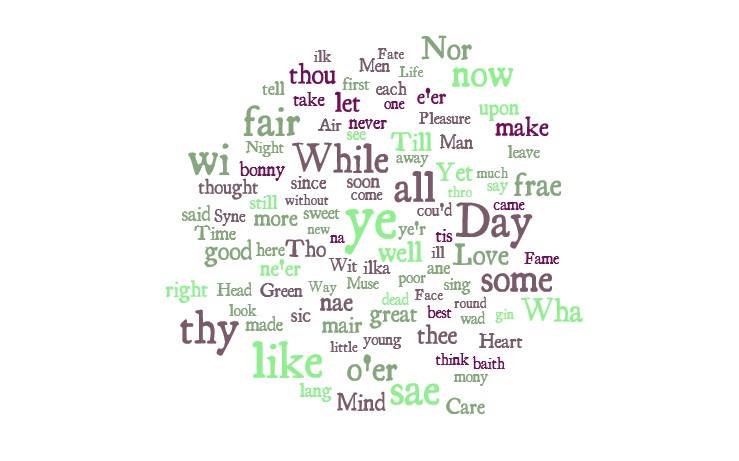
Let me know what you think... Surprised? Pleased? Confused? With so many Scots words in Ramsay’s first authorized edition we can plainly see his influence on subsequent poets.
Thank you very much for continuing to follow our blog! There’s still a few weeks to go, but this has been an amazing year for us on the Ramsay team, and we are immensely grateful for your likes, shares, follows and comments. Looking forward to posting again in the NY… here’s hoping it’s just as braw.
CL
Blog 8: 26 October 2018
This month has been particularly memorable for the Ramsay team as the third annual Allan Ramsay Festival took place at Carlops Village Hall and The Allan Ramsay Hotel on the 12-13 October 2018. This year, the festival focussed on music and what better way to do this than through dancing, and singing all in celebration of Ramsay’s birthday. Dance was important in both country and city life in 18th-century Scotland and even at the end of Ramsay’s The Gentle Shepherd, the final air is performed to the popular dance tune Corn Riggs. In fact, the general purpose of the tunes to which Ramsay set his songs were not confined by any specific genre and instead were used in a variety of ways including genteel airs, rowdy drinking songs, pipe tunes and dance music.
The initial idea was to have the dance as part of the selection of scenes from The Gentle Shepherd, but that wouldn’t quite communicate the versatility of many of the tunes featured in the ballad opera. Instead, we aimed to capture the spirit of an 18th-century evening, perhaps an evening that Ramsay himself would have experienced in his own lifetime. What better way to do this than to host the first Allan Ramsay Ceilidh complete with 18th-century country dances set to tunes from the period!?
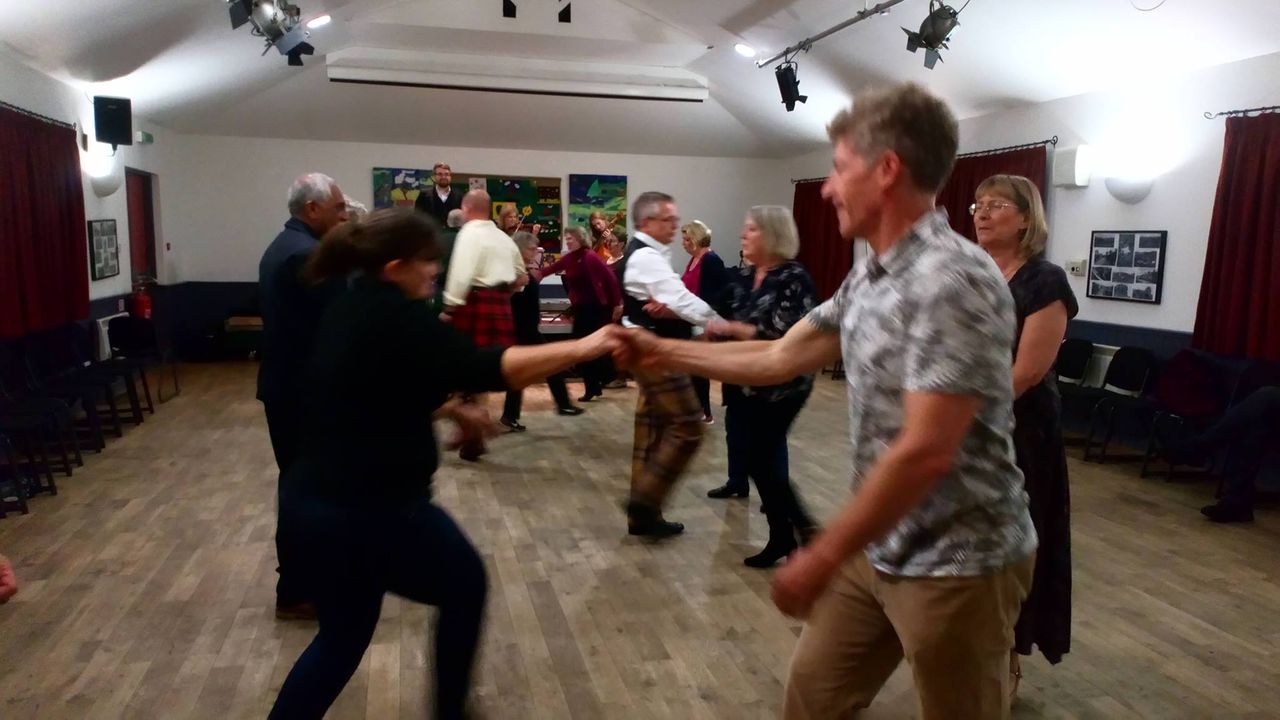
18th-century country dancing isn’t quite like the more rumbustious dances we are likely to encounter in a modern Scottish ceilidh. These dances are much more sedate, allowing partners the time to showcase their ‘stepping and footing’, enjoy brief conversations, and of course take a sip of claret! The figures in some cases are quite foreign even to experienced 21st-century ceilidh dancers and though they take a little more practice, it is quite satisfying to see everyone twirling, setting-off and walking a figure of 8 at precisely the right musical moment.
Concerto Caledonia are particularly skilled at hosting such an event having just completed the Nathanial Gow Dance Band project. Participants were in the safe hands of master caller Aaron McGregor, who expertly walked everyone through each dance. Though some of the dances were a little more complicated than others, The Scotch Measure for example, the beauty of this type of ceilidh is that each person is on the same foot. The video demonstrates the wonderful efforts of our participants, who all put their best foot forward (I apologies for my many dancing puns!).
The annual dinner took place at The Allan Ramsay Hotel the following evening, but we didn’t want to just feature a few songs from The Gentle Shepherd. Instead, we opted to perform selected scenes, complete with musical introductions, staged reading and historically informed singing and playing. The hotel is a beautiful homely setting, and we chose to use the virginals (a square, keyboard instrument sounding similar to a harpsichord instrument) and a violin to better suit a domestic-setting rather than a miniature full-scale theatrical production, which wouldn’t have suited this environment. This is very much in keeping with the adaptability of 18th-century works, which were changed to suit the surroundings in which they were staged.
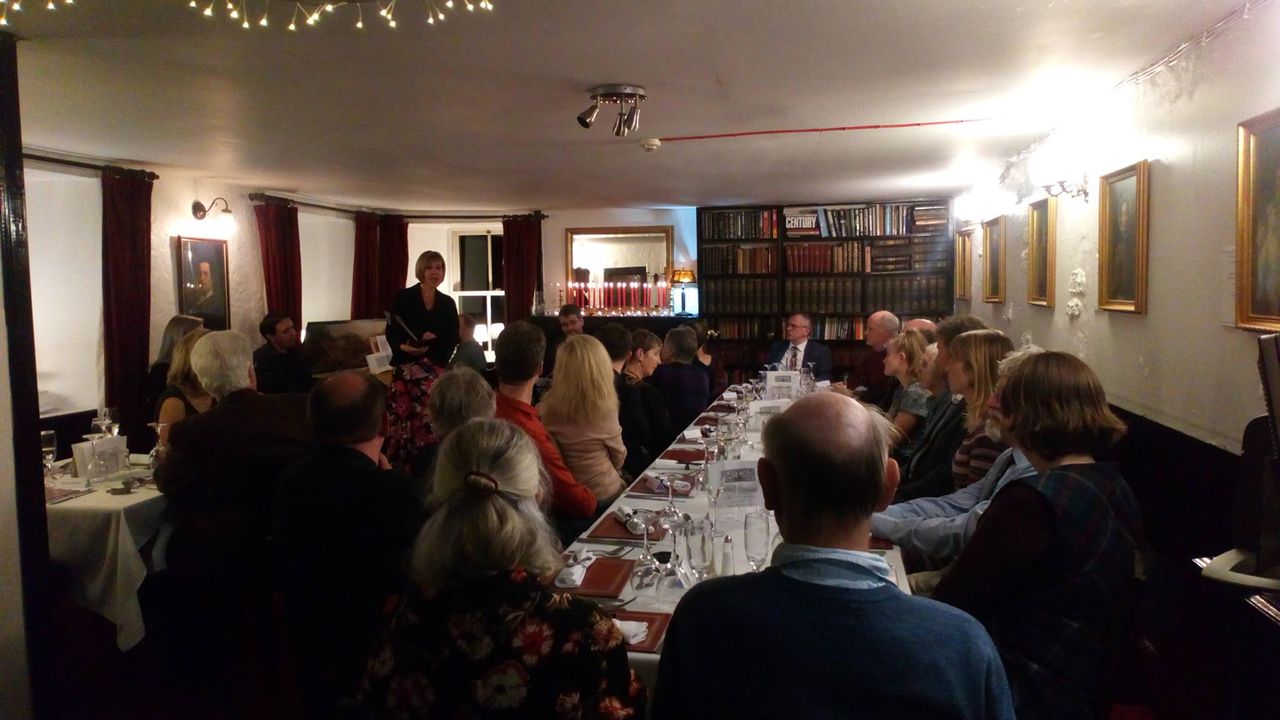
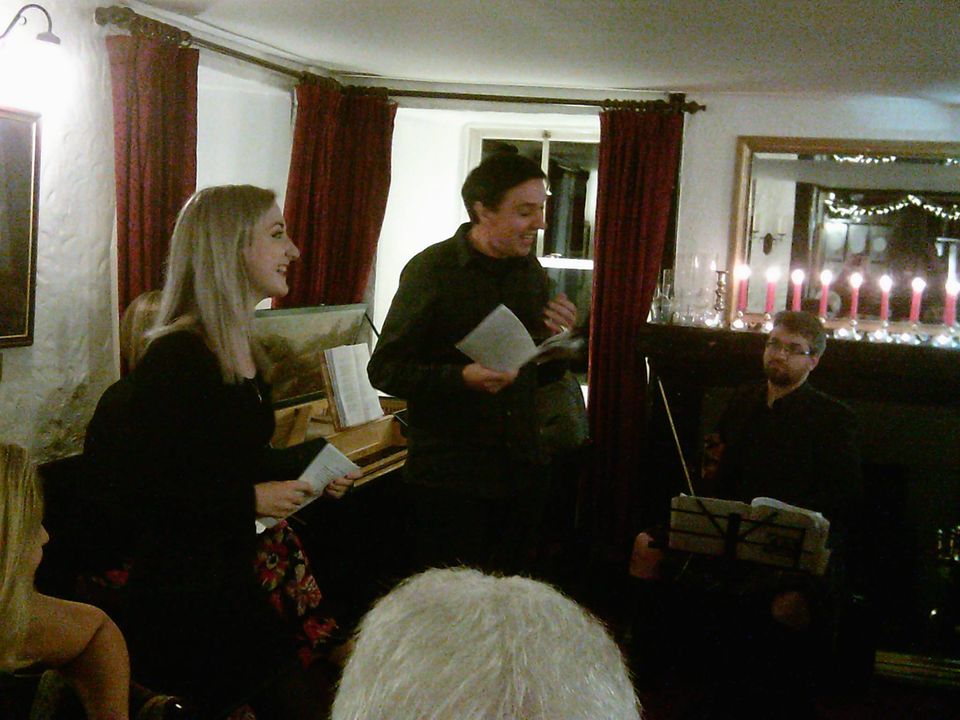
The selected scenes were performed between the dinner courses, but no dinner would be complete without a Toast to Ramsay’s Immortal Memory, which was delivered by our own Professor Murray Pittock. The Allan Ramsay Hotel had even prepared a beautiful croquembouche and last year’s speaker Billy Kay blew out Ramsay’s birthday candles.
Unfortunately, due to illness our Patie who was to be performed by Tom Walker had to withdraw, but we were able to quickly rework the scenes in a way that still gave the audience a basic understanding of the story. For modern singers, these songs are not quite as straight forward as they may appear on paper. Though many of them now belong to the traditional Scottish music genre, the divide between traditional and classical music did not exist in the same way in the 18th century. The tradition in which this music was performed is elusive, and developing a clear idea of how best to approach it can only be done through experimentation. Mhairi Lawson and Tom Walker are experienced early music singers, trained in the Western classical music tradition and they were able to offer insights into technical challenges with both the words and music. We also engaged Aberdeenshire folksinger Iona Fyfe and ballad singer Scott Gardiner, who approached the music in a completely different way, offering further insights into the potential for performance. Further experimentation will need to be done by examining more of the early sources and perhaps considering theories about original pronunciation. However, this performance is the first step on that journey to understanding how the The Gentle Shepherd was performed in the 18th century and why it became such a popular work of international acclaim.
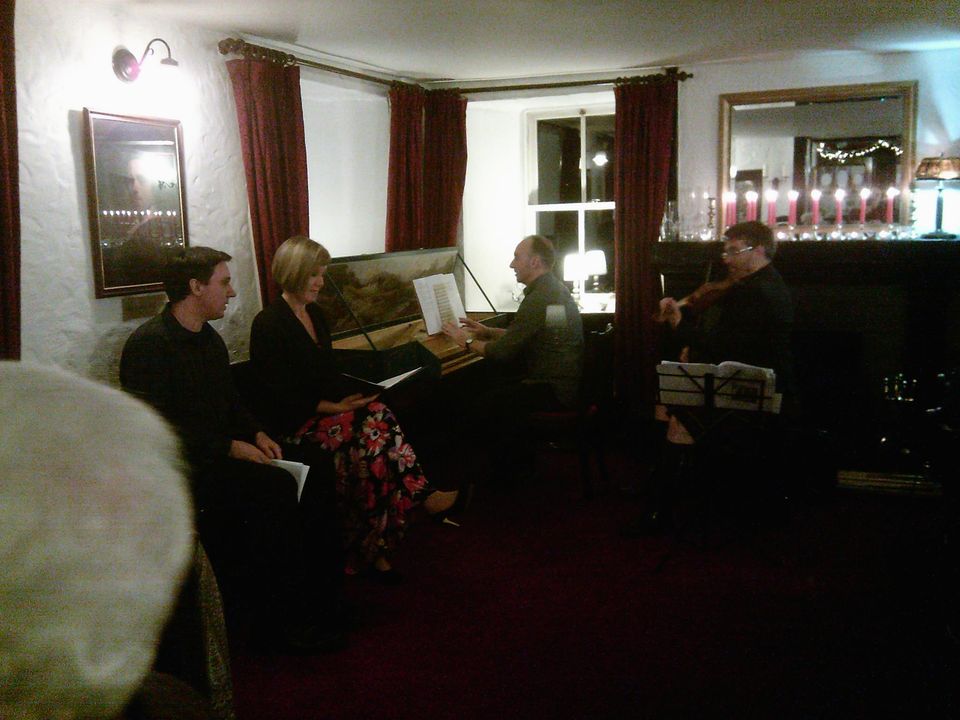
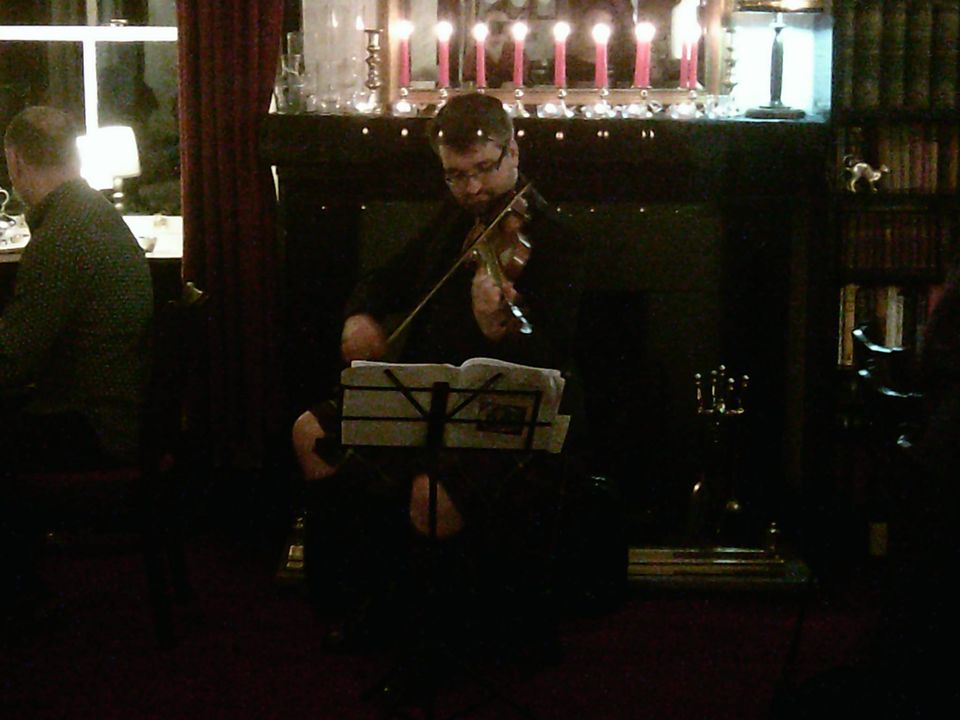
It was a pleasure to work alongside the dedicated team at The Allan Ramsay Hotel and very talented musical artists, who enlivened Ramsay’s work and placed music at the heart of this year’s festival. There are many ideas now brewing for future performances, not to mention the potential for The Allan Ramsay Festival 2019!
Blog 7: 27 September 2018
The University is once again alive with the sound of students and we are hard at work in the Ramsay office. Following on from Craig’s blog last month, today I will be talking more about The Gentle Shepherd’s international performances.
Before I began work on this project, Professor Steve Newman had already compiled a list of many performances taking place in London and throughout North America. The first international performance of The Gentle Shepherd was advertised on the 6th June 1786 in the Daily Advertiser (New York) with the boastful comment it had ‘never [been] performed in America’:
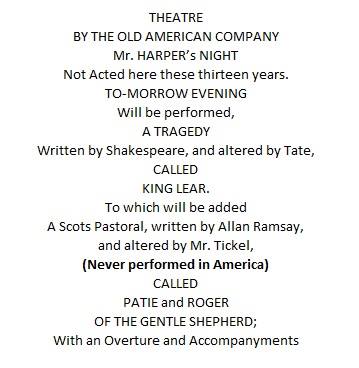
Mr Tickel was no stranger to Ramsay’s work, having already adapted The Gentle Shepherd for the London stage in 1781, shortening it from five acts to two and ‘divesting it of its numerous provincialities, grown almost obsolete, even in Scotland’ (1781: 237). And while in the 21st-century we might be aghast to hear of such a legendary work being so heavily altered, Ramsay himself was unafraid to adapt, change and update the work, which not only created a variety of performance options, but also generated many more book sales.
Ramsay’s first venture into the world of The Gentle Shepherd was in his ecologue Patie and Roger published in 1720, but no songs were included and certainly no overtures or accompaniments. In fact, it wasn’t until 1729, four years after the publication of the five-act play that Ramsay (in imitation of John Gay, who had just gained much success with his ballad opera The Beggar’s Opera) transformed the work into a ballad opera of twenty-one songs set to known Scots tunes. Some eagle eyes may note that the 1786 advert for The Old American Company is for Patie and Roger of the Gentle Shepherd rather the The Gentle Shepherd itself. It is possible that Mr. Tickel had taken Ramsay’s Patie and Roger and simply added the songs much the same way as Ramsay had done to The Gentle Shepherd. But, this doesn’t quite add up since Patie and Roger was a relatively short piece. It is much more likely that this presentation was The Gentle Shepherd, cut down to focus on the two leading male characters.
After this performance in New York, The Gentle Shepherd would make its appearance in Charleston, Philadelphia, and Alexandria (VA). Even as recently as 2016, performances of the ballad opera have taken place in Chicago and Indiana. Though these more recent performances are experimenting with unique voice-types as well as taking a more historically informed performance (HIP) approach, they are sticking with the printed text, rather than updating and compressing Ramsay’s work. This is also a legitimate way to perform Ramsay’s work in the 21s-century, particularly since HIP has become a staple of the classical music world. (Let’s not get into whether The Gentle Shepherd belongs to the classical or folk genre – that is a topic for another day!) Historically, however, it is not the only way.
These North American performances are fascinating, but I was curious about the ballad operas wider international reach. I had spent some time in Sydney, Australia last year and know that a lot of music from Scotland came across with the first wave of British immigrants. Lo and behold, throughout the 19th-century several performances took place throughout Australia. One of the earliest adverts appears in May 1845, but unlike the North American premier, it was an amateur production by ‘Scottish mechanics’ all for the benefit of the local hospital. A few more amateur performances would take place thereafter, until David Kennedy, a Scots musician who toured throughout the British Empire and was best known for his “Burns”, introduced ‘Allan Ramsay's pastoral of The Gentle Shepherd to his ‘Nicht wi Burns’. Kennedy, with the help of his family, would put on several performances of The Gentle Shepherd and music was very much a highlight pf the production. Almost every newspaper advert provided a comprehensive list of the songs. However, even these productions were not exact recreations of Ramsay’s original. Indeed, no two productions contained the same set of songs as can be seen in the 8 October 1872, Ballarat Courier advert and the 18 June 1873 advert appearing in the Sydney Morning Herald.
While I will be carrying out much more research work into the performance history of The Gentle Shepherd, these international performances demonstrate a continued popularity, perhaps made possible because the potentials for performance were relatively fluid. We will be experimenting with this very idea when scenes from The Gentle Shepherd are performed at The Allan Ramsay Dinner on the 13 October at The Allan Ramsay Hotel, Carlops. Further details about the event can be found on our event page: https://www.facebook.com/events/298467077606794/.
BRK
Blog 6: 31 August 2018
We hope you didn’t miss the Blog too much in July, but we’re back! This is the sixth in the series, and today I’ll be updating you on the progress of the Poems before looking a bit closer at our research on the performances of The Gentle Shepherd.
As Brianna stacks up an increasing list of musical sources for Ramsay’s songs, I’ve been digging my way through the first authorised edition of Poems (1721). Creating the copytext for this has been quite intriguing: you get a real sense of Ruddiman’s printing style. Yes, his line numbers gang aft agley (see below), but his ornaments and his attention to Ramsay’s diverse rhyme patterns makes the job of creating a copytext very smooth indeed.
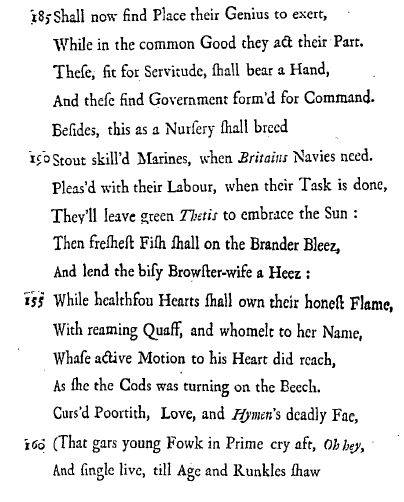
I tend to work with copytext and collation in step. As soon as I’ve finished a section of the text I’ll do the collation, move on, and repeat. This way I’m not burning through the whole text at speed only to go back to the beginning and collate when it’s no longer as fresh in my mind. I’ll hopefully deploy the same routine for the next volume of Poems (1728) and The Gentle Shepherd.
Prof Steve Newman will be editing the GS, and he’s been doing an enormous amount of work on the various versions of what becomes, of course, Ramsay’s most celebrated piece. As we proceed with this and the collation work is fully underway we will look at the text in more detail. Until then, the GS has been more or less leading the charge in our Reception work. As you will remember, we are populating the Ramsay website with as many examples of the performative, visual, critical, and built legacy of Ramsay and his work. It is no secret that the legacy of the GS became synonymous with Ramsay the poet in the nineteenth century. The memorial stone to Ramsay in Greyfriars Kirkyard is a perfect example of this.
In this Cemetery
Was Interred the Mortal Part
of an Immortal Poet.
ALLAN RAMSAY.
Author of THE GENTLE SHEPHERD.
And so it goes… his chief dramatic work becomes the chief mnemonic handle on his entire career. To understand why this is we decided to make a list of all the performances of the play we could find. Steve sent over a list of around 100 adverts and playbills from the UK and the USA to get us started. Before long I was chasing down some ephemeral material about more recent performances, such as the 1949 production for the Edinburgh International Festival, and the 1962 production in the Citizens’ Theatre (featuring none other than Prof Kirsteen McCue’s talented father, the well kent Bill McCue)!
It soon became clear that we needed more than just a list. What we are doing now is building a database of the performances of The Gentle Shepherd globally, effectively creating a map of the reception of the play around the world. We will keep you informed as to when this will become available; we are in the early phases of the work at the moment. Even now the database is sitting at over 200 noted performances, and we know there are many more to find. One of the intriguing ideas coming out of this research is that the play, originating in Edinburgh and more or less enshrined in the countryside surrounding the capital, has been performed more often in London than anywhere else.
Ramsay’s early poems tell us that he found a ready network of London-based writers and publishers keen to share his work (both in Scots and in English), but we are beginning to see that throughout the second half of the 18th century (Ramsay died in 1758) the GS was performed at least once most years in London. In 1782 alone there are at least 20 performances in Drury Lane and the Haymarket. Often as an afterpiece to some Shakespeare, the play went through an evolution. If we look at March of 1782, the advertisements tell us that it was performed ‘in its original state, as it was written by Allen [sic] Ramsay in 1724.’ In April the staging and the costume changed and an entirely new cast was in place by October. In later years the play was adapted further still, until eventually (as in 1817), it was advertised ‘rendered into English, and cut into 2 acts.’
Going back to the beginning… the play was first performed on 22 January 1729, in Tailor’s Hall, Cowgate, Edinburgh.
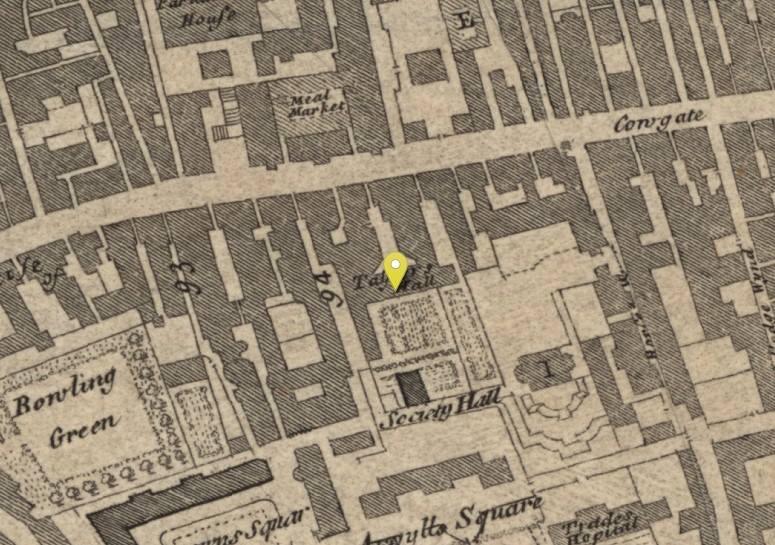
Even then, adaptations of Shakespeare, Steele, and Addison provided a large bulk of the entertainment. The GS was part of the theatrical cultural in Tailor’s Hall as late as November 1756. Following Ramsay’s death the play was performed across Edinburgh, mostly in the Theatre Royal in Princes Street, in the New Town which Ramsay didn’t live to see for himself.
I am sure we could ponder more on Ramsay’s influence on Edinburgh. We could ‘Let fouth o’ tears dreep like May-dew’ but for now the show (read: work) must go on, and there is plenty more to see (and do).
Thanks for reading blog number six. Next month Brianna will be taking us through some of the international performances to give us a sense of how the GS was received overseas.
Until then –
CL
Blog 5: 29 June 2018
Let’s start at the very beginning…
First of all, I would like to say hello to all avid readers of this blog series and many thanks to Dr Craig Lamont for inviting me to contribute. I am primarily examining musical issues related to The Gentle Shepherd and the Tea-Table Miscellany and though I have only been working on this project for a few short months, the research has already taken me down some very windy, though intriguing paths.
Since April, when I joined the team, I have been focusing on The Gentle Shepherd – a wonderful pastoral comedy centring on love, heritage, hierarchy and the virtues of simple nature over artificiality. These were popular eighteenth and nineteenth-century themes that continued to feature in comedies, ballad operas and operettas for almost two centuries. Just a few weeks ago, Dr David McGuinness and I took a day-trip to the Newhall Estate, which is said to have been the main inspiration for The Gentle Shepherd. We were fortunate to arrive just as the sun was peeping out behind the clouds and were amazed by the beautiful woodland area, particularly as we approached the affectionately known ‘Peggy’s Pool’ (no doubt, a direct reference to The Gentle Shepherd). On a sunny day, one could easily imagine Ramsay dreaming up his pastoral comedy as he followed the path next to the river or ‘lay amang the gowans’.
But getting back the music… The relationship between The Gentle Shepherd and its music is not exactly straight forward. In Ramsay’s 1724 manuscript and 1725 print, there are references to songs being sung including ‘Mause sings PEGGY, now the King’s come’, a duet between leading lovers Patie and Peggy, Bauldy’s song (which is complicated for other reasons, but I might get to that in a future blog post), and a final number to close the comedy sung to the tune of ‘The Corn-Riggs are Bonny’. For three out of the four ‘songs’ there is no indication of what tune these should be sung to and there doesn’t appear to be any notated music in print or manuscript that directly relates to these early editions. However, in 1729 an additional 18 songs appeared (though oddly enough Bauldy’s song is not in Ramsay’s ‘Sang’ count).
The way the songs are described in the 1729 edition is odd. They do not neatly appear in text as they would in later print editions. Instead, Ramsay printed asterisks at the end of a spoken line of text with a note at the bottom of the page as to where the song should be sung or if the song should replace the spoken text. But, the actual lyrics for the song and the tune designation for the 1729 edition can only be found in Ramsay’s Tea-Table Miscellany. Basically, if anyone wanted to perform or indeed read the entirety of The Gentle Shepherd, song lyrics and all, one would need two separate books. While I can appreciate the effort, Ramsay has gone to in making the placement of the songs in 1729 version of The Gentle Shepherd as clear as possible, he seems to be merging his old idea of producing a play with a couple of songs with his new idea of a full-blown ballad opera. Needless to say, by his 1734 edition the lyrics are printed in The Gentle Shepherd text at the correct point and Ramsay’s asterisks system is abandoned.
Though Ramsay designated the tune to be used (except for Bauldy’s song and the lover’s duet), musical notation is completely absent from all editions until 1758. This further complicates matters as Ramsay was not involved in the production of this later edition and it isn’t clear where the musical notation has come from. There are numerous musical sources contemporary with the 1729/34 editions of The Gentle Shepherd including William Thomson’s Orpheus Caledonius (1733), and musical notation for some of the tunes listed in The Gentle Shepherd appear in London ballad operas including Patie and Peggy by Theophilus Cibber and The Highland Fair by Joseph Mitchel. These provide useful starting points in identifying what tune Ramsay may have had in mind for his production. These can also tell us about the use of music in the performance of The Gentle Shepherd at its inception and development throughout the 1729-34 period. In the coming months, I will be exploring these sources to help us unravel some of these complexities.
BRK
Blog 4: 30 May 2018
My muses, who on smooth meand’ring Tweed,
Stray through the Groves, or grace the Clover Mead;
Or these who bathe themselves where haughty Clyde
Does roaring o’er his lofty Cat’racts ride;
Or you who on the Banks of gentle Tay
Drain from the Flowers the early Dews of May…
- From ‘Tartana, or the Plaid’, Poems (1721), p. 41
Hello Ramsay fowk! I am squeezing this, the fourth blog of the Ramsay project, into the end of what has been a memorable month for its glorious sunshine! As ever I am happy to report on more progress the team are making on all fronts as we enter our sixth month on the job.
With a large number of manuscripts now ‘in the bag’ (consulted/ digitised) I have been working primarily on the text of what will be the first volume of the new Edinburgh University Press Collected Works of Allan Ramsay. And what do you think the first volume will be? You guessed it… Poems! And after that… more poems!
Producing copytext for Ramsay’s Poems (1721; 1728; uncollected) is a very large task indeed and you’d be forgiven for failing to see the benefit in the laborious task of text creation. But in all honesty, the opportunity to work this closely with Ramsay’s poems in a straightforward and chronological manner, without the clouds of critical opinion, has given me a new sense of his reach and diversity as well as his skill as a poet. And this is after years of teaching Ramsay to Level 2 Scottish Literature students here at the University of Glasgow.
The 400-page tome that is Ramsay’s debut authorised collection of Poems might take time and graft to get through (it’s almost double the length of Burns’s first book!), but it has already renewed my appreciation of his work. Take ‘Tartana’, for example, from which this blog begins. This work is often placed squarely in the political context of Ramsay’s oeuvre, and rightly so. Amidst a classical frame of reference Ramsay defends his nation’s threatened language (But know each Fair who shall this Sur-tout use / You’re no more Scots, and cease to be my Muse) and dress (‘lin’d with Green Stuarta’s Plaid we view, / Or thine Ramseia edg’d around with Blue). It also offers topography (as above) and the seeds of his early Romantic writing.
Beyond meaning, the collation of such a long poem helps establish the print culture of Ramsay’s early works. Between the first printing of Tartana in 1718, the ‘second edition’ in 1719, and the version found in Poems (1721) there are hundreds of variants to record. For example, the spelling of ‘romantick’ (1718) is changed to ‘romantic’ (1719) and back again (1721). In the 1718 edition ‘shepherds’ is printed as ‘sheepherds.’ There are many more examples which I am working through with Dr. Rhona Brown, editor of the Poems. But one more while we’re at it: ‘Purpur’ (1718) becomes ‘purpure’ (1719) before it becomes ‘Purple’ (1721)! The many colours of the Plaid are of astronomical importance to Ramsay: ‘Let Newton’s Royal Club through Prisms stare, / To view Celestial Dyes with curious Care’ (ll. 200-1). On that note, be sure to distinguish your ancient from your modern Ramsay!
Outside the text, we are working towards an Allan Ramsay Edinburgh Heritage Trail 2.0, with more markers to include the poet’s son, Allan Ramsay (1713-1784) the artist. The first trail was kindly taken up by History Scotland (you can see it on their website here) and will feature in the September/October issue of their magazine—just in time for Ramsay’s birthday! Speaking of periodicals… the special issue of the Scottish Literary Review on all things Ramsay is almost upon us. I’ll let you all know through Facebook and Twitter as soon as it’s out.
As I mentioned before, this year’s Allan Ramsay Festival in Carlops will be a musical affair, with Dr Brianna Robertson-Kirkland taking the lead. Plans for this are progressing smoothly as ever with our friends at the Allan Ramsay Hotel. In fact, the next blog will be written by Dr Robertson-Kirkland herself. This will give us a fresh insight into the musical research driving the project, with a particular focus on The Gentle Shepherd.
In the middle of next month the Editorial Board will meet again, and we can gladly share some of the outcomes with you then. Meanwhile, it’s back to the text and the website for me. Keep an eye on the social media channels for updates: more features on the Reception part of our website are coming in the next couple of weeks!
Thanks for reading blog number four, signing off for now—
CL
Blog 3: 3 May 2018
Sae roses wither in their buds,
Kill’d by an eastern blast;
And sweetest dawns, in May, with clouds
and storms are soon o’ercast.
- From ‘An Elegy on James, Lord Carnegie’, I:257 of The Works… (1853)
Good afternoon everyone. I hope you can forgive the persistent overcast theme of the epigraphs to these blogs... I cannot help but mourn for those few hours of spring I’ve seen this year! This third blog for the project will focus on the new work being done behind the scenes and online.
Since the last blog, both the Editorial and Knowledge Exchange Boards have met, paving the way for the next steps of the project overall. On the 26th of April the Editorial team firmed up plans for the proposals of the first volumes of the Edinburgh Edition of Ramsay, beginning with Poems (editor: Dr Rhona Brown). On this I am also happy to report that I have been working closely with the manuscripts in the National Records of Scotland, Edinburgh, and transcribing Ramsay’s poems for the editorial process. So closely, in fact, that much of the ‘gathering’ stage of the collation work with manuscripts, in the Scottish libraries at least, is now done!
This meeting also saw the introduction of our new Music Research Associate on the project, Dr Brianna E Robertson-Kirkland. She has made a running start with her research into Ramsay’s songs, and will be working closely with Prof Steve Newman and Dr David McGuinness on The Gentle Shepherd and Ramsay’s wider musical context.
While work on the text and the music goes on, I have been populating the website with new material. In the Bibliography page you will now find a sample of the ongoing descriptive bibliography of editions printed in Ramsay’s lifetime. As you will see, this method takes into account many of the small details which help us identify printing methods, textual variants, and the nuances of book culture in Ramsay’s period. On this page is the extensive (and growing) secondary bibliography, which we will add to as the project grows.
The Reception area of the website is fast becoming a useful resource in its own right. Divided into four sections you can now navigate the afterlife, or legacy, of Ramsay to gain an understanding of how we have come to view him. In monuments are photos of the Ramsay monument (1865) by John Steell, and in objects you can peruse all twelve of David Allan’s aquatint engravings that were published with the Foulis edition of The Gentle Shepherd of 1788. In performances the aim is to showcase a new performance of Ramsay’s play each month- time permitting- beginning here with the 1962 Gentle Shepherd at the Citizens’ Theatre in Glasgow. [There’s a family connection in here worth exploring!] Thanks to the scoping work of Prof Newman, we already have quite a long list of known GS performances around the world! Likewise with criticism, we will occasionally feature a new book or article that changed the course of Ramsay’s reception over the centuries.
On 1 May the first Knowledge Exchange Meeting for the project was held. Dr Ralph McLean (National Library of Scotland); Dr Lucinda Lax (Scottish National Portrait Gallery); and Dr Jennifer Melville (National Trust for Scotland) shared their initial plans for public engagement events over the coming years.
For example, to coincide with the tercentenary of the publication of Ramsay’s first book of Poems (1721) in 2021, the NLS will host a 3-month exhibition featuring printed material, manuscripts, artwork, and interactive online components. At the Scottish National Portrait Gallery there are plans to cast eighteenth-century Scottish artists in a new global context. This will see Allan Ramsay junior displayed alongside artists such as Sir Henry Raeburn and Gavin Hamilton. Meanwhile, the NTS are making progress in their development of Gladstone’s Land (Lawnmarket) and The Georgian House (Charlotte Square). These Edinburgh properties are entwined with Ramsay’s story, and the Enlightenment-era world of Scotland’s capital. Together they represent a strong opportunity to promote the culture of the period to the public. I look forward to sharing more news on these fronts when plans are firmed up in the near future.
The third Allan Ramsay Festival will take place once more at the Allan Ramsay Hotel in Carlops, likely on the 12th to 13th October this year. The theme this year will be Ramsay’s music. Dr Robertson-Kirkland, who will be co-ordinating the music, is planning to write a blog for the project in the coming months and will give you much more info on this than I can just now. Very much looking forward to reading that myself, and it also means you won’t have to put up with me all the time!
In other news History Scotland are kindly featuring our Ramsay Edinburgh Heritage Trail, which you can view here. Also, Lynne Robertson (Senior Education Officer at Education Scotland) has kindly advertised links to our website and resources in her newsletter, which we hope will help bring Ramsay’s work into classrooms across the country.
Plenty going on and a long way to go yet! Thank you very much for reading and I hope you found these updates useful.
Until next time, all best—
CL
Blog 2: 3 April 2018
In April when Primroses paint the sweet Plain,
and Summer approaching rejoiceth the Swain,
The Yellow-hair’d Laddie would oftentimes go
To Wilds and deep Glens where the Hawthorn-trees grow.
- From ‘The Yellow-Hair’d Laddie’, p. 67 of Poems (1721)
Good evening! Well, far from the sweet approach of summer which Ramsay enjoyed in April, the snow storm from Blog #1 is echoing well into the Spring here in 2018. April 3rd and yet more snowfall across Scotland! Thankfully travel plans have not been too affected, and I’m happy to report on some more good progress with the project.
*Just a reminder, if you’d like the basic aims and intended outcomes of this AHRC-funded project, please check our website, here.*
A huge thank you to all the new follows, retweets, and likes on social media. The first blog post reached 1,240 people on Facebook and 1,535 on Twitter. It is great to see how Ramsay’s name is being cast wider on the web.
This brings me to mention the new accolades at the ever-bustling Allan Ramsay Hotel in Carlops. The external of the old inn is now emblazoned with a plaque from The Green Tourism Business Scheme (Ramsay would be proud) along with the very nice Historic Environment Scotland plaque declaring Ramsay as the ‘Founding Father of Scottish Romanticism & Modern Scottish Poetry | Author of the Pastoral Drama ‘The Gentle Shepherd’ Set Near This Place’ (words by Prof Murray Pittock).
All ticking along nicely as we look forward to the next Allan Ramsay Festival there in October. Hopefully the snow will have cleared by then! The good folks at the Hotel even got a mention as one of Britain’s favourite pubs on BBC Radio 2 during the Vanessa Feltz show on 20 March. Click here to listen to the full list…
In other news, Professor Pittock’s monograph ‘Smart City of Edinburgh: Routing Enlightenment 1660-1750’ is now finished and in the hands of Edinburgh University Press. This book, linked to the initial RSE-funded project on Ramsay’s early-Enlightenment world will be a major boost to the scholarship of the period, and an excellent map of the terrain throughout the course of our work on the new Edition.
Since the last blog I’ve been consulting many more of the Ramsay manuscripts across the nation. I was just about settled with the material in the National Library of Scotland so I’ve widened my Edinburgh net to include the excellent resources in the Centre for Research Collections at the University of Edinburgh. I am grateful to the staff there, and a special thanks to Dr. Joe Marshall for the continuous support offered to the project. Across town at the Scottish Records Office I’ve also been looking at more Ramsay letters, piecing together an interesting epistolary relationship he struck up with Dr. Alexander Cunninghame in the 1730s and 40s.
But there is more, much more spread out across different institutions. My first trip to England for the project took me to Oxford to take a fresh transcription of the Ramsay letter in Worcester College Library. The beautiful space is a sight to behold: click here for an incredible virtual tour. There was an odd sense of symmetry as the very accommodating librarian Mark Bainbridge showed me the note dated 15 February 1960 from Alexander Law (of the STS Edition of Ramsay) in Glasgow to the then-librarian Richard Sayce concerning the same letter. Now back in the flow at home, I am planning to consult more of the Edinburgh-based material before heading to London, where many of Ramsay’s autograph poems are kept in the British Library.
By this stage I am fairly used to Ramsay’s hand and I am very grateful that it is clear and easy to follow. Those of us who have read the correspondence between Robert Burns and Frances Dunlop know first-hand how some eighteenth-century hands can be tricky to read (clue: it wasn’t Burns!) Mind you, it helps to have so many digital tools at our disposal. The wonders of the digital age are to be found in the preservation and sharing of knowledge at the core of our research. In fact, digital facsimiles are being sent now from curators in the Huntington Library: this is one of the main advantages we have over the previous generation of editors.
The team will be meeting up at the end of the month, after which point I’ll be back on here to give you an update on all things Ramsay, and introduce you to some of the new faces in our project team…
All best and thanks for reading,
CL
Blog 1: 28 February 2018
He causes stop each Cranny in his Room,
And heaps on Cloaths, to save him from the Rheum:
Free Air he dreads as his most dangerous Foe,
And trembles at the Sight of Ice or Snow.
- From ‘Health: a Poem’, p. 21 of Poems (1728)
Good afternoon followers of the Ramsay project and welcome to the first of many updates. If you’re anything like me, you’ll be working from home today looking out as the snow blankets over the familiar view from your window. Ramsay’s lines from ‘Health’ seem more appropriate than ever!
*Before we go on, if you’d like the basic aims and intended outcomes of this AHRC-funded project, please check out our new website, here.*
Following our first editorial meeting in January we have been making progress on many fronts. The first point of call was to get the project online and we are very grateful to the followers we’ve built up on both Facebook and Twitter so far (please share widely)! Meanwhile, the editors of the respective volumes of the forthcoming Collected Works of Allan Ramsay (Edinburgh University Press) have been getting to grips with the material they need.
For any given poem we often have various sources: the original manuscript, the poem itself as it was printed in the volume of his Poems (usually 1721 or 1728), or, in some cases, as a broadside or chapbook, sold much cheaper as a single sheet or pamphlet by the hawkers on Edinburgh’s streets. Often there are several variants to take into account.
It is important to know from the beginning that Ramsay was not just the man behind The Gentle Shepherd. In fact, he was more than a writer, he was a sociable entrepreneur in Edinburgh’s early Enlightenment, pioneering many new ventures in theatre and bookselling. You can see his activities and friendships for yourself in this interactive map of eighteenth-century Edinburgh, created during an earlier project, funded by the Royal Society of Edinburgh (PI: Prof Murray Pittock).
That Ramsay was a bookseller as well as a poet means he often printed his own works. This might have made the editorial work a bit easier, but as Ramsay gained a name for himself up and down the country other printers began selling his poetry without permission. While there is some evidence regarding Ramsay’s attempt to intervene with this, it gives the editors pause. With the presence of convincing pirated texts, decisions on which version to use creates the need for more scrutiny.
This is where manuscripts come in so useful. Spread across the British Isles and the United States of America, the locations of Ramsay’s manuscripts give us the first sense of his global significance. Most, however, are held in the National Library of Scotland (NLS), Edinburgh. As a Research Associate on the project, this has been my starting point. I’ve been gathering up as much information as possible using the excellent facilities at the NLS, where many of our friends and colleagues themselves are based.
Barely two months into the job and we have seen hundreds of pages of manuscript material, and hundreds more of printed text produced with Ramsay’s approval. This is the type of work that helps us move forward as a team and work on the forthcoming Works. In future blogs we will look to share some specific items of interest.
In the meantime we are beginning to archive some material relating to the reception of Ramsay such as the artworks that were inspired by his poetry or the new interpretations of his play The Gentle Shepherd in the many performances of it following Ramsay’s death in 1758.
This same territory leads us to consider the legacy of his son, the famous portrait painter of the same name (1713-1784), whose portrait of Charles Edward Stuart (1745) brings us to the Jacobite world to which both father and son were very well connected. Click here for more information as the project develops.
Yesterday, General Editor Prof. Murray Pittock gave a free talk at the Scottish National Gallery on ‘Art and the Jacobites in Scotland and Italy’. This is one of many project-related outputs that will showcase the work involved in the Ramsay project and the wider field of eighteenth century studies. The talk focussed on the works in the collection of the National Galleries, offering a view into artistic development in Edinburgh and the influence of Rome, home to the Stuart Court from 1719. For future talks and events please keep following us on social media, where we will do our best to give you as much notice as possible.
The team are due to meet again in April to discuss our next steps. Shortly afterwards I’ll blog again (if not before), letting you know how we’re getting on and what new material we’ve been working with.
All best and stay safe in the snaw,
CL


